BOLZANO BOZEN
with APPIANO / EPPAN
LAIVES / LEIFERS
RENON / RITTEN
SAN GENESIO / JENESIEN
VAL SARENTINO / SARNTAL
Kurze Wege
Chilometro zero
Reducing food miles
Fiori (a tavola) Blumiges ringsum

Spring in the City
Made for kids
Kinderfreundliche Stadt A misura di bambino
bm
MAGAZINE NR. 1 | 2023 PRIMAVERA / FR Ü H LGNI / GNIRPS \

Sich wohl fühlen, immer. Sentirsi bene, sempre. sparkasse.it Werbemitteilung | Messaggio pubblicitario
GENTILI lettrici e cari lettori, è per me un grande piacere porgere questo messaggio primaverile in una stagione particolarmente cara a Bolzano: con la fioritura, con il ritorno di eventi classici e l’introduzione di eventi nuovi, la vita in città che si risveglia con energie volte allo sviluppo turistico e non solo… Questo è il motivo per cui abbiamo cercato di dare un nuovo impulso al turismo aprendo un secondo Infopoint, lo facciamo in una delle piazze più belle e frequentate del centro, la storica piazza del Grano. L’Infopoint è allestito con tutti i servizi offerti nella sede principale: consulenza professionale, materiale, ricerca alberghiera, organizzazione di guide, tutto ciò che rende la visita a Bolzano indimenticabile. È un impegno e uno sforzo aggiuntivo per regalare qualità ai nostri ospiti, sempre più internazionali.
Per apprendere ciò che accadrà nei prossimi mesi, rimando alla lettura delle pagine bm a seguire, rese ancora più varie e interessanti dall’acquisizione di un nuovo partner, la vicina città di Laives. Buona lettura!
LIEBE Leserinnen und Leser, es ist mir eine große Freude, meine Botschaft an eine Jahreszeit zu verknüpfen, die Bozen ganz besonders am Herzen liegt: Mit dem Aufblühen, mit der Rückkehr klassischer und der Einführung neuer Veranstaltungen erwacht das Leben in der Stadt neu. Es sind Energien mit im Spiel, die der Entwicklung des Tourismus guttun und von Weitblick zeugen. Das ist mit ein Grund, warum wir mit der Eröffnung eines zweiten Infopoints der Bozner Gastfreundschaft einen neuen Impuls geben; wir tun dies an einem der schönsten und belebtesten Plätze des Zentrums, auf dem historischen Kornplatz. Dieser neue Infopoint bietet sämtliche Dienstleistungen an, die auch das Hauptbüro auszeichnen: professionelle Beratung, Vielfalt an Unterlagen und Drucksorten, Hotelrecherche, Organisation von Führungen. Unser Ziel ist es, Ihren Besuch in Bozen unvergesslich zu machen, indem wir uns zu Qualität in der Gästebetreuung verpflichten. Um zu erfahren, was Sie in den nächsten Monaten in und rund um Bozen erwartet, verweise ich auf die folgenden bm-Seiten, die durch die Gewinnung eines neuen Partners, der Nachbarstadt Leifers, noch abwechslungsreicher und anregender werden. Viel Spaß beim Lesen!
DEAR Readers,
It’s a great pleasure for me to deliver this spring message! Spring, a season particularly dear to Bolzano’s heart. The city blossoms, as classic events return and new ones are introduced. The re-awakening city teems with life, our energies focused on tourism development and beyond. This is why we’re giving a new impetus to visitor care, by opening a second Infopoint in one of the busiest and most beautiful squares in the city-centre: the historic Piazza Grano. The Infopoint has all the services offered by the main office: professional advice, printed materials, hotel research, organization of guides - everything to make the most of vacationing in Bolzano. Our goal is to make your visit unforgettable, with an unwavering commitment to quality hospitality for you, our increasingly international guests.
To find out what awaits, I heartily recommend the pages of bm Magazine that follow, now even more varied and interesting as we’re joined by a new partner, the neighbouring city of Laives. We hope you have fun reading!
Roland Buratti Presidente dell’Azienda di Soggiorno di Bolzano
Präsident des Verkehrsamts der Stadt Bozen President of the City of Bolzano Tourist Office

EDITORIAL NR. 1 | 2023 AREVAMIRP / FRÜH LING / S P GNIR \
12. ©
06/ GOOD NEWS
12/ COVERSTORY
0 Kilometer
Chilometro Zero
Zero Kilometre Food

20/ CULTURE
Quali confini
Welche Grenzen?
Borders, what borders?
26/ KIDS
The city playground
Una città per i più piccoli Spielplatz Stadt
32/ PHOTOSTORY
I LOVE BOLZANO
40/ SEASON
Bozen holt tief Atem
Bolzano fa un respiro profondo Bolzano takes a deep breath
46/ RECIPE
Scallop and Beetroot Salad
48/ GOURMET
Brindare alla vita
Bolzano wine tasting - cheers!
Prosit Weinkost Bozen!
54/ OUTDOOR
Leifers: Gehen in luftiger Höhe
Camminare a un passo dal cielo
Walking in breezy heights
60/ BACKSTAGE
Appiano: Fioritura sincrone

Farbspiele fürs Auge
A feast of colour for the eyes
4 INDEX
03/ EDITORIAL
APPIANO EPPAN RENON RITTEN 12 COVERSTORY LAIVES LEIFERS 1.© 2.© 26
KIDS BOLZANO BOZEN MERANO MERAN BRESSANONE BRIXEN SAN GENESIO JENESIEN VAL SARENTINO SARNTAL
66/ TRADITION
Sarntal: Ein Blick zurück, einer nach vorn Nostalgia e riscoperta
Looking back, looking forward
74/ SPORTS
Renon: In sella alla mia MTB
Tretpausen genießen
Enjoy a pedal break
80/ EXPERIENCE
Jenesien: Raus in die Natur

La forza della natura
Into the outdoors
88/ INSIDE OUTSIDE
Bahnhof Bozen
91/ BOLZANO/BOZEN EVENTS
93/ SARNTAL/VAL SARENTINO EVENTS

94/ RITTEN/RENON EVENTS
95/ EPPAN/APPIANO EVENTS
96/ JENESIEN/SAN GENESIO EVENTS
97/ LEIFERS/LAIVES EVENTS 98/ IMPRESSUM

5 REVAMIRP A / FRÜH LING / S P GNIR \ SPORTS EXPERIENCE
SEASON 40 74 80 1.© 3.© 4.©
GOOD NEWS
KOSTBARES AUS DER RELIGIÖSEN VOLKSKUNST
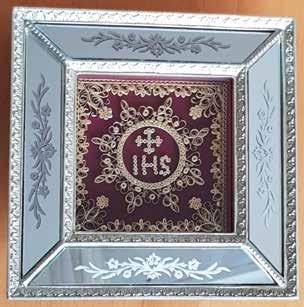
Die Wurzeln der Klosterarbeiten gehen zurück ins Mittelalter, auch wenn der Höhepunkt dieses Kunsthandwerks im Barock und Rokoko zu suchen ist. Verortet wurden sie in Frauenklöstern und einigen wenigen Männerkonventen. Von Südtirol sind die Arbeiten der Tertiarschwestern und der Englischen Fräulein in Brixen, der Klarissen in Säben und der Benediktinerinnen auf der Sonnenburg bekannt. Die Palette ist riesig: vom Osterlamm über Altarschmuck, vom Faltzettel als Talisman (Breverl) über das in Windeln gewickelte Jesuskind für die Krippe (Fatschenkindl), Primizkronen, Reliquien-Fassungen, Bildtafeln, Kastenbilder, Wachsarbeiten mit religiösen Motiven bis hin zum Trösterlein, der kleinen Jesusfigur als persönlichem Seelenhalt in der kargen Klosterzelle einer Nonne. Jedes Kloster hatte fürs kunstvolle Anfertigen seine speziellen Formen und Materialien, ob Gold- und Silberdraht, Stoffe wie Brokat, Samt und Seide, geschliffene Steine, Perlen und Pailletten, Muscheln und Schneckenhäuser, selbst getrocknete Gräser.
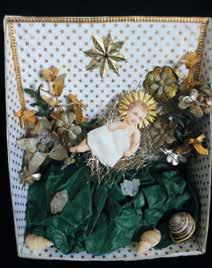
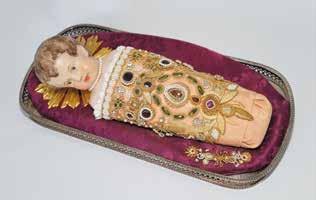
Das 16. Jahrhundert eröffnete diesen Klöstern durch den erwachenden Reliquienkult nach dem Konzil von Trient viele Möglichkeiten für diese meditative Präzisionsarbeit. Die Skelette mussten dekoriert werden, damit sie auf Altären präsentiert werden konnten. Auf diese Weise wurden Totengebeine, von denen man auch Wunder erhoffte, zu einem prächtigen, wenn auch makabren, Anblick. Auch kleinste Reliquienpartikel wurden zu Bestandteilen von Klosterarbeiten und eröffneten Klöstern damit eine beachtliche Einnahmequelle.
Später sind trotz Säkularisierung und der damit einhergehenden Zerstörung von Klöstern samt ihrer Kunstgegenstände doch einige dieser (versteckten) Arbeiten erhalten geblieben und über Umwege, meist Antiquitäten- und Flohmärkte, bei Sammler:innen gelandet. Der Südtiroler Verein ” Freunde der Klosterarbeiten“ mit Präsidentin Johanna von Call will dieses rare und wenig bekannte Kunsthandwerk einem größeren Publikum näherbringen. Auf Initiative von Johanna Straudi und Gerti Lechner ist es gelungen, die in mühevoller Handarbeit angefertigten Kostbarkeiten zum 20-jährigen Vereinsjubiläum auszustellen.
Zu sehen im Bozner in der Dominikanerkirche vom 6. bis zum 23. April 2023, täglich 10-18 Uhr; kostenloser Eintritt. Mehr zum Thema:
6
www.klosterarbeit.it
5.©
5.©
5.©
PIATTI INTRAMONTABILI E VARIAZIONI MODERNE
5 JAHRE STADTPARTNERSCHAFT ERLANGEN

Noch nie gehört? Schade, denn … in Erlangen sagt man ”passd scho“, wenn etwas sehr gut ist, man schätzt die Küche Südtirols und kennt sich im und um den Rosengarten bestens aus. Und außerdem: Nicht einmal zwei Corona-Jahre konnten die zwei Städte trennen, im Gegenteil, Rotary Erlangen spendete Masken für Bozen. Nun gibt es kein Halten mehr, 2022 radelte eine Gruppe aus Erlangen nach Bozen und erwartet für 2023 den Gegenbesuch. Gleiches gilt für den Schwimmsport, die Freimaurer tauschen sich schon von Beginn an aus, ebenso die Lebenshilfe. Vereine und Schulen treffen sich, und auch die Pfadfinder:innen und Ministrant:innen entdecken einander. Senior:innen und Junioren aus allen Bereichen planen ihre Begegnungen, Chöre geben gemeinsame Konzerte und zum Fest Herz Jesu veranstaltet der Erlanger Stadtverband Kultur eine Bürgerreise nach Bozen, während Ende August eine Gruppe des Südtiroler Kulturinstituts zum Poetenfest nach Erlangen darf. Und dann wären da noch all die Ideen des Freundeskreises Erlangen-Bozen zu Vorträgen über und Begegnungen mit dem Sehnsuchtsort Bozen – eine schöne Bürgerpartnerschaft. Mitmachen lohnt sich.
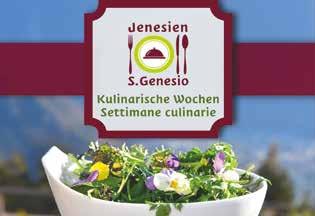
Le Settimane culinarie di San Genesio, quest’anno alla 34a edizione, si svolgeranno da venerdì 14 a domenica 30 aprile. Le sei strutture partecipanti, locande e ristoranti tipici di montagna, hanno insieme l’intenzione di sedurre i loro ospiti con ricette top secret della cucina locale (l’Antica Locanda al Cervo, l’osteria Noafer, il ristorantino Gasthof Luis und die Buabm, le due locande montane Tomanegger e Lanzenschuster oltre al ristorante dell’Hotel Belvedere). L’attenzione è rivolta più che mai alla regionalità, il che significa che nelle pentole e padelle viene utilizzato un numero particolarmente elevato di prodotti contadini e di materie prime stagionali a chilometro se non metro zero (vedi coverstory a p. 18). Protagoniste indiscusse primaverili saranno le erbe aromatiche e le erbette fresche dell’orto o di bosco, la carne proveniente dalle stalle locali e le verdure appena raccolte nei dintorni, preferibilmente dai masi di San Genesio. In abbinamento verranno serviti vini provenienti dai pendii soleggiati di Monzoccolo. Oggi più che mai le Settimane culinarie sono all’insegna della sostenibilità. L’evento è organizzato dalla sezione San Genesio dell’associazione sudtirolese albergatori e ristoratori assieme all’ufficio turismo del posto.

7 REVAMIRP A / FRÜH LING / S P GNIR \
Partnerstädte-Treffen der Touristiker Bozen-Erlangen im Februar 2020
7.©
www.jenesien.net
GOOD NEWS
BOLZANO REGINA GREEN
MUSEO CONTADINO ROHRERHAUS
Il nuovo report annuale “Ecosistema Urbano 2022” sulle performance ambientali di 105 Comuni capoluogo, redatto da Legambiente in collaborazione con Ambiente Italia e Il Sole 24 ore, mostra Bolzano in vetta alla classifica, in un quadro generale italiano con più smog, un parco auto circolante tra i più alti d’Europa, il trasporto pubblico che traballa e grosse perdite idriche. Il rapporto tiene conto di 18 indicatori, distribuiti in sei aree tematiche: aria, acque, rifiuti, mobilità, ambiente urbano ed energia. Il buon esempio arriva da Bolzano che, dal sesto posto dello scorso anno, conquista il primo della classifica di Ecosistema Urbano 2022. Al secondo posto Trento, seguita da Belluno, Reggio Emilia e Cosenza. Bolzano raggiunge il primo posto grazie soprattutto a buoni valori legati all’inquinamento atmosferico, tutti entro i limiti di legge. Inoltre, toccando un 66% di raccolta differenziata dei rifiuti, migliora in modo evidente negli indici legati al trasporto pubblico e cresce nelle infrastrutture dedicate alla ciclabilità, oltre ad aumentare i Kw installati su edifici pubblici.

E da Bolzano parte anche un ambizioso progetto per riciclare le dannosissime microplastiche nei fiumi e mari, ma anche nei prati e nelle discariche: il nuovo metodo è stato brevettato dal ricercatore e docente della facoltà di scienze e tecnologie dell’Università di Bolzano Marco Caniato, che è riuscito a escogitare un modo per occuparsi dei rifiuti composti da più tipi di plastica, ancora oggi di difficile smaltimento. Il metodo permette a questi scarti di diventare una risorsa da sfruttare nel settore dell’edilizia.
Pietra, legno e amore per l’accoglienza: sono le basi di questo luogo incantato. Il maso Rohrer (Rohrerhaus in tedesco) a Sarentino Paese, restaurato in grande stile quasi vent’anni fa, poi arredato e adibito a museo, è una fonte inesauribile di sorprese, racconti, memorie che svelano un modo di vita rurale tramandato per secoli nelle valli alpine. Oltre a essere uno dei masi più grandi e antichi (menzionato già nel 1288) della Val Sarentino, oggi è diventato luogo di incontro a carattere museale – comprende sala da pranzo, cucina, forno, affumicatoio, mulino e varie camere da letto. L’idea di preservare le tradizioni conservando un vecchio maso si accompagna bene a serate di concerti o di storytelling organizzate dall’associazione che cura il programma del museo. Si organizzano anche workshop e corsi dedicati alla cucina (come la cottura del pane tradizionale nel vecchio forno) e incontri per famiglie all’insegna del bricolage più tradizionale. Il luogo può, inoltre, essere noleggiato per seminari e celebrazioni speciali. Riapre i battenti dopo la sua pausa invernale a fine marzo.

8
www.rohrerhaus.it (con tour virtuale)
SPATIUM PINOT BLANC
Europas Weißburgunder trifft sich in Eppan am 18. und 19. Mai. Das Stelldichein aus Wissenschaft und Praxis ist die einzigartige Gelegenheit für Europas Fachpublikum und Weininteressierte, sich intensiv mit dieser Rebsorte auseinanderzusetzen und Weißburgunder zu verkosten, und zwar aus den wichtigsten Anbauregionen Italiens, Frankreichs, Deutschlands, Österreichs, Luxemburgs und der Schweiz. Auf dem internationalen Podium der vierten Auflage von Spatium Pinot Blanc in der Weinbaugemeinde Eppan an der Südtiroler Weinstraße stehen die Qualitätsproduzenten mit ihren Produkten, aber auch das Wissen um Abstammung, Ansprüche und Besonderheiten dieser besonderen Weine. Organisiert wird die Fachtagung mit hochkarätigen Fachleuten im Austausch und mit Verkostungen von Eppan Wein in Zusammenarbeit mit dem land- und forstwirtschaftlichen Versuchszentrum Laimburg und dem Tourismusverein Eppan. Gewusst? Der Weißburgunder wurde im 14. Jahrhundert erstmals urkundlich erfasst. Das flächenmäßig bedeutendste Anbaugebiet Europas ist heute Deutschland, mit rund 4.500 Hektar. In Südtirol spielt der Weißburgunder in zweifacher Hinsicht eine Rolle: Einerseits nimmt die Anbaufläche tendenziell zu (derzeit 515 Hektar), andererseits gehört er zu den Leitsorten in der Südtiroler Weinwirtschaft.
www.eppanwein.it
BOLZANO'S AWARD-WINNING WINES
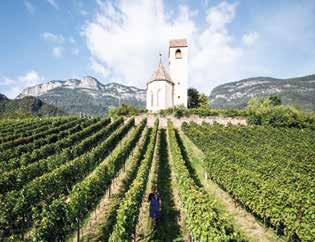
The list of Italian wine guides appears endless - Veronelli, Gambero Rosso, Vitae, Vinibuoni, Bibenda, Doctor Wine, Sparkle, The WineHunter or Slow Wine!
And their coveted awards carry considerable weight. If you’re looking right now, you’ll find Bolzano wines from the past year that have received a plethora of laurels. First and foremost, the Kellerei Bozen winery (8); the Lagrein Riserva Vigna Klosteranger 2017, from the Klosterkellerei Muri-Gries winery (5), took the most prizes; following, is Kellerei Bozen’s Lagrein Riserva Taber 2020 (4); and not forgetting Pfannenstielhof’s 2016 St. Magdalener klassisch (4). The 2020 St. Magdalener klassisch Isarcus from the Griesbauerhof winery also stood out, winning two prizes. Four wines from the Ansitz Waldgries winery each won awards, three from the Pfannenstielhof winery, and two from both the Hans Rottensteiner estate and Messnerhof winery. Then there’s the 2019 Lagrein Riserva, from Erbhof Unterganzner; the St. Magdalener classic Hub 2020, from Untermoserhof; Reyter winery’s 2019 Vernatsch; the Blauburgunder Riserva 2019, from the Ploner winery; and the Loacker winery’s Lagrein Gran Lareyn, from 2020. Gloria Mayr from Nusserhof received a special prize from Slow Wine, with Kellerei Bozen receiving Doctor Wine’s award for the best quality/price.
QUIZ
Qual è la singolarità del ritrovamento di Ötzi?
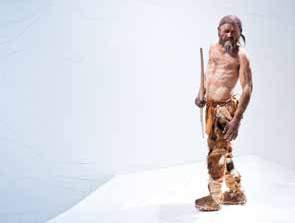
a) essere la mummia più antica del mondo
b) essersi conservato nel ghiaccio per ben 5300 anni
c) dare testimonianza della fine dell’età della Pietra, vista la sua rara e ottima conservazione Soluzione
9 REVAMIRP A / FRÜH LING / S P GNIR \
a pagina 98
dell’Alto
Museo Archeologico
Adige
11.©
GOOD NEWS
ENKELTAUGLICHE ZUKUNFT
MOSTRA COLLAGE A LAIVES

Dopo aver esposto le sue opere in molteplici mostre in Italia e all’estero, Daria Akimenko porta per la prima volta i suoi collage in una mostra personale a Laives. Le sue opere, che riecheggiano l'estetica dei manifesti sovietici, oscillano tra composizioni affollate e rappresentazioni minimaliste di singoli personaggi. Al loro interno l’artista intreccia testi che diventano anche gli “attori” centrali delle sue opere. I suoi collage si trasformano così in poesie criptiche e multilingui che lo spettatore può interpretare liberamente. La curatela di Margherita Cestari esalta le connessioni tra le opere e mette in evidenza i temi fondamentali della poetica dell’artista.
Weniger & besser: Der Tourismusverein Ritten hat gemeinsam mit der Rittnerhorn Bergbahnen AG wichtige Schritte in Richtung nachhaltige Gastlichkeit gesetzt. Begleitet von den Sachverständigen des Ökoinstituts Südtirol wurde 2022 eine Nachhaltigkeitsstrategie für den Tourismus mit knapp 400.000 Nächtigungen ausgearbeitet und der Zertifizierungsprozess mit einer offiziellen Stelle gestartet. ”Mehrere Themen haben die Arbeitsgruppe beschäftigt, deren Neuausrichtung Zukunft schreiben wird: sanfte Mobilität und Lenkung der Verkehrsströme durch digitale Leitsysteme, Wasser als knappes und wertvolles Gut, die Stärkung der Nahversorgung mit landwirtschaftlichen Produkten und selbst Handwerk aus dem Umfeld, die Unterstützung des Arbeitgebers Tourismus mit seinem Potential auch für die Jugend. Die künftige Marschrichtung wird geprägt sein von einem entsprechenden Gäste-Angebot und von der glaubhaften Darstellung dieser Rittner Überzeugung.“, erklärt Peter Righi, zuständig für Nachhaltigkeit im Tourismus am Ritten. Anhand der internationalen GSTC Destinations-Kriterien (Global Sustainable Tourism Council) wurde die neue Strategie festgelegt, unter Beteiligung der lokalen Dienstleister. Bestimmend sind dabei ein nachhaltiges Management, die sozioökonomischen, kulturellen und ökologischen Auswirkungen, und zwar bei allen neuen Entscheidungen. Zertifiziert wurde Ende Februar 2023. Parallel dazu ist die Gemeinde Ritten auf dem Weg zur Zertifizierung als ”Klimagemeinde Silver“

Nata nel 1987 in Unione Sovietica, Daria Akimenko è cresciuta in Russia, ha vissuto per qualche tempo nella Lapponia finlandese e attualmente risiede a Bolzano. La sua ricerca e i suoi interessi artistici risiedono nell'arte socialmente impegnata e narrative-based, nelle pratiche migratorie e nel lavoro sull'identità individuale e collettiva.
La mostra personale rimane aperta presso la Sala Espositiva di Laives dal 4 al 25 marzo ed è a ingresso gratuito. È prevista la realizzazione di una visita guidata in lingua italiana.
10
www.ritten.com
www.lasecondaluna.eu
BILDERBUCH ZUM SAGENKLASSIKER
Von der jungen deutschen Comiczeichnerin Kristina Gehrmann (Trägerin des Deutschen Jugendliteraturpreises) illustriert und von Charlotte Palmosi mit knappem Text versehen, kommt dieses Kinderbuch als großformatiges Bilderbuch daher, farbenprächtig und kurzweilig kindgerecht. Es erzählt die berühmteste Sage rund um Bozen, jene des weitum sichtbaren Bergmassivs Rosengarten, das sich an vielen Abenden glutrot färbt. Was steckt wohl hinter dem Schauspiel? Natürliche Kräfte oder doch ein uralter Fluch? Jener des Zwergenkönigs Laurin, früherer Herrscher über das magische Reich inmitten der Dolomiten. ” König Laurin und sein Rosengarten“ (28 Seiten, folio Verlag, 2022, 16 Euro)
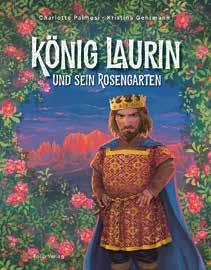
MAPPING SUSTAINABLE FASHION
Following JOSEF’s successful Insider's Contemporary Map Bolzano, the young team at franzLAB have launched their second unmissable map, and South Tyrol's first map of sustainable fashion. Published by JOSEF, The Insider's Sustainable Fashion map - South Tyrol is a supplement to their existing travel guide. With its fresh, contemporary graphic design, by Studio Babai, blogger Susanne Barta provides summary information
in English. This compact overview lists 29 players, including second-hand shops, labels, designers and tailors. The map shows everything connected to sustainable fashion and clothing in South Tyrol.
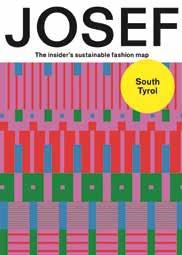
JOSEF’s Insider's Sustainable Fashion map - SouthTyrol is free of charge and already available in a selection of shops, hotels and other key points. Alternatively, you can pick up a copy from the publishers themselves, at the franzLAB office at Laubengasse-via dei Portici 35 in the city centre.
Teixl
When does a local dialect really come into its own? It’s usually when emotions run high that language can become, let’s say, “colourful”! Often, the devil himself takes centre stage –especially in traditionally Christian areas. In the rich varieties of South-Tyrolean German, the maleficent otherworld prince is known as Teixl (pronounced taixl) and he’s invoked as an intensifier, most often at the beginning of sentences like these: Teixl, bist du heute fesch! (The devil, you're so handsome today!), Teixl, hast du das schon gehört? (The devil, have you heard that yet?) or Teixl, ich hab jetzt genug (The devil, I’ve had enough now!). You’ll hear it in negative as well as positives sentences, to express surprise or even a certain respect. Teixl, noamol eini! (The devil, never!) is its intensified form. There are also onomatopoeic dialect words such as Sapperlott, and Hardimitzn (goodness me!), which tend to mark the end of a statement.
11 REVAMIRP A / FRÜH LING / S P GNIR \
Regional, gern auch biologisch. Bozen und Umgebung stehen beim Angebot bäuerlicher Produkte gut da. Aber was heißt „kleine Kreisläufe“? Welche Zukunft haben sie in der heimischen Landwirtschaft? Welchen Stellenwert für die Konsument:innen: beim Einkaufen und in den Alltagsgewohnheiten, auch während des Urlaubs? Eine Frage der Haltung.
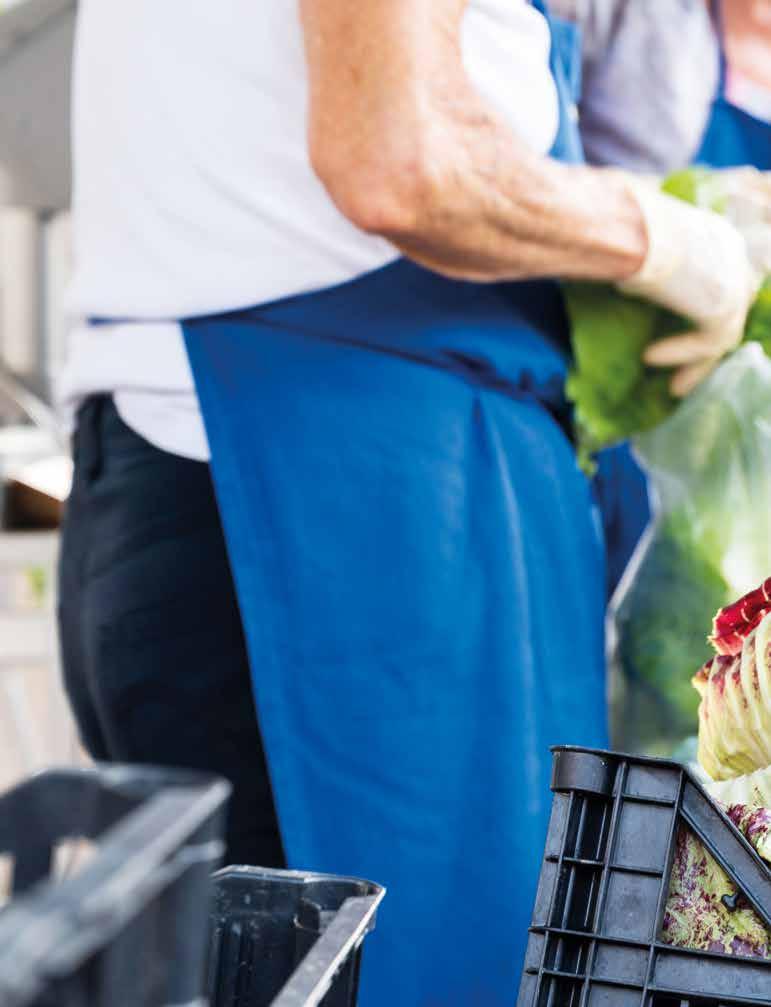
CHILOMETRO ZERO
p. 18
ZERO KILOMETRE FOOD
p. 19
12
0
COVERSTORY
KILOMETER

13 REVAMIRP A / FRÜH LING / S P GNIR \ 1.©
Lokal statt global. Die Entscheidung ist nicht nur in Bozen eine Frage des Lebensstils geworden. Und dieser wiederum eine Frage der Haltung gegenüber natürlichen Ressourcen, mittlerweile auch gegenüber der Zukunft unseres Planeten. In diesem Zusammenhang spielt der ökologische Fußabdruck eine wichtige Rolle und damit die Transportleistungen bzw. Treibhausgasemissionen, die notwendig sind, um unseren Frühstückstisch mit Leckerem zu bereiten: Woher stammt die Milch, die wir trinken, die Butter, der Honig, die Marmelade und das Brot, das wir essen? Und woher der Rohstoff Mehl, der für unser Brot verwendet wurde? Eine komplexe Angelegenheit. Weshalb bm einige Bauernmärkte in Bozen besucht und den Zuständigen für Direktvermarktung im Südtiroler Bauernbund, Hannes Knollseisen, zu einem Gespräch getroffen hat. Er hat Agrarwissenschaften an der Universität für Bodenkultur in Wien studiert und sich auf Marketing von bäuerlichen Qualitätsprodukten spezialisiert. Heute befasst er sich mit Rohstoff-Herkunftskontrollen bei bäuerlichen Produkten der Marke ” Roter Hahn“ und mit Hof- und Buschenschank-Kontrollen.
Kleine Kreisläufe, kurze Wege oder Lieferketten, ”chilometro 0“ – das sind die gängigen Begriffe. Aber was versteht man überhaupt unter einem regionalen Produkt?


Ja, wie grenzen wir ”regional“ ein? Für einen Wiener ist regional, wenn sein Frühstücksei aus Ös-
terreich stammt, für einen Tiroler muss es aus dem Großraum Tirol kommen, in Italien und in vielen Teilen Deutschlands spricht man oft auch von einem Kilometerradius und streitet dabei, ob dieser 50 oder 100 Kilometer umfasst. Es gibt keine Instanz und keine EU-Bestimmung, die das regelt. Bei uns in Südtirol zerbricht man sich darüber nicht den Kopf. Für uns geht ”regional“ automatisch mit der Herkunft aus der Provinz Südtirol (nicht der Region) einher. Eine plausible Eingrenzung ist jene, dass ein Produkt aus einem geografisch überschaubaren Gebiet kommt, mit dem man sich identifiziert. Das erklärt die Südtiroler Einstellung. Es geht beim Thema um Vertrauen, weniger um Kilometer. Ich spreche, übrigens, von ”metro 0“, wenn Buschenschank-Betriebe ihre eigenen Produkte auf den Tisch bringen. Und wir verwenden den Begriff ”regional“ kaum, sondern sprechen von bäuerlichen Produkten aus Südtirol oder aus einem bestimmten Tal in Südtirol.
Wer sind dann die Direktvermarkter?
Das wiederum wird bei uns mit einem Dekret des Landeshauptmanns (Nr. 10/2012) geregelt, das genau festschreibt, wie Herstellung, Verarbeitung und Verkauf von landwirtschaftlichen Produkten hierzulande zu erfolgen hat. Direktvermarkter-Betriebe sind also Bauernhöfe mit Sitz in Südtirol, die ihre nur am eigenen Hof erzeugten Rohstoffe verkaufen oder, bei verarbeiteten Produkten wie Trockenobst z.B., die vorwiegend (51%) den eigenen Rohstoff verarbeiten, z.B. Birnen. Auf Bauernmärkten gelten strengere Regeln:
14 DE/ 12.©
Hannes Knollseisen
EIN PAAR ZAHLEN
Bäuerliche Direktvermarkter in Südtirol: 455 (knapp 3% aller aktiven Landwirte), davon ein Viertel biozertifiziert. Im Schnitt bewirtschaften diese eine Fläche von 7,8 Hektar.
Der Löwenanteil beim Umsatz entfällt auf die Produktgruppe Wein und andere alkoholische Getränke, gefolgt von Käse und Milchprodukte, pflanzlichem Anbau und Eier. Die meisten setzen auf Ab-Hof-Verkauf, gefolgt von Bauernmärkten und Hauszustellungen. Daneben spielt die Gastronomie eine zunehmende Rolle.

Aus der ersten Strukturanalyse
WIFO – Institut für Wirtschaftsforschung der Handelskammer Bozen, Ende 2022
Da dürfen nur solche verarbeiteten Produkte verkauft werden, die mindestens 75 Prozent hofeigener Rohstoffe enthalten. Und wir vom Roten Hahn-Siegel nehmen auch nur solche bäuerlichen Produkte auf, die mindestens 75 Prozent Rohstoffe vom eigenen Hof beinhalten; die übrigen 25 Prozent müssen aus Südtirol stammen. Roter-Hahn-Produkte sind darum mit Abstand jene mit der größten Kontrolle an ” Regionalität“. Das wird auch regelmäßig überprüft. Und auch Neuzugänge werden penibel unter die Lupe genommen. Neben der Herkunftskontrolle werden die Produkte auch jährlich von einer Expertengruppe sensorisch geprüft, also verkostet. An die 200 pro Jahr. Nur fehlerfreie Produkte dürfen das Roter Hahn Zeichen tragen.
Und wie organisieren sich die Landwirte?
Zuerwerb am Bauernhof wird in Südtirol erst seit 1998 professionell unterstützt. Und zwar den ” Urlaub auf dem Bauernhof “, obwohl es diese Form des Tourismus bereits im 19. Jahrhunderts gibt, gerade im Raum Bozen. Bozner:innen zuerst und dann auch Gäste von außen leisteten sich die Sommerfrische auf einem Bauernhof am Ritten oder im Sarntal – ein städtisches Phänomen. Am Berg gab es kaum Hotels, so fanden die Städter-Familien Herberge am SelbstversorgerBauernhof und prägten den Anfang des Fremdenverkehrs in Südtirol, wo die Tradition, Gäste am Bauernhof willkommen zu heißen, tief verankert ist. Der Südtiroler Bauernbund hat seine Marketingabteilung 1998 gegründet und mit ihr die organisierte Plattform
und digitale Vermarktung über das Markenzeichen ” Roter Hahn“. Das Ziel lautet, die Wertschöpfung am Hof zu erhöhen. 2003 haben wir mit der professionellen Bewerbung von bäuerlichen Produkten und lokalen Buschenschänken sowie mit ihrer Qualitätskontrolle begonnen. Bei den Direktvermarktern, also den Höfen, die bäuerliche Produkte im eigenen Hofladen, in Geschäften oder auf Bauernmärkten verkaufen, hatten wir anfangs südtirolweit 30 Betriebe, jetzt sind es 83. Wir zertifizieren derzeit über 830 Produkte (Etiketten). Wer sich ein Bild machen möchte, ist herzlich eingeladen, beim Farm Food Festival vorbeizuschauen (Eintritt frei), am Samstag, 25. März im Meraner Kursaal. Da finden Verkostungen und Kochshows mit Roter-Hahn-Bauernprodukten statt.
Vor welchen Herausforderungen stehen diese Lebensmittelerzeuger:innen?
Die absolut größte ist die Arbeitskraft. Wir sprechen von Familienbetrieben, die saisonal Hilfe brauchen und auch da mit extremen Spitzen und hoher Arbeitsbelastung. Die meisten Höfe sind entlegen und tun sich sehr schwer, Fachkräfte zu finden. Auch ist die Belastung für alle Familienmitglieder groß: Sie sind Rohstoffpro -
15 REVAMIRP A / FRÜH LING / S P GNIR \ 1.© 1.©
duzenten, Lebensmitteltechnologen, Werbestrategen und Kommunikatoren (heute auch Social Media Manager), Designer (für Etiketten) und Innenarchitekten (für Hofläden), Logistiker, Verkäufer und Handwerker. All diese Ansprüche unter einen Hut zu bringen ist schwierig. Und dann kommt noch die Bürokratie dazu. Sie sind wahre Jongleure, gute noch dazu.
Wie beurteilst du die Lage im Raum Bozen?

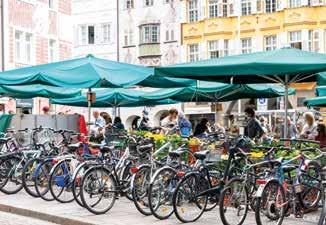
Wir befinden uns in der Nähe eines Ballungszentrums, und so haben sich viele Direktvermarkter-Höfe in Jenesien z.B. auf Gemüse spezialisiert. Ich hoffe, dass noch mehr davon sich auf das Frischesortiment (Obst und Gemüse, Fleischpakete, Frischkäse, Eier, Brot) spezialisieren und damit größere Mengen verfügbar werden. Wir müssen uns – neben den Bauernmärkten – noch weitere Vertriebswege einfallen lassen, denn nicht alle Haushalte haben untertags Zeit, sich dort mit Gütern des täglichen Bedarfs zu versorgen. Anders ist es bei den veredelten Produkten, die sich als Mitbringsel eignen: Eingelegtes, Sirupe, Destillate, Wein, Honig, Fruchtaufstriche, Trockenobst. Die finden gerade am Bauernmarkt ihren Absatz.
Für die bäuerlichen Direktvermarkter ist Tierwohl ein großes Thema, überhaupt Transparenz, denn der direkte Draht zu den Kund:innen und das Vertrauen sind das Um und Auf. Die Nähe macht es unmöglich, sich in der Anonymität zu verstecken. Ihre Produkte sind so nicht nur ökologisch sinnvoller durch die kurzen Wege, sondern meist auch ungemein gesünder und intensiver im Geschmack, weil die Zeitspanne zwischen Ernte und Verkauf/ Verzehr kürzer ist. Auch im konventionellen Anbau neigen lokale Bauernhöfe dazu, Pflanzenschutz und Düngemittel auf ein Mindestmaß zu reduzieren - die Bauernfamilie versorgt sich ja auch selbst mit den hofeigenen Produkten. Diese Argumente hört man beim Einkauf auf den Bauernmärkten der Stadt unentwegt. Jörgl Springeth, Gemüsebauer im Bozner Stadtteil Moritzing, koordiniert die Bauernmärkte der Stadt. Er ist drei Mal die Woche auf einem der Märkte und beobachtet, dass die enge Bindung zwischen Produzent:innen und Konsument:innen, das Gespräch am Marktstand, vor allem von den Jungen äußerst geschätzt wird. Ihre Experimentierfreude in der Küche ermöglicht ihm auch die Vielfalt im Anbau, was wiederum den

www.roterhahn.it
1.© 1.©
16
1.©
Spaßfaktor erhöht. Seit 2009, seit den Anfängen, ist die Familie Amplatz vom Gebreitnerhof in der Nähe von Brixen beim ersten und einzigen Bio-Bauernmarkt Südtirols, jeden Dienstag am Bozner Rathausplatz. Neun Stellplätze mit einem sehr breiten Angebot an Gemüse, Brot, Kräuter, Milchprodukten, Honig, Eiern, auch Fleisch. Nur zertifizierte Biobetriebe dürfen mitmachen und freuen sich auf ihre Stammkunden und die Passanten im Stadtzentrum. Hedwig Heiß, die Bio-Bäuerin vom Munterhof im Sarntal, erzählt, wie sie anfänglich durch die Unterstützung der Verbraucherzentrale die Initiative ergriffen hat, das Biologische in der Stadt durch einen eigenen Markt zu verwurzeln. Und eine weitere Einsicht macht sich breit: Ihr Standnachbar Josef Kröss (auf S. 16) vom Töllerhof in Algund beteuert, dass nur eine tiefe Überzeugung auf beiden Seiten, jener des Anbaus und jener des Konsums, dieses arbeitsintensive Wirtschaften erkläre.
Der Hebel zur Veränderung wird künftig auch von der Speisekarte ausgehen: Transparenz und Herkunft sind die Loswörter. In Südtirol ist eine Diskussion entbrannt, die zu einem Landesgesetz führen könnte. Fragen Sie also am Frühstücksbuffet am besten nach, woher Eier & Milch kommen!
BAUERNMÄRKTE IN UND UM BOZEN
STADT BOZEN (ganzjährig)
Obst, Gemüse, Kräuter, Käse, Eier, Honig & Sirupe
Rathaus-Platz – freitags
Mazzini-Platz – dienstags
Europaallee – dienstags
Casagrande-Platz – dienstags
Don-Bosco-Platz – freitags
Cl.-Augusta-Straße neben dem Kindergarten – freitags
BIO-BAUERNMARKT IN DER STADT
Obst, Gemüse und diverse Produkte von Südtiroler Bio-Bauernhöfen (durch EU-Kontrollstellen zertifiziert)

Rathausplatz - dienstags von 7.30 bis 13 Uhr
JENESIEN
samstags von 7.30 Uhr bis 12 Uhr im Dorfzentrum: Obst und Gemüse sowie Eier, Käse, Ricotta, Joghurt usw.
RITTEN
am Bahnhof Oberbozen ab Ende Mai dienstags 12-17 Uhr und in Klobenstein samstags
das ganze Jahr über am Parkplatz Kaiserau von 8-12 Uhr
EPPAN
dienstags in der Fraktion St. Michael (frühmorgens bis ca. 13 Uhr)
SARNTAL
bäuerliche Produkte aus dem Sarntal und den Nachbargemeinden: Obst und Gemüse, hausgemachte Backwaren wie Sarner Striezl, einheimischer Speck und Käse - auf dem Kirchplatz in Sarnthein
samstags ab Oster-Samstag bis Ende Oktober von 8-12 Uhr; zusätzlich am 11. April der Ostermarkt und am 18. Mai der Veitsmarkt
LEIFERS
samstags von 7.30 bis 12 Uhr auf dem Rathausplatz ab ca. Anfang April mit lokalen Lebensmitteln
(ar) 1.© 17 REVAMIRP A / FRÜH LING / S P GNIR \
CHILOMETRO 0
PRODOTTI AGRICOLI SANI, ANCHE BIOLOGICI, E UNA FILIERA CORTA. BOLZANO
E I SUOI DINTORNI OFFRONO UNA VASTA
GAMMA DI PRODOTTI A CHILOMETRO
ZERO. QUALE FUTURO HANNO NELL'AGRICOLTURA LOCALE? QUAL È IL LORO SIGNIFICATO PER I CONSUMATORI: NEGLI ACQUISTI E NELLE ABITUDINI QUOTIDIANE, IN VACANZA?
Ultimamente si sta diffondendo l’importanza dei prodotti agricoli a chilometro zero legati a una scelta di vita, alla positiva incidenza rispetto alle emissioni di gas totali generati per far arrivare un alimento sulle nostre tavole; senza dimenticare il consumo spropositato di concimi e pesticidi necessari per il ciclo produttivo intensivo che ci propone la grande distribuzione. Da dove vengono il latte che beviamo, il burro, il miele, la marmellata e il pane che mangiamo a colazione? E da dove proviene la materia prima della farina utilizzata per il nostro pane? bm ha visitato alcuni mercati contadini di Bolzano, ha parlato con chi li coordina e con il responsabile marketing dell'Unione Agricoltori Sudtirolesi, Hannes Knollseisen. L'agronomo si occupa dei controlli sull'origine delle materie prime per i prodotti agricoli del marchio "Gallo Rosso".
Filiera corta, "chilometro 0": questi sono i termini comuni. Ma cosa intendiamo per prodotto regionale?
In Italia e in molte parti della Germania si ha in mente il raggio chilometrico, discutendo se debba trattarsi di 50 o 100 chilometri. Non c'è nessuna autorità e nessun regolamento UE che disciplini questa materia. Qui in Alto Adige, "regionale" si accompagna automaticamente alla provenienza dalla provincia autonoma di Bolzano (quindi non dalla regione Trentino-Alto Adige). Perché? Perché identificarsi con il prodotto svolge un ruolo determinante, aiuta a riconoscere la cultura che ci sta dietro. Il problema di fondo è la fiducia e non tanto i chilometri. Del resto, io amo parlare di "metro 0": si pensi a quando i masi vendono i loro prodotti in loco o li sfornano sui piatti nelle loro taverne (Buschenschank) offrendoli ai visitatori. Chi sono allora i venditori diretti?
Questo, a sua volta, è regolato in Sudtirolo da un decreto del governatore provinciale (n. 10/2012).
I commercianti diretti sono agricoltori con sede in provincia che vendono le materie prime prodotte
MERCATI CONTADINI A BOLZANO E DINTORNI
In città (tutto l’anno, di mattina)
Piazza Municipio – venerdì, Piazza Mazzini – martedì
Viale Europa – martedì, Piazza Casagrande – martedì
Piazza Don-Bosco – venerdì, via Cl.-Augusta accanto all’asilo – venerdì
Mercato BIOLOGICO chilometro zero
Piazza Municipio – martedì dalle 7.30 alle 13
SAN GENESIO sabato dalle 7.30 alle 12 in centro
RENON presso la stazione di Soprabolzano il martedì dalle 12 alle 17 a partire da fine maggio;
a Collalbo il sabato dalle 8 alle 12 tutto l’anno
APPIANO martedì nella frazione di S. Michele fino alle 13
VAL SARENTINO in paese a Sarentino il sabato a partire da Pasqua fino a fine ottobre dalle 8 alle 12
LAIVES sabato dalle 7.30 alle 12 in Piazza Municipio da aprile in poi
solo nella propria azienda agricola o, nel caso di prodotti raffinati - come ad esempio un succo o una marmellata - che lavorano prevalentemente (51%) la propria materia prima, come i lamponi. Ai mercati agricoli si applicano regole più severe: qui possono essere venduti solo i prodotti agricoli che contengono almeno il 75% di materie prime dell'azienda venditrice. E noi del marchio Gallo Rosso siamo ancora più severi, accettiamo solo prodotti agricoli che contengono almeno il 75% di materie prime provenienti dalla azienda agricola in questione, il restante 25% deve provenire dall'Alto Adige. I prodotti Gallo Rosso sono quindi di gran lunga quelli con il maggior controllo della "regionalità". Nel 2003 avevamo 30 aziende agricole in Alto Adige, ora sono 83.
www.gallorosso.it
L’obiettivo rimane ridurre la distanza tra produttore e consumatore a beneficio soprattutto dell’ambiente, sollevando l’economia locale dai grandi supermercati e dalla vendita online globalizzata. Le aziende agricole locali tendono a evitare gli ormoni sintetici, i fertilizzanti e altre sostanze chimiche nocive per l’ambiente e la salute dell’uomo. I prodotti agricoli locali sono, quindi, non solo più freschi ma anche più sicuri. E poi c’è il benessere degli animali che è un tema importante per i venditori diretti, così come la trasparenza, visto che il contatto diretto con i clienti e la fiducia risultano essenziali. Questo tipo di rapporto rende impossibile nascondersi nell'anonimato.
In futuro, la leva del cambiamento verrà anche dal menu proposto nei ristoranti e nelle locande: trasparenza e origine saranno le parole d'ordine anche nella gastronomia locale. In Alto Adige è scoppiata una discussione che dovrebbe portare a una legge provinciale. Per ora, consigliamo di chiedere la provenienza di uova e latte al buffet della colazione!
IT/ 18
ZERO KILOMETRE FOOD
REGIONAL AND PLEASINGLY ORGANIC. BOLZANO AND THE SURROUNDING AREA ARE WELL POSITIONED WHEN IT COMES TO OFFERING FARM PRODUCE. BUT WHAT DOES “SHORT DISTANCES” MEAN? WHAT FUTURE DOES THIS HAVE IN LOCAL AGRICULTURE? WHAT IS THE IMPORTANCE FOR CONSUMERS: IN SHOPPING AND EVERYDAY LIFE OR ON VACATION?
The local as opposed to the global. The decision has become a question of lifestyle, not only in Bolzano. This, in turn, is a question of attitude towards natural resources. In this context, our ecological footprint plays an important role, along with considering the greenhouse gas emissions necessary to prepare our breakfast table with delicious food. Where does the milk we drink, the butter, honey, jam and bread we eat come from? Where does the raw flour for our bread come from? bm Magazine visited farmers' markets in Bolzano, to meet and interview Hannes Knollseisen - the person responsible for direct marketing at the South Tyrolean Farmers' Union. An agronomist, he deals with raw material origin controls for the Roter Hahn farm products brand and with farm and wine tavern matters. Short distance supply chains, Zero Kilometre - these are the common terms. But what do we actually mean by a regional product?
In Italy and in many parts of Germany, people talk about the kilometre radius, arguing whether it is 50 or 100 kilometres, though no EU regulation governs this. Here in South Tyrol, regional automatically means originating from the province of South Tyrol (not the region). Why? Because identification plays an important role. The issue is more about trust than kilometres. By the way, I also talk about “zero metre”, when Buschenschank establishments bring their own produce to the table.
Who then are the direct marketers?
This is regulated here by a decree from the Provincial Governor (No. 10/2012). Direct marketers are farmers based in South Tyrol, who only sell the raw materials produced on their own farm. In the case of processed products, for example concentrated juices, only those processed predominantly with their own raw materials (51%), e.g. raspberries. Stricter rules apply at farmers' markets, with only farm-fresh products containing at least 75% of the farm's own raw materials may be sold there. And we at the Roter Hahn brand only accept those farm products that contain at least 75 percent raw materials from the specific farmfarm; the remaining 25 percent must come from South Tyrol. Roter Hahn products are therefore those with the greatest control of regionality by far. This is also regularly
FARMERS MARKETS IN AND AROUND BOLZANO
City of Bolzano (all year round)
Piazza Municipio - Fridays
Piazza Mazzini - Tuesdays
Via Europa - Tuesdays
Piazza Casagrande - Tuesdays
Piazza Don Bosco - Fridays
Via Claudia Augusta, beside the kindergarten - Fridays
Bio-Bauernmarkt -
Organic farmers' market in the city
Piazza Municipio - Tuesdays 7.30 a.m. - 1 p.m.
JENESIEN Saturdays from 7.30 a.m. to midday in the village centre
RITTEN Oberbozen train station on Tuesdays from the end of May, from about midday till 5pm; Klobenstein on Saturday mornings, all year round from 8 a.m. to 12 noon
EPPAN Tuesdays in the St. Michael district (early morning until around 1 p.m.)
SARNTAL Church square in Sarnthein, Saturdays from Easter Saturday to the end of October, 8 a.m. till noon
LAIVES On the town hall square, from about the beginning of April, Saturdays from 7.30 a.m. to noon
controlled. In 2003, we had 30 farms throughout South Tyrol; now there are 83. www.roterhahn.it
A major issue for direct marketers is animal welfare, with transparency another, because trust and direct contact with customers are essential. Proximity makes it impossible to hide in anonymity. Their products are not only more ecologically sound, due to the short distances, but usually also far healthier and taste more intense, because the time span between harvest and sale/consumption is shorter. Even in conventional farming, local farms tend to avoid fertilizers and other harmful chemicals - after all, the farm's own produce is also destined for the farmer’s table! Local - from the farm - is therefore also safer.
In the future, the leverage for change will also come from the menu, with transparency and origins the watchwords. In South Tyrol, a discussion is taking place that could lead to a provincial law. So, do ask at the breakfast buffet where eggs & milk are from!
EN/ 19 REVAMIRP A / FRÜH LING / S P GNIR \
QUALI CONFINI?
La 36esima edizione di Bolzano Film Festival Bozen sarà una svolta: le novità, i traguardi, il programma di uno dei piccoli festival più originali nel panorama italiano del grande cinema d’autore – raccontati dal nuovo direttore artistico Vincenzo Bugno.

20 CULTURE
Un festival di transizione con contenuti nuovi: oltre ad alcune masterclass aperte a tutti, il programma prevede le sezioni Local heroes goes Euregio, Piccole lingue, Made in Südtirol, “Reale o non reale”, ovvero una sezione di documentari fuori concorso e ovviamente il concorso, da quest’anno aperto ad opere di finzione, ibride e alle diverse forme documentarie. Si partirà inoltre con un programma pilota, “LiLi / Little Lights”, dedicato al cinema per bambini. Infine, come sempre, è prevista la celebrazione di due ospiti d’onore.
Identità flessibili, confini più ampi: questo il leitmotiv dell’edizione 2023 che si svolgerà durante la terza settimana di aprile. Dopo anni di successi con alla guida prima Martin Kaufmann e poi Helene Christanell, cambia la direzione del Filmfestival. La scorsa estate, attraverso un processo di selezione, il direttivo del Filmclub ha nominato Vincenzo Bugno, scelto tra una rosa di 35 candidati. bm l’ha incontrato nell’ufficio del Festival presso la Casa della Pesa di Bolzano.

VINCENZO BUGNO
Veneziano di nascita, vive a Berlino dal 1988. Dopo la laurea in lettere, storia dell'arte e cinema all'Università Ca' Foscari di Venezia, ha lavorato come giornalista e critico cinematografico per testate italiane e svizzere, in seguito per emittenti televisive quali Arte, ZDF, Tele+ e Sky Italia come autore e regista di servizi e documentari sul cinema e su altri temi culturali, ed è stato consulente e curatore di diversi festival cinematografici internazionali oltre che membro del comitato scientifico e curatore di retrospettive per il “Trieste Film Festival / Alpe Adria”. Intensa è stata la sua attività per il “Locarno Film Festival” come membro del comitato di selezione e responsabile della sezione “Open Doors”, sezione dedicata al “cinema esistente” e al “cinema in costruzione”.
Dal 2002 Bugno collabora in varie funzioni con il Festival Internazionale del Cinema di Berlino “Berlinale”. È stato membro del comitato di selezione, consulente per l’Italia ed il mondo arabo del Festival. È responsabile e membro della giuria del Berlinale World Cinema Fund, fondato nel 2004 con l'obiettivo di sostenere la produzione cinematografica in regioni e Paesi privi di un'industria cinematografica strutturalmente forte e co-finanziatore di più di 300 film. Dal 2019, inoltre, è curatore del “Torino Film Lab (TFL) / Feature Lab”, una delle istituzioni più prestigiose attive nell’ambito del “cinema in costruzione”.
1.© 21 REVAMIRP A / FRÜH LING / S P GNIR \
IT/
Perché ha accettato questa sfida a Bolzano?

La scintilla è stata la curiosità per questa realtà diversa, multilingue, di frontiera, plasmata da contraddizioni. Conoscevo l’Alto Adige da vacanze che avevo fatto con i miei genitori da piccolo e dai racconti di amici studenti a Venezia. Di questa realtà mi incuriosivano tanto il passato conflittuale quanto il presente ibrido – un terreno fertile in termini culturali e sociologici. Anch’io sono un “ibrido” da quando ho lasciato Venezia per Berlino; passo dall’italiano al tedesco e da una cultura all’altra con grande piacere. Un luogo come Bolzano ha un enorme potenziale culturale, ha un’intensa vita culturale con vivaci istituzioni. E poi mi affascinano i piccoli festival. È una vita, ormai, che mi occupo di cinema e penso che il cinema sia un momento di condivisione nel senso di luogo, di scambio. Nella lingua tedesca la parola cinema (Kino) è anche il luogo dove si proietta. Investirò in questo aspetto, credo ferma-
mente che bisogna battersi perché il cinema resti un luogo oltre che uno spettacolo visibile (anche altrove). E poi Bolzano mi sembrava un luogo dove far fruttare molte mie esperienze passate, in Italia e all’estero.
Quale visione ha per il Bolzano Film Festival Bozen? Allora, bisogna vedere la sua storia: è partito come festival per il cinema tedesco oltre 35 anni fa. Chi l’ha fondato, andava a prendersi le pellicole a Monaco. Le lingue hanno sempre avuto un ruolo determinante nella rassegna, anche tematicamente. Abbiamo tuttora una sezione che si chiama “Piccole lingue”. Il discorso sulle frontiere, minoranze e contraddizioni di questa regione è esportabile in altri contesti culturali, per cui vogliamo rimanere fedeli all’idea originale del festival, ma vogliamo aprirla ad altre realtà, anch’esse segnate da identità conflittuali o contraddittorie, con minoranze e rispettive contaminazioni. Molti cineasti sono interessati a questi temi, del resto sempre più globali. Il


22 1.© 1.© 1.©
Nella storica Casa della Pesa in Piazza del Grano si trovano gli uffici del BFFB
Il Cinema Capitol/Filmclub, dove si proiettano i film in concorso
nostro Festival diventerà sempre più un festival che si occupa di questi movimenti, del partire e magari anche del tornare, di cosa uno perde o guadagna in termini umani a cambiare luogo, lingua, identità o comunque realtà. Pensiamo, per esempio, ai nuovi italiani o sudtirolesi o bolzanini… Quando dico “vogliamo”, intendo tutta l’istituzione Filmclub Bolzano che organizza il festival: a partire da Luigi Loddi, il nuovo Presidente, anche lui in sintonia con questa visione di sviluppo che è la formula di come vogliamo posizionare il Festival nel variegato panorama di festival italiani ed europei.
Novità per il programma 2023?
Partiamo dai contenuti: dicevo appunto che ci affascina l’idea di sviluppare il discorso delle minoranze e del bagaglio culturale più ampio, non legato solo alle Alpi. Ci sarà una sezione Focus Europa con un paese ospite del festival, in questa edizione sarà il cinema galiziano (ES), del resto molto vivace e interessante sia come regione di frontiera, con una propria lingua, che come realtà cinematografica, con una generazione di cineasti locali di grandissimo spessore nel panorama europeo. I confini sono fatti anche per essere oltrepassati o aboliti, per di più nel cinema. Quindi abbiamo deciso di cambiare la struttura del festival come concorso unificando le sezioni dedicate al lungometraggio e al documentario. Sarà il miglior film a vincere, non importa se “fiction, documentary or everything in between”. Offriremo, inoltre, una serie di masterclass che parlano di cinema, aprendole al pubblico. Saranno eventi di altissimo livello culturale come l’appuntamento con la catalana Marta Andreu, autentica filosofa e poeta del documentario. Quindi, non solo pellicole ma anche riflessioni sul cinema contemporaneo, per coinvolgere anche nuove fasce di pubblico.
IL PROGRAMMA BFFB
18-23 aprile 2023 presso il Filmclub di Bolzano (3 sale con 399 posti a sedere: Capitol 1, Capitol2 e Club3) Il film d’apertura 2023 sarà “Vera” di Tizza Covi e Werner Frimmel.
Una donna in cerca della sua identità, Vera Gemma, figlia della star italiana Giuliano Gemma, è al centro di questo toccante racconto pluripremiato alla Mostra del Cinema di Venezia (miglior regia e miglior interpretazione femminile di Orizzonti) e reduce da un grande successo anche all’ultima Viennale. Già con “Babooska” (2005) e poi con “La pivellina” (2009), seguito da “Mister Universo” (2017), Covi e Frimmel hanno fatto incetta di premi arrivando a rappresentare l’Austria agli Oscar. Il duo, composto dalla bolzanina Tizza Covi e dal viennese Rainer Frimmel, rappresenta una realtà consolidata nel campo di quel genere ibrido che si è soliti chiamare docufiction. Da anni ospiti con i loro interessanti lavori del Bolzano Film Festival Bozen, i due registi, attenti e acuti osservatori dell’essere umano, tornano a Bolzano con questo ritratto straordinario.
Concorso BFFB per opere di ‟fiction, documentary, everything in between”
Temi ricorrenti: contaminazioni positive; cinema esistente; cinema in costruzione
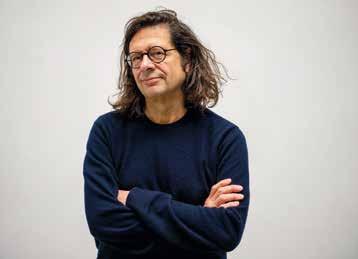
Reale non reale: rassegna per documentari più convenzionali, ma ciononostante di forti contenuti
Piccole lingue: il cinema dedicato alle lingue delle minorante
Focus Galizia: rassegna dedicata al cinema della Galizia spagnola, una delle cinematografie più importanti degli ultimi anni
Local Heroes: cinema della macroregione Euregio
Made in Südtirol in collaborazione con IDM
Master classes + carte blanche: professionisti del cinema e le loro convinzioni artistiche, eventi accompagnati da un film che gli stessi autori considerano particolarmente rappresentativo
Ospiti d'onore/premio alla carriera: Jacopo Quadri e Christine A. Maier
La giuria del Bolzano Film Festival Bozen: Ciryl Schäublin, Beatrice Fiorentino, Bernhard Karl, Zsuzsanna Chirali, Anke Leweke
www.filmfestival.bz.it
www.filmclub.it
23 REVAMIRP A / FRÜH LING / S P GNIR \ 1.©
WELCHE GRENZEN?
DIE
36. AUSGABE DES BOLZANO FILM FESTIVAL BOZEN VERSPRICHT EINEN WENDEPUNKT: NEUHEITEN, MEILENSTEINE, DAS PROGRAMM EINES DER ORIGINELLSTEN KLEINEN FESTIVALS DER ITALIENISCHEN AUTORENFILMSZENE.
Ein Übergangsfestival mit neuen Inhalten: Neben einer Reihe von Masterclass-Einheiten, die allen offen stehen, umfasst das Programm die Sektionen Local heroes goes Euregio, Kleinsprachen DOC, Made in Südtirol, Euregio Young Jury, "Real or not real", d.h. eine Sektion mit Dokumentarfilmen außerhalb des Wettbewerbs und natürlich den Wettbewerb selbst, der dieses Jahr für Spielfilme, Mischformen und verschiedene Dokumentarformen gleichermaßen offen ist. Außerdem wird es ein Pilotprogramm “LiLi / Little Lights” geben, das dem Kinderkino gewidmet ist. Und wie immer zwei Ehrengäste.
Flexible Identitäten, Grenzüberschreitungen: Das ist das Leitmotiv der Ausgabe 2023, die in der dritten Aprilwoche stattfinden wird. Nach den erfolgreichen Jahren mit Martin Kaufmann und Helene Christanell an der Spitze wechselt die Filmfestivalleitung. Im vergangenen Sommer hat der Vorstand des Filmclubs in einem Auswahlverfahren Vincenzo Bugno aus einer Liste von 35 Kandidaten ausgewählt: Der gebürtige Venezianer lebt seit 1988 in Berlin, ist Filmkritiker, Autor und Regisseur, Berater und Kurator internationaler Filmfestivals. Seit 2002 arbeitet Bugno mit dem Internationalen Filmfestival Berlinale zusammen und ist Verantwortlicher, Förderer und Jurymitglied des World Cinema Fund.
Warum haben Sie diese Herausforderung in Bozen angenommen?
Der Funke war die Neugierde auf diese vielfältige, mehrsprachige, von Widersprüchen geprägte Wirklichkeit als Grenzregion. Ich war sowohl von deren konfliktreichen Vergangenheit als auch von ihrer hybriden Gegenwart fasziniert - ein fruchtbarer Boden in kultureller und soziologischer Hinsicht. Seit ich von Venedig nach Berlin gezogen bin, erachte ich mich selbst als “hybrid”, denn ich wechsle genauso und mit großer Freude vom Italienischen zum Deutschen und von einer Kultur zur anderen. Eine Stadt wie Bozen hat ein enormes kulturelles Potenzial, sie hat ein intensives kulturelles Leben mit lebendigen Institutionen.
Was gibt es Neues im Programm 2023?
Beginnen wir mit dem Inhalt: Wir sind hin und weg von der Idee, den Diskurs um Minderheiten und deren breiten kulturellen Hintergrund, nicht nur in Bezug auf die Alpen, weiterzuentwickeln. Es wird einen Fokus auf Europa geben, mit einem Gastland des Festivals, in dieser Ausgabe wird es das galizische Kino (ES) sein, das ebenfalls sehr lebendig ist, sowohl als Grenzregion mit einer eigenen Sprache als auch als Filmrealität mit einer Generation von lokalen Filmemachern, die in der europäischen Szene eine große Rolle spielen. Grenzen sind u.a. dazu da, überschritten oder aufgehoben zu werden, auch im Kino. Deshalb haben wir beschlossen, die Struktur des Wettbewerbs im Festival zu ändern, indem wir die Sektionen Spielfilm und Dokumentarfilm zusammenlegen. Der beste Film gewinnt, egal ob Spielfilm, Dokumentarfilm oder etwas dazwischen. Außerdem werden wir eine Reihe von Masterclasses zum Thema Kino anbieten, die für die Öffentlichkeit zugänglich sind.
BOLZANO FILM FESTIVAL BOZEN

18.-23. April 2023 im Filmclub Bozen (3 Säle mit 399 Sitzplätzen: Capitol 1, Capitol2 und Club3)
Der Eröffnungsfilm 2023 ist " Vera" von Tizza Covi und Werner Frimmel, ein mehrfach preisgekrönter Streifen bei den Filmfestspielen von Venedig. www.filmfestival.bz.it
24
www.filmclub.it DE/ 1.©
BORDERS, WHAT BORDERS?
THE 36TH EDITION OF THE BOLZANO FILM FESTIVAL WILL BE A TURNING POINT: NEW RELEASES, THE HIGHLIGHTS, THE PROGRAMME OF ONE OF THE MOST ORIGINAL SMALL FESTIVALS IN THE ITALIAN WORLD OF GREAT AUTEUR CINEMA.
A festival of transition with fresh content. In addition to a number of masterclasses open to all, the program includes the sections Local heroes go Euregio, Small languages, Made in Südtirol, Euregio Young Jury, “Real or unreal”. There’s a section of non-competing documentaries and a lively children's cinema programme. Finally, as always, there’ll be a celebration of two guests of honour.
Flexible identities, larger borderlands: this is the leitmotif of the 2023 festival, taking place in the third week of April. After years of success, first with Martin Kaufmann and then Helene Christanell at the helm, the Filmfestival's leadership has changed. Through a selection process last summer, the Filmclub board appointed Vincenzo Bugno, from a shortlist of 35 candidates. Venetian by birth and Berlin resident since 1988, he’s a film critic, author and director, consultant and curator
of international film festivals. Since 2002, Bugno has been working with Berlin’s Berlinale International Film Festival, and is a promoter, member of the jury and responsible for the World Cinema Fund.

Why did you accept this challenge in Bolzano?
Profound curiosity about this diverse, multilingual frontier land, shaped by contradictions. I was as intrigued by the conflictual past as I was by its hybrid present - a fertile ground in cultural and sociological terms. I too have become a “hybrid”, since I left Venice for Berlin, and I switch from Italian to German, from one culture to another with great pleasure. A place like Bolzano has enormous cultural potential, with its intense cultural life and dynamic institutions.
What's new for the 2023 programme?
Let's start with content: we’re fascinated by the idea of developing the discourse related to minorities and the broader cultural context, not only connected to the Alps. There will be a Focus Europe section, with a guest country for the festival. This year, it will be Galician cinema (Spain), which is very lively and interesting, after all. It’s both a border region with its own language and has a rich cinematic culture, with a generation of local filmmakers of great importance to the European scene. Borders are made to be crossed or abolished, even in cinema. So, we decided to change the structure of the competition side of the festival, by unifying the sections dedicated to feature and documentary films. The best film will win, no matter whether fiction, documentary or whatever in between. We will also offer a series of master classes to discuss cinema, opening them up to the public.
18th – 23 rd April, 2023 at the FILMCLUB BOLZANO
(3 salas with 399 seats: Capitol 1, Capitol2 and Club3)
The opening film of 2023 is " Vera" by Tizza Covi and Werner Frimmel, a multiple award-winner at the Venice Film Festival.
www.filmfestival.bz.it
www.filmclub.it
25 REVAMIRP A / FRÜH LING / S P GNIR \
EN/ 1.©
THE CITY PLAYGROUND
For almost 50 years, the Verein für Kinderspielplätze und Erholung has been committed to child-friendly living, with fun and games, combined with voluntary work for the common good. Making Bolzano better, it has activities and infrastructure that visitors can also enjoy.

26
KIDS
The Verein für Kinderspielplätze und Erholung (Children's Playgrounds and Recreation Assoc.) – or VKE – was founded out of sheer necessity in 1974, by a small group of parents with Gertrud Oberrauch. They wanted to guarantee more green spaces and play areas for the city’s children, to establish the right to play and generally improve the quality of life for children and young people. Public spaces play a major role in this and VKE has been decisive in shaping this in Bolzano over the last decades. bm Magazine talked to VKE director Angelika Stuefer (left) and president Franca Riesch De Pasquale (right) about VKE's driving force for the development of the city of Bolzano. Both are from backgrounds working with children and young people.
How does VKE respond to the changing needs of children?
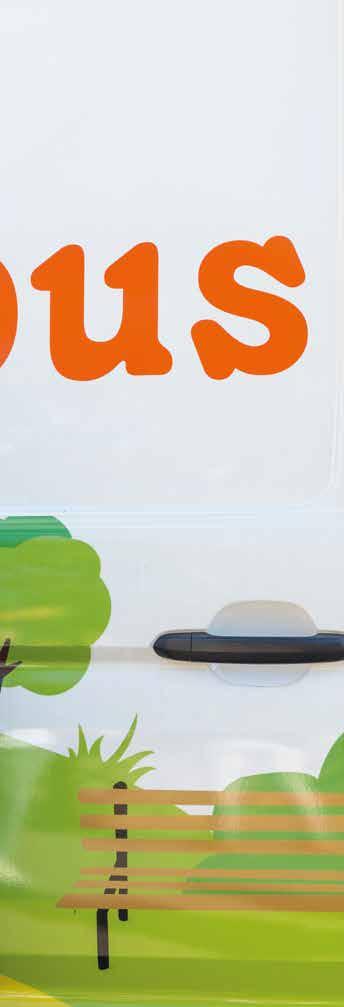
In the 1970s, VKE was the first bilingual association in South Tyrol: and that’s an important point. Since, we’ve become a multilingual association, attaching great importance to multiculturalism, both in the play centres and with our staff. From a small private initiative, VKE has grown to become one of the largest socio-educational associations in the country. We have 30 full-time staff, with an additional 250 seasonal staff for summer activities, 24 sections throughout South Tyrol and over 200 volunteers. In fact, women are in the majority with us. Our range of activities has also increased proportionally: diversity is the gateway into the world of children.
Where is there greatest demand?
With our holiday-time activities, we’ve noticed that most demand for care has increased during the school holidays. Our weeks at the summer retreat in Kohlern have really taken off in recent years. Family structures have changed and the pressure to perform has increased. Summer childcare is a pressing issue for families, with children desperate for opportunities to play and develop outdoors, with more exercise and less digital dependency - more freedom. We’re seeing an increase in helicopter parents; children “managed” at every turn, hardly trusted with anything anymore. In
27 REVAMIRP A / FRÜH LING / S P GNIR \
EN/ 2.©
this way, individual responsibility is weakened. We note: the original principles of VKE - namely the right to play and recreation, free play, self-empowerment in play, whether movement or handicrafts - have become more relevant than ever.
Do you see differences raising children in our multilingual South Tyrolean society?

The issue of safety tends to be important in urban areas and for Italian-speaking families, even in the playground. Everything should be secured with safety nets and foam rubber, etc. In the villages and in the more German-speaking context, free play outside tends to be the norm, in all weathers and seasons. In mixed playgroups in the city, these differences surface the most.
There are now a number of large green areas in Bolzano, especially along the Talvera river and open-air play areas on the outskirts. Bolzano was a child-friendly municipality in 1998. What can be improved today?

Managing the wearisome issue of safety, personal responsibility and liability. The many regulations and restrictions remove children's freedom. We do indeed have numerous children's playgrounds with the usual equipment, but almost no areas to experiment with stones, gravel, water, few opportunities for climbing or
balancing, no adventure playground for older childrenrespecting the TÜV safety framework, of course. Since 1994, we have given annual awards to child-friendly communities, for their special commitment to children - it's all about quality of life. Calculable risk plays an increasing role here, but children must be allowed to leave their bubble.
Looking back, we see that VKE co-wrote the historic Urbanisation Act of 1982, which makes at least 3 m2 of play space per inhabitant - and not per child! - man-

28
13.©
datory in every community's zone plan. But there is never enough green space, likewise for cycle paths. The very first concession for a cycle path in South Tyrol, south of Bolzano on the Adige dam, was also promoted by VKE. Today we’re working on the topic of safe routes to school, and with our Play Dreams project, we’re trying also to promote play areas for children in the courtyards and interspaces of apartment buildings.
If you visit Bolzano as a family, your children are more than welcome to take advantage of VKE activities, especially the play and fun days during the spring weeks.

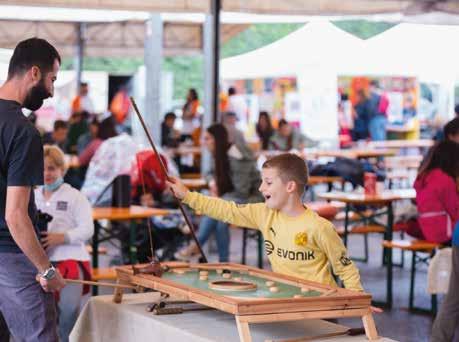
(ar/pb)
VKE CITY INFRASTRUCTURE
SpielHausBZ1 in Parco Mignone, Oltrisarco district, Mon-Fri 2.30-5.30 p.m.
SpielHausBZ2 in via Parma, Don Bosco district, Mon-Fri 3-6 p.m. Youth CentreBZ1 in Parco Mignone in the Oltrisarco district, 2-6 p.m.
VKE mobile play bus: play days programme
www.vke.it
THE VKE SPRING CALENDAR, BOLZANO
13th March: 20th anniversary of the via Parma SpielHausBZ2 playhouse with many on-site activities
7th May:
Children's Day
From 11 a.m. on the Lungo Talvera park and in Parco Petrarca, with play bus
28th May:
World Play Day
(with a street party - tbc)
Focal points at the VKE Youth Centre: intercultural cooking events, workshops, sustainable cosmetics day, Stop Racism Week
MiniBZ children's city for 7-14 year olds
19th -30th June, all day Mon-Fri
The summer holiday programme turns twenty in 2023, with surprises in store! As a prelude, these include a miniature city and giant role-playing game with more than 40 activities.
Day tickets or flexible weekly subscriptions can be purchased online in advance:
hiips://minibz.vke.it
www.vke.it
29 REVAMIRP A / FRÜH LING / S P GNIR \
14.©
13.©
UNA CITTÀ PER I PIÙ PICCOLI
UNA STORIA LUNGA QUASI 50 ANNI PER UN'ASSOCIAZIONE CHE SI IMPEGNA PER UNA VITA A MISURA DI BAMBINO, CON GIOCHI E DIVERTIMENTO. E CHE HA RESO RESILIENTE BOLZANO, CON AZIONI E INFRASTRUTTURE CHE VANNO A BENEFICIO ANCHE DELLE FAMIGLIE OSPITI.
L'"Associazione campi giochi e ricreazione" VKE è stata fondata nel 1974 da un piccolo gruppo di genitori per garantire più aree verdi e campi giochi per i bambini nel centro urbano. Lo spazio pubblico ne è protagonista e il VKE ha avuto un ruolo decisivo nel plasmarlo a Bolzano negli ultimi decenni. bm ha parlato della forza trainante del VKE per lo sviluppo della città con la sua direttrice Angelika Stuefer e la sua presidente Franca Riesch De Pasquale.
Come risponde il VKE alle mutate esigenze dei bambini?
Pare strano, ma negli anni Settanta il VKE è stata la prima associazione bilingue dell'Alto Adige. Nel frattempo, siamo diventati un'associazione multilingue e attribuiamo grande importanza all'interculturalità, sia nelle CaseGioco che tra il nostro personale. Da una piccola iniziativa privata, il VKE è cresciuto fino a diventare una delle più grandi associazioni socioeducative di tutta la provincia, con 30 dipendenti a tempo pieno e altri 250 stagionali per le attività estive, 24 sezioni distribuite in tutto l'Alto Adige e oltre 200 volontari.
Oggi a Bolzano ci sono molti spazi verdi, soprattutto lungo l'alveo del Talvera. Bolzano, inoltre, è un "Comune a misura di bambino" dal 1998…
Tuttavia, è sempre possibile migliorare. Parlo soprattutto della gestione della sicurezza e della questione relativa alla responsabilità. Le numerose norme e restrizioni tolgono molta libertà ai bambini; abbiamo infatti moltissimi parchi giochi per bambini con le solite attrezzature, ma quasi nessuna area sperimentale con pietre, ghiaia, acqua, strutture che aiutino a sviluppare l'equilibrio, nessun parco avventura per i ragazzi più grandi. Ogni anno, dal 1994, il VKE premia il "Comune amico dei bambini" per i suoi sforzi a favore dei bambini: si tratta di premiare la qualità della vita delle famiglie oltre che dei piccoli. Se visitate Bolzano con la famiglia, i vostri bambini sono i benvenuti nelle strutture del VKE:
LE INFRASTRUTTURE PER BIMBI IN CITTÀ

CasaGioco BZ1 nel Parco Mignone, Oltrisarco, lun-ven 14.30-17.30
CasaGioco BZ2 in via Parma, Don Bosco, lun-ven 15-18
Centro giovanile Parco Mignone, Oltrisarco, lun-ven 14-18
Ludobus: programma delle giornate di gioco vedi
www.vke.it
LA PRIMAVERA DEL VKE A BOLZANO
20° anniversario della CasaGioco
in via Parma il 13 marzo con numerose attività Giornata dei bambini
il 7 maggio dalle ore 11 sui Prati Talvera e nel Parco Petrarca con un ludobus
Giornata mondiale del gioco
il 28 maggio (con una festa di strada)
MiniBZ La Città dei ragazzi di Bolzano (dai 7 ai 14 anni)
19-30 giugno, lun-ven tutto il giorno
come preludio ai programmi delle vacanze estive: l’iniziativa compie 20 anni e ha in serbo sorprese nella città in miniatura con oltre 40 tipi di attività. Si consiglia di acquistare i biglietti giornalieri o gli abbonamenti settimanali flessibili in anticipo online:
hiips://minibz.vke.it
30
IT/ 14.©
www.vke.it
SPIELPLATZ STADT
EINE FAST 50-JÄHRIGE GESCHICHTE FÜR EINEN VEREIN, DER SICH EIN KINDGERECHTES LEBEN MIT SPIEL UND SPASS AUF DIE FAHNEN SCHREIBT UND BOZEN STARK GEMACHT HAT, MIT AKTIONEN UND INFRASTRUKTUREN, DIE AUCH GÄSTE NÜTZEN.
Der “Verein für Kinderspielplätze und Erholung” VKE wurde 1974 von einer kleinen Elterngruppe gegründet, um mehr Grün- und Spielflächen für Kinder in der Stadt zu garantieren. Der öffentliche Raum spielt dabei eine große Rolle, und diesen hat der VKE in den letzten Jahrzehnten in Bozen entscheidend mitgeprägt. bm hat mit der Leiterin Angelika Stuefer und der Präsidentin Franca Riesch De Pasquale über die Triebfeder VKE für die Entwicklung der Stadt Bozen gesprochen.
Wie reagiert der VKE auf die veränderten Bedürfnisse der Kinder?
In den 1970er Jahren war der VKE der erste zweisprachige Verein in Südtirol. Das muss man sich erst einmal vorstellen. Mittlerweile sind wir ein mehrsprachiger Verein, und wir legen großen Wert auf Interkulturalität, in den Spielhäusern und auch bei unseren Mitarbeiter:innen. Von einer kleinen privaten Initiative ist der VKE zu einem der landesweit größten Vereine im sozialpädagogischen Bereich gewachsen, mit heute 30 Hauptamtlichen und zusätzlichen 250 saisonalen Kräften für die Sommerangebote, 24 Sektionen verteilt auf ganz Südtirol, über 200 ehrenamtlichen Helferinnen.
Es gibt in Bozen mittlerweile viele Grünflächen v.a. am Flussbett der Talfer, Auslaufmöglichkeiten in der Peripherie. Bozen war 1998 ”kinderfreundliche Gemeinde“ …
Der Umgang mit dem leidigen Thema Sicherheit, Eigenverantwortung und Haftung ist allerdings ausbaufähig. Den Kindern werden mit den vielen Vorschreibungen und Einschränkungen Freiräume genommen; es gibt zwar wirklich viele Kinderspielplätze mit den üblichen Geräten, aber so gut wie keine Experimentierflächen mit Steinen, Schotter, Wasser, Balanciermöglichkeiten, Klettermöglichkeiten, keinen Abenteuer-Spielplatz für größere Kinder. Wir küren seit 1994 jährlich die ”kinderfreundliche Gemeinde“ für ihren besonderen Einsatz im Sinne der Kinder – da geht es um Lebensqualität. Die Kinder müssen aus ihrer Bubble raus dürfen.
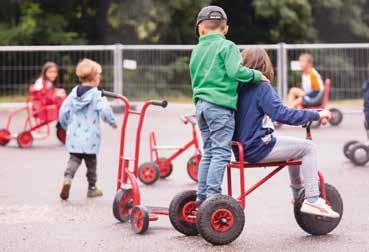
Wenn Sie Bozen als Familie besuchen, können Ihre Kinder das VKE-Angebot gern mitnützen.
DIE INFRASTRUKTUREN IN DER STADT
SpielHausBZ1 im Mignonepark, Stadtviertel Haslach/Oberau, Mo-Fr 14.30-17.30 Uhr SpielHausBZ2 in der Parmastraße, im Stadtviertel Don Bosco, Mo-Fr 15-18 Uhr JugendzentrumBZ1 im Mignonepark im Stadtviertel Haslach/Oberau, 14-18 Uhr VKE-Spielbus mobil: Spieltage-Programm siehe
www.vke.it
DER VKE-FRÜHLING IN BOZEN
20 Jahre Spielhaus Parmastraße am 13. März mit vielen Aktionen vor Ort
Tag des Kindes am 7. Mai ab 11 Uhr auf den Talferwiesen und im Petrarcapark mit Spielbus
Weltspieltag am 28. Mai (voraussichtlich mit Straßenfest)
Die Kinderstadt MiniBZ für 7-14-Jährige
19.-30. Juni, Mo-Fr ganztägig
als Auftakt zu den Ferienprogrammen im Sommer: Sie wird 20 Jahre alt und hält als Miniaturstadt und riesiges Rollenspiel mit mehr als 40 Tätigkeiten 2023 Überraschungen bereit. Tageskarten oder flexibles Wochenabo bereits vorab online erwerben:
hiips://minibz.vke.it
www.vke.it
31 REVAMIRP A / FRÜH LING / S P GNIR \
DE/ 14.©
I LOVE BOLZANO
Jedes Stadtviertel hat seine Atmosphäre, seine Sehenswürdigkeiten, seine Architektur und Urbanität, seine Natur und seine Menschen. In Bozen x 5.
Ogni quartiere urbano ha la sua atmosfera, le sue attrazioni, la sua architettura, la sua natura e la soprattutto la sua gente. A Bolzano x 5.
Each urban district has its own atmosphere, sights to see, architecture, natural world and above all its locals. In Bolzano x 5.

32 PHOTOSTORY
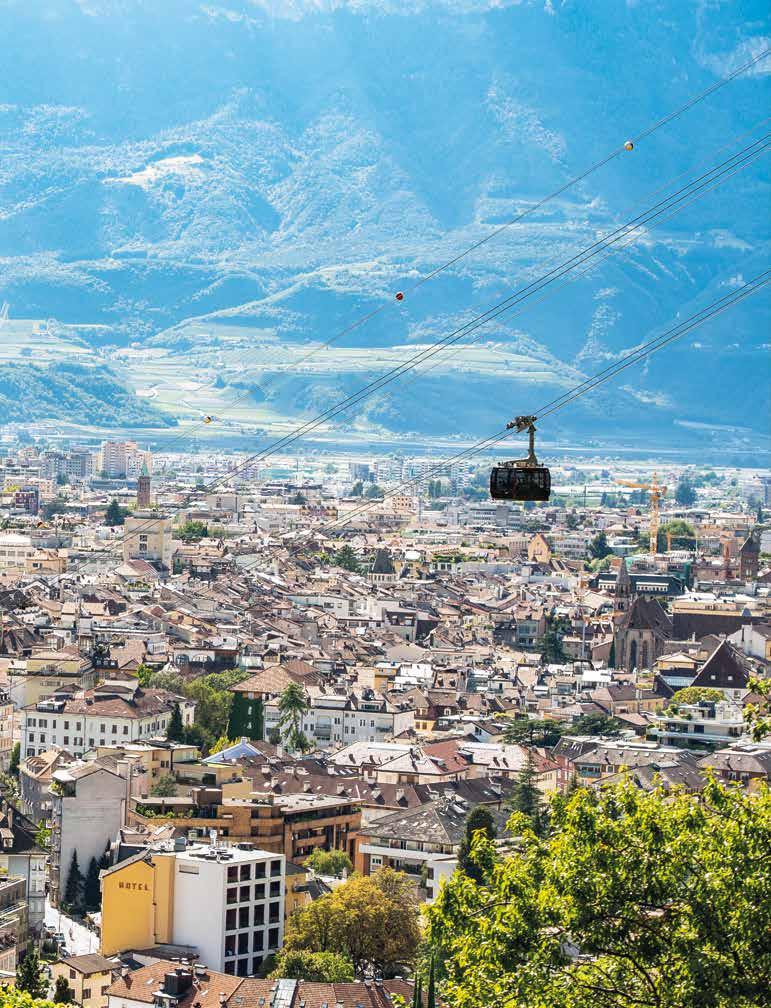
1.© 33 REVAMIRP A / FRÜH LING / S P GNIR \
Alessandra De Giorgi Azzolini
residente nel quartiere di Gries-S.Quirino, insegnante: sono nata e cresciuta a Gries, e sono tornata di recente. Mi rende felice passeggiare nel mio quartiere, tutto il verde e i siti culturali, camminare lungo le mura dell’Abbazia di Muri, ammirare la chiesa barocca di S. Agostino e l’antica chiesa parrocchiale di origine gotica. Gli orologi delle due chiese hanno sempre scandito il mio tempo.
Bewohnerin des Stadtviertels Gries-Quirein, Lehrerin: Ich bin in Gries geboren und aufgewachsen, von hier weggezogen und vor kurzem wieder hergezogen. Ich liebe diesen Kokon, das viele Grün und die Kulturstätten, an den Mauern des Klosters Muri Gries vorbeiziehen, die barocke Stiftskirche und die Alte gotische Pfarrkirche bewundern. Die Kirchturmuhren haben schon immer meine Zeit getaktet.
teacher and Gries-Quirein neighbourhood resident: I was born and raised in Gries, moved away, and now recently returned. I love this oasis, with all its greenery and cultural sites, walking past the walls of the Muri Gries monastery, admiring the baroque collegiate church and the old gothic parish church. The church clocks have always marked my time.

34
1.©
Bewohner des Stadtviertels Zentrum-Bozner Boden-Rentsch, Winzer: Rentsch hat trotz Urbanisierung seinen ländlichen Dorfcharakter bewahrt, mit Kirche und Gasthaus als Zentrum, und damit auch mit den engen Dorf-Beziehungen. Durch das Leben am Weingut sind wir umso mehr mit diesem Stadtteil und mit der Weinberg-Landschaft um St. Magdalena verwurzelt. Trotzdem sind wir mit dem Fahrrad in nur wenigen Minuten am Waltherplatz.
residente nel quartiere Centro-Piani-Rencio, viticoltore: nonostante l'urbanizzazione, la zona di Rencio ha conservato il suo carattere di villaggio rurale, con la chiesa e la locanda come centro, e quindi anche con le strette relazioni tipiche di un paese. Grazie alla mia esperienza in cantina, io e la mia famiglia siamo ancora più radicati in questa zona della città con il suo fantastico paesaggio viticolo intorno alla collina di Santa Maddalena. E poi siamo a pochi minuti di bicicletta dal centro storico.
resident of the Centre-Bozner Boden-Rentsch district, winemaker: Despite urbanization, Rentsch has preserved its rural village character, with the church and inn at its centre, and the same with the close village relationships. Because of our life at the winery, we’re all the more rooted to this part of town and in the vineyard landscape around St. Magdalena. Yet, we’re only a few minutes away from Waltherplatz by bike.

35 REVAMIRP A / FRÜH LING / S P GNIR \
Christian Plattner
1.©
Andrea Chiodarelli
residente nel quartiere Europa-Novacella, gioielliere: via Milano è la strada che non solo ha plasmato la mia infanzia e giovinezza, ma anima anche il quartiere con gli storici negozi a conduzione familiare uno accanto all’altro. Il nostro negozio è stato aperto da mio nonno nel 1952. La stessa storia vale per il macellaio, l'ottico, la farmacia di quartiere. Nel frattempo ci sono stati cambiamenti generazionali, ma come quartiere siamo ancora una specie di famiglia allargata con legami molto stretti.
Bewohner des Stadtteils Europa-Neustift, Juwelier: Die Mailandstraße ist in meinem Viertel jene Straße, die nicht nur meine Kindheit und Jugend geprägt hat, sondern das Viertel mit den historischen familiengeführten Geschäften Tür an Tür belebt. Unser Geschäft gibt es seit 1952, mein Opa hat es eröffnet. Ähnliches gilt für den Metzger, Optiker, die Apotheke, mittlerweile hat es Generationenwechsel gegeben, doch als Viertel sind wir nach wie vor ein erweiterter Familienkreis mit engen Bindungen.
jeweller, Europa-Neustift district resident: In my neighborhood, via Milano is not only the street that shaped my early years, it’s also a parade of historic familyrun shops. Ours has been there since 1952, when my grandfather opened it. The same goes for the butcher, optician and pharmacy. There have of course been generational changes, but as a neighbourhood, we’re still an extended family circle with close ties.

36
1.©
Eva Locher
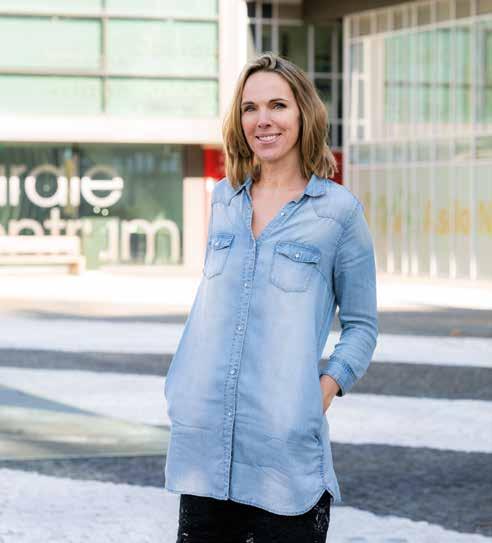
Bewohnerin des Stadtteils Oberau-Haslach, Psychologin: Ich bin eine Zugewanderte (im Südtiroler Dialekt ”Zugroaste“) und habe hier in Haslach mit meiner Familie meine Dimension gefunden, auch weil das Viertel sehr familienfreundlich ist: Hier gibt es im Umkreis von wenigen Gehminuten Schulen, eine tolle Bibliothek (im Hintergrund), Spiel- und Sportstätten, eine Kirche, eine gute Anbindung mit den Öffis und dem Fahrrad. Und wir haben’s ruhig und sehr grün, mit der Virglpromenade, die hinterm Haus startet, und der Haselburg über unseren Köpfen.
residente nel quartiere Oberau-Haslach, psicologa: Sono un'immigrata (in dialetto sudtirolese si parla di arrivata dopo), ma qui ad Aslago ho trovato la mia dimensione subito, perché se si hanno bambini piccoli è facile innamorarsi di questo quartiere: a pochi minuti a piedi ci sono scuole, un'ottima biblioteca (sullo sfondo), strutture ludiche e sportive, una chiesa. E poi Aslago è collegata benissimo sia con i mezzi pubblici che con la ciclabile. Chi cerca tranquillità e verde, si trova bene qui, con la Passeggiata del Virgolo dietro casa e Castel Flavon sopra le nostre teste.
resident of the Oltrisarco-Aslago district and psychologist: I’m an immigrant (in South Tyrolean dialect Zugroaste) and have found my home with my family here in Aslago, as the district is very family-friendly. There are schools within a few minutes' walk, a great library (in the background), play and sports facilities, a church, good public transport and bike connections. And we have it quiet and very green, with the Passeggiata del Virgolo, which starts behind the house, and the Haselburg castle above our heads.
37 REVAMIRP A / FRÜH LING / S P GNIR \
1.©
Fabrizio TiglianI

residente nel quartiere Don Bosco, cuoco e pizzaiolo: Il mio quartiere, nato dal conglomerato industriale delle Semirurali costruito negli anni Trenta, è un grande villaggio. Qui tutti conoscono ancora (quasi) tutti, e si coltivano il vicinato e la solidarietà. Quando esco a portare fuori la spazzatura o a prendere il pane all‘angolo - come quando ero bambino e giocavo in cortile - ci metto più tempo del previsto, perché è impossibile non fermarmi a chiacchierare con vecchi e giovani conoscenti. Girare per il quartiere è come andare dal bagno al salotto.
Bewohner des Stadtviertels Don Bosco, Pizzaiolo-Koch: Unser Viertel, aus dem Industriekonglomerat der 1930er Jahre entstanden, ist ein großes Dorf. Immer noch kennt jeder (fast) jeden, Nachbarschaft und Solidarität werden gepflegt, die Wege sind kurz. Wenn ich den Müll rausbringe oder zum Bäcker laufe – denselben meiner Kindheit -, brauche ich länger als geplant, denn ich treffe immer Bekannte und Freunde, Alt und Jung, mit denen ich mich gern verplaudere.
pizza chef and Don Bosco neighbourhood resident: Our neighbourhood, which grew out of the industrial zone in the 1930s, is a big village. Everyone still knows (almost) everyone, neighbourliness and solidarity are cultivated and the distances are short. When I take out the rubbish, or walk to the bakery – just as I did as a kid - it takes me longer than planned, because I always run into friends and acquaintances, old and young, who I enjoy chatting with.
38
1.©

8.©
BOZEN HOLT TIEF ATEM
Ostermarkt, Ostermenü, Gastronomische Wochen, Weinkost, Blumenmarkt, Kunstgarten und VeloFlora, Musik, Theater und Tanz – eine Stadt blüht auf.

40 SAISON
Es wurde Frühling, wie schon so viele tausend Male in der Welt, und wieder sagten viele Menschen wie vorher und wie sie noch immer wieder sagen werden: So schön war der Frühling noch nie. Die Blumen schossen so geschwind aus der Erde heraus, wie fröhliche Gedanken in Kinderherzen aufblühen, und die Büsche hatten es eilig, sich in grüne Schleier zu hüllen.

Was die deutsche Kinderbuchautorin der Jahrhundertwende hier gekonnt einfängt, ist die euphorische Stimmung von Aufbruch und Vorfreude auf die Zeit im Freien, auf die Wiedergeburt in der Natur als Spiegel unseres Inneren. Bozen wird schon früh wachgeküsst von den Erdkräften, das milde Klima und der Wärmespeicher des Bozner Porphyrs an den Sonnenhängen der Stadt lassen das Sprießen eher beginnen, ebenso das Frühlingstreiben, mit dem Stadtleben, das sich bereits Ende Februar/Anfang März plötzlich nach außen stülpt.
Das Verkehrsamt und die Kulturschaffenden der Stadt Bozen arbeiten fürs Frühjahr immer wieder ein dichtes Veranstaltungsprogramm mit Konzerten, Kunstinstallationen, Kulinarischem und Florealem aus, Tourismus vernetzt sich stark mit Kultur, sprengt Grenzen und schafft Begegnung. Ob dies nun beim Essen, Staunen, Lauschen, Flanieren oder Einkaufen ist.
41 REVAMIRP A / FRÜH LING / S P GNIR \
Josephine Siebe, in: Die Tasse des Königs, 1916
DE/ 3.©
OSTERMARKT
”SPRING IN THE CITY“ IN BOZEN
6.-10. April im Zeichen von Kunst & Kultur
eine farbenfrohe Veranstaltung als Auftakt der Saison im Freien auf dem zentralen Waltherplatz mit über 20 Ausstellern und Handwerksständen mit live-Musik verschiedener Genres mit Kochshows und mit Kulinarischem an den Ständen und in den Restaurant des Zentrums mit 5 Tagen Programm
(kreative Workshops der Südtiroler Bäuerinnen für Osterdekorationen aus der lokalen Tradition und mit natürlichen Materialien) mit Kinder-Aktivitäten (Karussell, kleiner Zug, Osterbastel-Einheiten)
mit der traditionellen Eiersuche und dem rituellen Eierpecken am Festtag
HIGHLIGHT AM OSTERMONTAG:
großes Gourmet-Schaukochen mit Ostergerichten unter dem Vorsitz des Slow Food Convivium Südtirol

mit Herbert Hintner
(Gasthaus Platzegg, Eppan)
Filippo Sinisgalli (Zur Kaiserkron, Bozen)
Daniel Hintner (Zur Rose, Eppan) und Matteo Taccini (Restaurant Laurin, Bozen)
Neben den herkömmlichen Südtiroler Spezialitäten und Oster-Naschereien wie Schoko-Eiern, Colomba (süßes Hefegebäck in Schwalbenform), heimischem Käse, Craft Beer und Speck warten die Stände auf mit Kreationen aus Glas, Messing und Wolle, mit Dekorationen aus Papier, Körnerkissen, Spieldosen, Bildern, handgefertigten Kerzen, ätherischen Ölen, Holzkreationen, auch Textilien aus hochwertiger Seide, Leinen, Eukalyptus- oder Bambusholz. Ebenso stellen Lederhandwerker:innen direkt auf dem Waltherplatz ihre Arbeit vor. Bei alledem kommen die zwei Protagonisten jeder Feier nicht zu kurz: Blumen und Wein – aus der unmittelbaren Gegend.
Der Ostermarkt wird unter der Schirmherrschaft der Stadtgemeinde Bozen und in Zusammenarbeit mit Signa Waltherpark, Spezialbier-Brauerei Forst und Sparkasse organisiert.
Wer gern weiterstöbert und Kunsthandwerk liebt oder auf der Suche nach originellen Mitbringseln ist, der kann während der Ostertage auch den Rittner Ostermarkt MUSE besuchen, am 7., 8. und 10. April. Im Park des Hotels Post-Victoria in Oberbozen wird Handgefertigtes, also Unikate aus Ton, Holz, Wolle und Glas ausgestellt und verkauft – eine Inspirationsquelle für Kreative.

24 Tage lang, vom 30. April bis zum 15. Mai, wartet Bozen mit Kunstgarten Bozen auf, mit Konzerten, Kunst-Installationen und Auftritten von Schauspieler:innen. Hinzu kommen noch der Blumenmarkt am Waltherplatz (30. April bis 1. Mai), der Wettbewerb BiciInFiore, die Food&Flowers-Gastronomiewochen und das Vintage-Bike-Event VeloFlora. Der Frühling in der Südtiroler Landeshauptstadt wird auf- und anregend:
www.bolzano-bozen.it
Kunstgarten Bozen bringt Vielfalt, Farbe, Kultur und Unterhaltung in alle Winkel der Stadt: Ein Installationsparcours der Vereinigten Bühnen Bozen VBB mit Installationen von
42
15.© 17.©
Künstler:innen aus der Euregio beginnt auf den Talferwiesen und zieht sich bis in die Altstadt hinein, daneben sind Veranstaltungen in der Industriezone und im nahen Semirurali-Park im Süden der Stadt geplant . Zum Abschluss besticht ein Jazzkonzert, in Zusammenarbeit mit dem Südtirol Jazz Festival organisiert. Zuvor gibt es eine Reihe von Veranstaltungen unter der Leitung des Konservatoriums, der VBB, der Haydn-Stiftung, des Teatro Cristallo, der Murx Theater & Academy, des Teatro Stabile, der Musikschule Vivaldi, des Museion, von Tanz Bozen.
Der 133. Blumenmarkt – eine Rekordveranstaltung
Am Sonntag, 30. April und Montag, 1. Mai findet der traditionelle Blumenmarkt statt: eine farbenfrohe, duftende Blumenschau mit Verkaufsständen und Gartenecken mitten im Stadttreiben des Waltherplatzes – sie verwandelt das Zentrum in eine begehrte und bunte Gärtnerei. Neben Musik und Gaumenfreuden (die Food&Flowers Gastronomiewochen paaren sich hervorragend mit dem BlumenHighlight) werden auch Kreativworkshops und Termine mit Slow-Food-Experten auf dem Programm stehen. So stehen Florist:innen allen Interessierten bei der Auswahl des perfekten Bouquets mit Rat und Tat zur Seite, und Kinder dürfen in der Kräuterecke Neues lernen. Ein Highlight der Veranstaltung ist dabei immer das Fest der Stadtkapelle Bozen am Kornplatz sowie die Konzerte der Musikkapelle Zwölfmalgreien und des Corpo Musicale Mascagni am Rathausplatz. Fotomotive und Ahas bietet der Schönheitswettbewerb BiciInFiore, der das schönste Fahrrad mit der originellsten Blumendekoration ehrt.

Veloflora
Wer Fahrräder, Vintage-Kleidung oder gar beides liebt, wird anlässlich des Blumenmarktes in Bozen fündig: Bei VeloFlora am 1. Mai dreht sich alles um den guten alten Drahtesel, Kultur und Spaß. Dazu gehören Radausflüge, Vorträge, eine Stadt-

rundfahrt im Oldtimer-Kostüm auf Fahrrädern, die vor 1980 gebaut wurden.
Der Besichtigungsreigen startet neu Sämtliche Stadtführungen des Verkehrsamts beginnen im Frühling mit ihren Fixterminen, von den Palazzi in der Altstadt (montags) über die Zeitreise im Don-Bosco-Viertel (jeden ersten Donnerstag im Monat) bis hin zu Rundgängen durch Bozen bei Nacht oder das verborgene Bozen (jeden zweiten Donnerstag im Monat). Besonders lehrreich sind die Führung durch das Industriegebiet von Bozen und das technologische Viertel (jeden dritten Donnerstag im Monat) sowie die Besichtigung des faszinierenden Benediktinerklosters Muri Gries und der alten Grieser Pfarrkirche (jeden vierten Donnerstag im Monat).
Ausflüge zu Museen und Schlösser
Sobald die Temperaturen es wieder erlauben, öffnen auch Burgen und Ansitze wieder ihre Tore, und die acht Museen der Stadt starten mit ihrem Frühlingsprogramm und einigen Aktionen im Freien. Und wenn Sie das Glück haben, Anfang Juni in Bozen zu sein, lassen Sie sich von der Veranstaltung Castelronda bezaubern: Sie ermöglicht eine Zeitreise ins Mittelalter über den Besuch von sechs bevölkerten und bespielten Burgen in Bozen und Eppan (2.-4. Juni) (ar)
43 REVAMIRP A / FRÜH LING / S P GNIR \
16.© 1.©
BOLZANO FA UN RESPIRO PROFONDO
MERCATINO DI PASQUA, PRIMAVERA IN TAVOLA, DEGUSTAZIONI DI VINI, MERCATO DEI FIORI, VELOFLORA, MUSICA, TEATRO E DANZA: UNA CITTÀ IN FIORE.
Bolzano è baciata dal risveglio precoce delle forze della natura; il clima mite e il porfido di Bolzano sui pendii soleggiati della città permettono una fioritura lunga e colorata. L’Azienda di Soggiorno e gli operatori culturali della città di Bolzano collaborano ad un fitto programma di eventi per la primavera con concerti, installazioni artistiche, eventi culinari e floreali. Che si tratti di mangiare, di stupirsi per la bellezza o di ascoltare, passeggiare e fare shopping, il turismo fa rete con la cultura, abbattendo confini e creando occasioni di incontro.
SPRING IN THE CITY
Mercatino di Pasqua a Bolzano
dal 6 al 10 aprile sotto il segno dell'arte e della cultura nella centralissima Piazza Walther

un evento colorato per inaugurare la stagione all'aperto con oltre 20 espositori e bancarelle di artigianato, musica dal vivo di vari generi, cooking shows e delizie culinarie proposte sia dalle bancarelle che dai ristoranti del centro.
E ancora: laboratori creativi basati sulle tradizioni locali, attività ludiche e di bricolage per bambini e, imperdibili nel giorno di festa, i riti pasquali come la tradizionale caccia al tesoro, in questo caso l’uovo, insieme alla sfida “ Eierpecken” – una specie di battaglia delle uova sode (chi non le rompe le vince).
Per 24 giorni, dal 30 aprile al 15 maggio, Bolzano si presenta con la Bolzano In Fiore Arte: concerti, installazioni artistiche e performance di attori in piazza. A ciò si aggiungono il tradizionale mercato dei fiori in Piazza Walther (dal 30 aprile al 1 ° maggio), il concorso BiciInFiore, le settimane gastronomiche Food&Flowers e l'evento dedicato alle bici d'epoca VeloFlora. La primavera nel capoluogo altoatesino si prospetta stimolante:

Anche il programma di visite turistiche prende il via in primavera. Tutti i tour della città offerti in primavera dall’Azienda di Soggiorno partono a date fisse aprendo le porte dei palazzi del centro storico (il lunedì), con proposte che vanno dal viaggio nel tempo nel quartiere Don Bosco (ogni primo giovedì del mese) fino ai tour della Bolzano notturna o della Bolzano nascosta (ogni secondo giovedì del mese). Particolarmente istruttive sono la visita guidata alla zona industriale di Bolzano e al quartiere tecnologico (ogni terzo giovedì del mese) e la visita all'affascinante monastero benedettino di Muri Gries oltre all'antica chiesa parrocchiale di Gries (ogni quarto giovedì del mese).
Escursioni a musei e castelli
Non appena le temperature lo permettono, anche i castelli e i manieri riaprono le loro porte e gli otto musei della città iniziano i loro programmi primaverili con attività all'aperto. E se avete la fortuna di trovarvi a Bolzano all'inizio di giugno, lasciatevi incantare dall'evento Castelronda: vi permette di viaggiare indietro nel tempo fermandosi al Medioevo e visitando sei castelli brulicanti di vita e cultura a Bolzano e Appiano (2-4 giugno).
44
www.bolzano-bozen.it
IT/ 18.© 1.©
BOLZANO TAKES A DEEP BREATH
THE EASTER MARKET, EASTER MENU, GASTRONOMIC WEEKS, WINE TASTING, THE FLOWER MARKET, ART GARDEN AND VELOFLORA, MUSIC, THEATRE AND DANCE: BOLZANO - A CITY IN BLOOM.
Bolzano is awoken early by the forces of nature, with the mild climate and heat stored in the Bolzano porphyry on the sunny slopes, all allowing the city to bud colourfully and early. The tourist office and the cultural workers of the city of Bolzano always prepare a dense programme of events for the spring. There are concerts, art installations, food and flowers, tourism intertwined with culture, boundaries broken and encounters created. Whether this is eating, having your breath taken away, listening in, strolling or shopping.
For 24 days, from 30th April to 15th May, the city awaits you. Art Garden Bolzano has concerts, art installations and performances with actors. What’s more is that there’s the Flower Market at Piazza Walther (30th April to 1st May), the BiciInFiore competition, the Food&Flowers gastronomy weeks and the VeloFlora vintage bike event. Spring in the South Tyrolean capital will be upbeat and inspiring:
www.bolzano-bozen.it
Sightseeing also begins anew
EASTER MARKET “SPRING IN THE CITY” IN BOLZANO
6th -10th April under the banner of art & culture at the central Piazza Walther
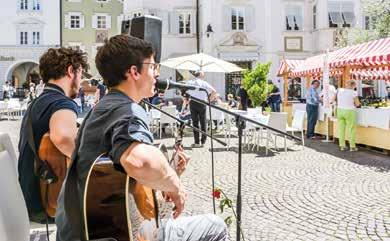
A colourful event preludes the outdoor season
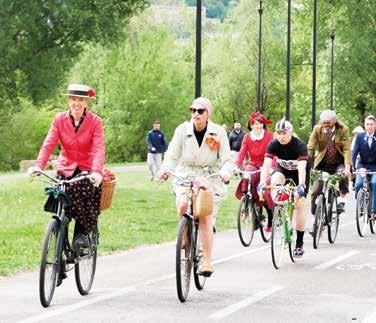
With more than 20 exhibitors and craft stalls, live music of various genres, culinary shows and delights at the stalls and in the city’s restaurants; with creative workshops from the local tradition, children's activities and Easter rituals, such as the traditional egg hunt and egg pecking on the feast day.
The tourist office’s city tours all start in spring. From the palazzi in the historical centre (Mondays), to the journey through time in the Don Bosco quarter (every first Thursday of the month). Even Bolzano by night tours or discovering the hidden Bolzano (every second Thursday of the month). Particularly illuminating are the guided tours of Bolzano’s industrial zone and technological quarter (every third Thursday of the month); or visits to the fascinating Benedictine monastery of Muri Gries and the old parish church of Gries (every fourth Thursday of the month).
Museums and castle trips
As soon as the temperatures permit, our castles and manor houses open their doors again, and the eight city museums begin their spring programmes and outdoor activities. If you are lucky enough to be in Bolzano at the beginning of June, you’ll be enchanted by the Castelronda event, which takes you back in time to the Middle Ages, with visits to six inhabited castles with performances, in Bolzano and Appiano (2nd – 4th June).
45 REVAMIRP A / FRÜH LING / S P GNIR \
EN/ 1.© 1.© 16.©
Recipe
I love you so "much" - Scallop and Beetroot Salad
For the Easter festivities and beyond, bm Magazine has chosen a recipe that’s a joy for the palate and looks impressive on the dinner table. The dish is a gift from chef Michael “Much” Rabensteiner of Parkhotel Laurin Restaurant in the centre of Bolzano. Michael has been a member of the Parkhotel Laurin team for several years now, and his keen creativity and selection of natural products mean the dishes always have a special touch - all while using simple, zero km ingredients. He’s passionate about our province, and finding the harmony and synergy between tradition and innovation.
I love you so "much" - Scallop and Beetroot Salad
A play on words that incorporates the chef's name and that reminds of the rebirth of nature and, consequently, of our emotions, where at the centre love resides in all its forms. A hymn to freshness, with which we look at the new robe that spring bestows on nature, more colourful, fresher and more engaging, just like the scallop and beetroot salad. The recipe is inspired by the naturalness of our surroundings and from bright colours enhancing simplicity.
INGREDIENTS for 4 people:
• 1 Cooked beetroot
• Beetroot leaves
• 12 Scallops (from a good fishmonger)
• Extra virgin olive oil
• 1 Frisée salad
• Salt & pepper to taste
• A knob of butter
• Rosemary to taste
• Lemon juice to taste
PREPARATION
Finely chop the beetroot. Marinate with extra virgin olive oil, salt, pepper, lemon juice – all to taste - and lay on a plate. Heat a frying pan with a drizzle of oil, sauté the scallops on both sides for up to 20 seconds, then toss with a knob of butter and some rosemary.
Arrange the freshly seared scallops on the bed of beetroot and frisée salad, dress the dish with drops of extra virgin olive oil, and serve.
Buon appetito!
46



47 REVAMIRP A / S P GNIR \ 19.©
19.© 19.©
BRINDARE ALLA VITA
Una delle tradizioni più longeve nella carrellata bolzanina di eventi primaverili è quella della Mostra dei vini, a Castel Mareccio.

48
GOURMET
Cavatappi all’opera per la 97esima volta a Bolzano, in occasione della rassegna vinicola più attesa all’inizio della rigogliosa stagione altoatesina: dal 20 al 24 aprile 2023 all’interno di Castel Mareccio, in pieno centro città, una quarantina di cantine locali presentano i loro migliori vini. Si tratta della più antica manifestazione enologica della regione (dal 1896 con poche interruzioni). L’ambiente è tra i più affascinanti della città e lo sfondo uno dei più spettacolari, specialmente in primavera, quando il verde esuberante contrasta con la neve sulle cime rocciose delle Dolomiti. Un tripudio di superlativi per la costellazione di cantine storiche, artefici di spirito innovativo, etichette rinomate, e soprattutto buon vino. Gli intenditori di vino e coloro che aspirano a diventarlo, possono degustare oltre 170 etichette delle zone vinicole di Bolzano e dintorni, Oltradige e Bassa Atesina, anche della Valle Isarco e del Meranese. Alla mostra, oltre al vino, saranno presenti i produttori con il loro patrimonio di esperienze e saperi, ma anche alcuni cuochi famosi, intenditori e sommelier.
a Castel Mareccio dal 20 al 23 aprile
Inaugurazione:
20.4. alle ore 17
20.4. ore 17-23
21.-22.4. ore 10-22
23.4. ore 10-20
Ingresso:
€ 20 (5 buoni consumazione)
Seminari: € 5
Il percorso che celebra il vino inizierà però già prima della rassegna (e poi durante): nei ristoranti di Bolzano si potranno vivere esperienze culinarie uniche e di alto livello, verranno proposte visite guidate alla scoperta della città e delle zone vinicole di Bolzano e si organizzeranno incontri con i viticoltori. L’evento è nato dalla collaborazione con l’Associazione Sommelier Alto Adige, con i produttori stessi, il Consorzio per la Tutela del Vino S. Maddalena e altri importanti operatori del settore vitivinicolo.
www.bolzano-bozen.it
Contestualmente alla Mostra dei vini, il Consorzio per la Tutela del Vino S. Maddalena festeggerà i 100 anni di attività con alcune sorprese nel programma di degustazione. Al centro, naturalmente, uno dei due rossi autoctoni bolzanini – il Santa Maddalena (uve Schiava) con il suo tocco elegante e fine che richiama la sua origine, le sontuose pergole sui pendii esposti al sole a nord-est di Bolzano.
La storia la dice lunga
Nella sua ricerca storica l’esperto di vini bolzanino Helmuth Scartezzini ha ricostruito le radici dell’evento più atteso per il settore: le prime iniziative tese alla promozione della viticoltura nel Tirolo storico risalgono a molto prima del 1896, quando a Bolzano fu costituita l’associazione affiliata alla Kaiserlich, Königliche Landwirtschaftsgesellschaft von Tirol und Vorarlberg (“Imperialregia società degli agricoltori del Tirolo e del Vorarlberg”). Tra il 1840 e il 1845 in città si realizzò un vivaio sperimentale per tentare la coltivazione di varietà esogene di viti, gelsi e alberi da frutto. In questo periodo l’associazione bolzanina partecipò all’assemblea generale degli agricoltori e silvicoltori tedeschi svoltasi a Monaco di Baviera, mettendo a disposizione anche diverse varietà di uva. Si ha pertanto un’idea di quali fossero le coltivazioni dell’epoca: Peverella bianca, Marzemino, Negrara, Lagrein, Schiava, Chasselas,

20.© 49 REVAMIRP A / FRÜH LING / S P GNIR \
IT/
LA 97° EDIZIONE DELLA MOSTRA DEI VINI WEINKOST
Terlano bianco, oltre a uve selvatiche. Nell’impianto sperimentale si coltivavano anche le varietà Malvasia, Pinot grigio, Pinot, diversi Moscati e qualche varietà di origine francese. Fu nel 1864 che presso la Camera di commercio di Bolzano si assaggiarono per la prima volta i vini ottenuti da vitigni autoctoni e prodotti da ca. venti cantine della zona. La manifestazione fu un successo e si allargò ogni anno; nel 1873 l’associazione inviò a Vienna per l’Esposizione mondiale 99 tipi di uva da pasto e 46 di uva da vino (ma nessun vino). Nel 1896 arrivò il momento di degustare e premiare i vini locali durante il primo mercato primaverile dei vini (Frühjahrsweinmarkt), svoltosi in marzo presso la Torgglhaus, l’attuale Casa al Torchio. Dalla terza edizione la sua denominazione cambiò in “Mercato dei vini di Bolzano” (Bozner Weinmarkt). Fino agli anni Ottanta del secolo scorso la manifestazione conservò il suo carattere di mercato vinicolo con produttori e commercianti che si incontravano con i loro clienti per degustare i vini e concludere affari. Dopo la Seconda Guerra mondiale avvenne una sorta di rinascita con la denominazione attuale, rimasta invariata dal 1947, mentre cambiarono spesso le sedi dell’evento, dai grossi alberghi di Bolzano si passò infine a Castel Mareccio negli anni Novanta.
Brindare alla (buona) vita
Nell'immaginario collettivo, l'apertura di una bottiglia di vino è associata a momenti gioiosi, in cui la convivialità fa da padrone. Brindare alla salute e alla vita è un’usanza in tutto il mondo. Ma lo sai perché si dice cin cin per il brindisi? La ragione va ricercata parecchio indietro nello spazio e nel tempo, in Cina e sicuramente prima del
THE REBE WINE TRAIL

A new hiking trail has recently been created, connecting the city of Bolzano and the Rittner Plateau, with panoramas and stops to take a pause or refreshments along the way. The path takes you through woodlands, chestnut groves and of coursevineyards. You start out (or end up) in Bolzano, at the historic St. Magdalener wine zone. From Bolzano, the path runs via St. Justina up to Signat. Along the way, the wide variety of local grapes can be seen close up, including Riesling, Kerner, Müller-Thurgau, Pinot Blanc, Pinot Gris, Pinot Noir, Chardonnay, Sauvignon, Gewürztraminer, Merlot, Vernatsch, Rosenmuskateller and finally Lagrein! Installation art pieces along the way offer insights into the culture of local viticulture. The internationally acclaimed artist Filip Moroder Doss, from Val Gardena, has used Corten steel and concrete for his works of silence and the information panels on the cultivation and culture of the vineyards. There’s a 500m difference in altitude on the ascent, usually taking under two hours. A leaflet with a map and detailed information is available at the information desk in Bolzano and on the Ritten. The Rebe wine trail can also be reached easily by public transport and the Ritten Tourism Association organizes guided hikes (advance reservation necessary). www.ritten.com
Settecento, quando se ne hanno le prime testimonianze in Europa. Il significato si può sintetizzare in "prego, prego" e pare nasca da un cortese ringraziamento tra marinai cinesi, anche come formula benaugurante per una felice navigazione. Ma perché l‘espressione è stata trasferita nel contesto del brindisi? Per via del colonialismo, con marinai inglesi salpati per la Cina e poi tornati in Europa con la stiva piena di beni orientali e qualche novità anche in merito alle usanze. Di questa formula rimane lo spirito benaugurante che ricorda il senso stesso del brindisi, inteso proprio come forma di buon augurio. Il suo valore onomatopeico sembra descrivere il suono dei calici che cozzano insieme e questo l’ha certamente reso internazionale molto velocemente. Anche se il galateo lo boccia insieme al tocco dei bicchieri, brindare senza cin cin non pare una buona scelta. Quindi: cin cin a tutti, fuori e dentro la Mostra dei vini di Bolzano!
(ar)
50
1.©
BOLZANO WINE TASTINGCHEERS!
THE MARECCIO CASTLE WINE SHOW: ONE OF THE LONGEST-RUNNING TRADITIONS IN BOLZANO'S SPRING EVENTS CALENDAR.

Corkscrews will be busy for the 97th time in Bozen, at the most eagerly awaited wine show at the start of the South Tyrol’s lush spring season. From 20th to 24th April, 2023, inside the city centre’s Mareccio Castle, some 40 local wineries present their best wines. The setting is one of the most charming in the city: the snow-covered, rocky peaks of the Dolomites in the background contrast magnificently with the exuberant greenery all around, especially in spring. A riot of superlatives for the constellation of historic wineries, creators and innovators, renowned labels, and above all good wine. Wine connoisseurs, and those aspiring, can sample more than 170 labels from the wine-growing areas of Bolzano and environs, Oltradige and Bassa Atesina, the Eisack Valley and Merano. In addition to the wine, the exhibition will feature producers brimming with experience and knowledge, as well as famous chefs, connoisseurs and sommeliers.
At the same time as the Wine Exhibition, the St. Magdalena Wine Preservation Consortium will celebrate its 100th anniversary, with some surprises in the tasting programme. The focus, of course, will be on one of Bolzano's two native reds: St. Magdalena (Schiava grapes), with its elegant and refined touch, recalling its origins - the sumptuous pergolas on the sun-exposed slopes, northeast of Bolzano.
THE 97TH EDITION OF THE WINE EXHIBITION – WINE-TASTING
At Mareccio Castle from 20th – 23rd April
Inauguration: 20th April at 5 p.m.
20th April - 5-11 p.m.
21st April – 10 a.m.-10 p.m.
23rd April – 10 a.m.-10 p.m.
Admission: €20 (with 5 drinks vouchers)
Seminars: €5
www.bolzano-bozen.it
In his historical research, Bolzano wine expert Helmuth Scartezzini reconstructed the roots of the industry's most anticipated event. The first initiatives aimed at promoting viticulture in the historic Tyrol date back to well before 1896, when the association affiliated with the Kaiserlich, Königliche Landwirtschaftsgesellschaft von Tirol und Vorarlberg was established in Bolzano. Between 1840 and 1845, an experimental nursery was set up in the city to attempt the cultivation of exogenous varieties of vines, mulberry and fruit trees. Crops at the time included Peverella bianca, Marzemino, Negrara, Lagrein, Schiava, Chasselas, and Terlano bianco, as well as wild grapes. It was in 1864 that wines made from native grape varieties, produced by around twenty wineries in the area, were tasted for the first time at the Bolzano Chamber of Commerce. The event was a success and expanded every year. After the Second World War, it was revived and given its present name.
51 REVAMIRP A / FRÜH LING / S P GNIR \
EN/
20.©
PROSIT WEINKOST BOZEN!
EINE DER ÄLTESTEN TRADITIONEN IM LAUF DES BOZNER FRÜHLINGS IST DIE WEINAUSSTELLUNG AUF SCHLOSS MARETSCH.

Zum 97. Mal drehen sich in Bozen die Korkenzieher anlässlich der mit Spannung erwarteten Weinkost zu Beginn der blühenden Saison: Vom 20. bis 24. April 2023 präsentieren rund 40 lokale Weinkellereien ihre besten Weine auf Schloss Maretsch, mitten im Stadtzentrum zwischen historischen Rebstöcken. Die Umgebung ist eine der grünsten der Stadt und die Kulisse eine der spektakulärsten, besonders im Frühling, wenn das üppige Grün in all seinen Variationen sich vom Schnee auf den felsigen Gipfeln der Dolomiten abhebt. Es ist eines der ersten und wichtigsten Wein-Treffen für die Kellerein, die Winzer:innen, die Schöpfer von innovativem Geist der Umgebung, für alle Liebhaber:innen von gutem Wein. Fachleute und solche, die es werden wollen, können über 170 Etiketten verkosten, aus den Weinanbaugebieten von Bozen und Umgebung, dem Überetsch und dem Unterland sowie aus dem Eisacktal und der Meraner Gegend. Neben den Weinen werden auch die Erzeuger selbst mit ihrem reichen Erfahrungsschatz sowie berühmte Köche und Sommeliers an der Weinausstellung mit Degustationshighlights teilnehmen.
Zeitgleich mit der Bozner Weinkost feiert das Konsortium zum Schutz des St. Magdalener Weins sein 100-jähriges Bestehen mit einigen Überraschungen im Verkostungsprogramm. Im Mittelpunkt steht einer der beiden autochthonen Bozner Rotweine - der St.
DIE 97. BOZNER WEINKOST
auf Schloss Maretsch vom 20. bis 23. April
Eröffnung: 20.4. um 17 Uhr
Öffnungszeiten:
20. April 17-23 Uhr
21.-22. April 10-22 Uhr
23. April 10-20 Uhr
Eintritt: 20 € (5 Wein-Gutscheine)
Seminare: 5 €
Das Eintauchen in die Welt des Südtiroler Weins beginnt schon vor (und während) der Veranstaltung: In den Bozner Restaurants werden einzigartige kulinarische Erlebnisse der Spitzenklasse geboten, Führungen durch die Stadt und die Bozner Weinbaugebiete, auch Begegnungen mit lokalen Winzern. Die Weinkost ist das Ergebnis einer Zusammenarbeit mit dem Südtiroler Sommelierverband, den Erzeugern selbst, dem Konsortium zum Schutz des St. Magdalener Weins und anderen wichtigen Akteuren des Südtiroler Weinsektors.

52
www.bolzano-bozen.it DE/ 1.© 1.©
Magdalener (aus Vernatschtrauben) mit seiner feinen Note, die an sein Terroir und die Ursprungsanbauweise erinnert: die Pergeln an den sonnenverwöhnten Hängen im Nordosten Bozens.
Ein Prosit
In der allgemeinen Wahrnehmung sind klirrende Gläser an sich schon ein Zuruf auf Gesundheit und Wohlbefinden! Das Scheppern und Klirren sollte im Mittelalter wohl auch böse Geister vertreiben. Aber was hat es mit der Etymologie des Zurufs ”Prosit“ auf sich? Es kommt aus dem Lateinischen und ist ein Trinkspruch, der sich in der Studentensprache im deutschen Sprachraum festgesetzt hat. Die Vermutung liegt nahe, dass bereits an den ersten Universitäten im Humanismus Studenten ihren Prüfern den ”Doktorschmaus“ brachten und diese ihren Zöglingen Prosit zuriefen, im Sinne von ”Es möge nützen!“. Ursprünglich ist prosit nämlich die konjugierte Form des Verbs prodesse (nützen, zuträglich sein), eine Wunschformel. Aus Prosit wurde umgangssprachlich Prost (oder auch Zum Wohl). Ein Prosit auf die Bozner Weinkost und all ihre Besucher:innen!
HÖCHSTER APFELGENUSS
Unser Genussladen am Ritten
Inmitten von Apfelgärten in der herrlichen Bergluft am Ritten, wachsen unsere Äpfel und entsteht unser Bergapfelsaft. Eine feine Erfrischung für Zwischendurch und ein zeitgemäßer Speisenbegleiter. Apfelsaft, wie Sie ihn so noch nicht genossen haben. Überzeugen Sie sich selbst und kommen Sie in unseren Genussladen in Unterinn am Ritten, nicht weit von Bozen. Ein lohnendes Ausflugsziel für Reisende, die auf der Suche nach einem Geschmackserlebnis sind. Wir freuen uns auf Ihren Besuch!
Geöffnet von Montag bis Freitag von 8 bis 17 Uhr Führung mit Verkostung auf Anfrage!
PURO
PIACERE
DI MELA
La nostra Bottega dei Sapori sul Renon
Nella nostra tenuta immersa nei meleti esposti all’aria di montagna dell’altopiano del Renon, crescono le nostre mele e nasce il succo di mela di montagna. I nostri succhi rappresentano un piacevole momento di benessere e un sorprendente abbinamento in cucina e a tavola. Scopritelo e passate nella nostra bottega dei sapori ad Auna di Sotto sul Renon, poco distante da Bolzano. Una scappata proficua per viaggiatori in cerca di gustose novità! Vi aspettiamo!

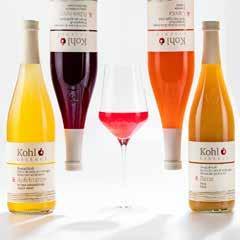

Aperto da lunedì a venerdì dalle ore 8 alle 17 Visite guidate con degustazione su richiesta!
PURE APPLE DELIGHT
Our deli farm shop on the Ritten
On our farm, surrounded by apple orchards in the wonderful mountain air on the Ritten, is where the apples grow and our mountain apple juice is produced. Refreshing treats for in-between and the modern approach to food pairing. Apple juices such as you have never tasted before. Convince yourself and come to our deli farm shop on the Ritten, not far from Bolzano. A worthwhile destination for travelers in search of a new taste experience. We are looking forward to your visit!
Open Monday to Friday from 8 a.m. to 5 p.m. Guided tours with tasting on request!

Kohl Bergapfelsäfte | Succhi di mela di montagna 39054 Unterinn am Ritten, Hauptstraße 35 39054 Auna di Sotto sul Renon, Via Pricipale 35 tel. +39 0471 359 442 | kohl@kohl.bz.it | www.kohl.bz.it 53 REVAMIRP A / FRÜH LING / S P GNIR \
1.©
GEHEN IN LUFTIGER HÖHE
Abwechslungsreich, anspruchsvoll, wuchtig in seiner Höhenlage: Der Leiferer Höhenweg ist ein Must für Wanderfreudige, besonders während der Frühlingswochen.

54
OUTDOOR
Es ist nicht nur der Erderwärmung geschuldet, dass die Höhenlagen eine zunehmende Rolle in der Freizeitplanung spielen. Wer Felsflanken liebt und sich mit den längeren Tagen langsam wieder in die Höhe wagt, wird auf diesem Weg in mehrerlei Hinsicht fündig. Auf seinen 16 Kilometern und seinen 950 Höhenmetern lässt sich ein Tagesausflug einplanen, der lang in Erinnerung bleiben wird.
Aber wieso überhaupt gehen-wandern? Was bringt das denn? Sie kennen diese Sonntags-Fragen von Ihren Kindern? Dann antworten Sie mit einem Augenzwinkern: Gehen verlängert Leben, wirkt sich auf Muskelspannung, Herztätigkeit, Immunsystem aus, senkt das Risiko zu erkranken, z.B. an Diabetes, einer Kreislaufstörung und sogar Krebs. Das Gehen in der Natur reduziert Cellulitis, stärkt die Augen, ist um einiges effizienter und inspirierender als der Besuch eines Fitnessstudios. Am besten wäre es natürlich, das Gehen zur Gewohnheit im Alltag zu machen: Täglich 30 Minuten flottes Gehen reichen. Gelegentlich ist es aber auch empfehlenswert, den Puls raufzujagen. Eine Bergwanderung ist dabei so etwas wie die Königsdisziplin.

Der Leiferer Höhenweg
Die ersten rund vier Kilometer führen vom modernen Rathausgebäude des Städtchens Leifers hinauf ins schmale Brantental. Vom Ortsausgang von Leifers wandert man zuerst auf asphaltierter Fahrstraße den plätschernden Brantenbach entlang bis zur Jausenstation Schwobmiel. Von dort aus steigt man über einen alten, etwas steilen Waldweg am Gasthaus Schwabhof vorbei und nach einem klassischen Waldstück bis zum spannendsten Teil des Höhenweges. Dieser führt auf einem schmalen Pfad Felswände entlang und bietet auch mit Drahtseil gesicherte Abschnitte. An diesen zum Großteil neu beseilten, also gesicherten Stellen ist Trittsicherheit und Schwindelfreiheit absolute Voraussetzung. Obwohl es sich nicht um einen Klettersteig handelt, ist Anhängen möglich, und Familien mit Kindern sollten diese Möglichkeit nutzen, wie Elke Dollinger, die Ortsstellenleiterin des Südtiroler Alpenvereins, aus Erfahrung weiß. Seit zwei Jahren ist sie auch Wegwartin und damit zuständig für die Pflege und Sicherung der Wanderwege in der Ortststelle Leifers. Sie empfiehlt gutes rutschfestes Schuhwerk, da das Laub des vergangenen Herbsts am Boden für unsicheres Gehen sorgen kann.
55 REVAMIRP A / FRÜH LING / S P GNIR \
DE/ 21.©
Wer die Mühe nicht scheut und den Höhenunterschied bezwingt, wird mit einem herrlichen Rundblick über Leifers und das Südtiroler Unterland belohnt –im April ein blühendes Meer von Apfelwiesen. Geht man am Hochegghof vorbei weiter, übrigens der höchste Hof von Leifers, so sieht man auf der anderen Talseite neben Mendelkamm auch die dahinter aufragenden Berge. Bei gutem Wetter reicht der Blick bis in die Texelgruppe bei Meran. Am Breitenberg geht es zu den alten Obersteinerhöfen, wo sich eine schmucke Hofkapelle befindet. Durch den Mischwald wandert man anschließend in ein Tal mit alten Mühlen, leider Ruinen, wo man den Lisnerbach über eine kleine Holzbrücke überquert und anschließend einen recht steilen Abschnitt nach Seit hochwandert. Teils eben führt dieser Weg nun am Altebnerhof und am Rechtebnerhof vorbei - die Aussicht auf Bozen wird immer spektakulärer. Der Weg schlängelt sich leicht abwärts bis zu einer kleinen weißen Kapelle auf einem natürlichen Podest. Sie wird als Totenkirchlein genutzt, was die vielen Votivbildchen und Trauerkarten in ihrem Inneren bezeugen. Hier beginnt ein steiler, in Porphyr gehauener Weg, ein alter Fuhrwerksweg, der auf dem Forstweg zwischen der Haselburg und St. Jakob endet. Ziel ist entweder die Fraktion St.
Jakob oder aber die Haselburg oberhalb von Bozen bzw. die Virglpromenade im Stadtteil Haslach in Bozen, je nach Wanderlaune.
Der Höhenweg kann auch abgekürzt werden, indem man entweder beim Tschuegghof nach Leifers zum Ausgangspunkt absteigt (Gehzeit insgesamt 3:20 h) oder später beim Rechtebnerhof nach Steinmannwald (und mit dem Linienbus nach Leifers zurückfährt; Gehzeit insgesamt 4:30 h). Da sich der Höhenweg an Porphyrwänden entlang windet, ist es im Sommer sehr heiß, weshalb der Tagesausflug vor allem im Frühling und im Herbst empfohlen wird. Und noch einen Grund gibt es zur Vorsicht im Sommer: Die sonnenverwöhnte Felsgegend ist einer der Lieblingsorte von Schlangen, und es gibt hier tatsächlich Exemplare aller drei Südtiroler Giftschlangen: Kreuzotter, Aspisviper und Hornviper. Kuriosum: Diese Porphyrhänge sind sogar das einzige Gebiet in ganz Europa, wo sich die Lebensräume dieser drei Giftschlangen überlagern – fast ein ökologisches Wunder.
Ende April werden Teile des Leiferer Höhenwegs mit einem außergewöhnlichen Berglauf belebt.
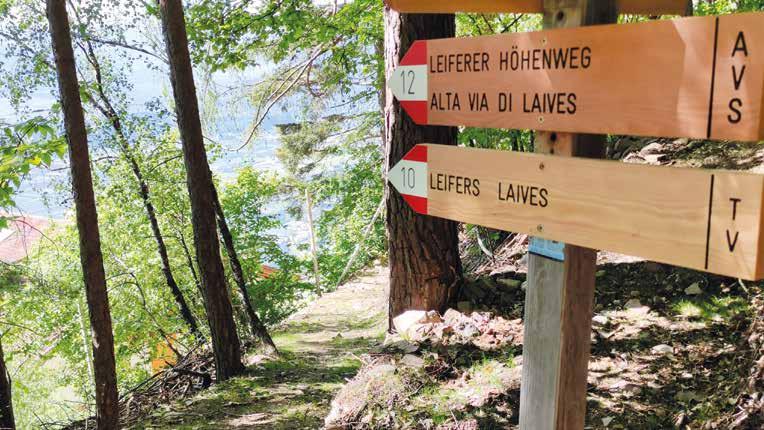
22.© 56
LEIFERER HÖHENWEG
ALTA VIA DI LAIVES
Wegmarkierung 12 und 3
Gehzeit: ca. 6 h
Kilometer: 16
Höhenmeter: 950
Der Präsident des Läuferclubs ADS Laives Runners Fabio Brugnara ist selbst begeisterter Trailläufer und hat diesen Berglauf 2016 mit einigen Läuferkollegen angeregt und organisiert: “Wir nahmen gelegentlich an Trails anderswo teil und dachten uns, dass es toll wäre, unseren bisher wenig beachteten Leiferer Höhenweg für einen Berglauf zu nutzen, auch um diese wunderbare Strecke ins Rampenlicht zu stellen. Wir rechnen gewöhnlich mit ca. 400 Teilnehmer:innen bei den zwei Wettkämpfen. Der Jüngste war 19, der Älteste 70. In einer der ersten Ausgaben nahm selbst der bekannte italienische Langstreckenläufer Marco Olmo (Jahrgang 1948) noch daran teil. Die Allerersten schaffen den langen Trail knapp unter 5 Stunden, die gemütlicheren Läufer:innen brauchen dafür bis zu 11 Stunden. Das Feedback war und ist grandios. Ich treffe immer wieder auf ehemalige Teilnehmer bei Wettkämpfen, und sie erinnern sich gern an die Erfahrung zurück, wegen der abwechslungsreichen Strecke, aber auch wegen der Gastfreundschaft im Ziellauf. Der Lauf endet im großen Zeltbereich in Leifers, dort werden die Athlet:innen wärmstens empfangen und bewirtet, und dort findet ab Mittag ein Dorffest statt, das für alle offen steht. Die Fangemeinde im Zielbereich und die gute Stimmung hat den einen oder anderen bereits dazu bewogen, bei der nächsten Ausgabe mitzumachen oder sich für den kurzen Trail Experience zu begeistern.”
(ar)
BERGLAUF ” LEIFERS TRAIL“ am Samstag, 29. April 2023
3 sind die Läufe dieses sonnenseitigen Trails in seiner 7. Ausgabe: der Leifers Trail mit einer Strecke von 51 km und 2.750 Höhenmetern, der Leifers Sky Trail mit einer Strecke von 21 km und 1.500 Höhenmetern und der Leifers Trail Experience mit insgesamt 11 km und 750 Höhenmetern.

Die beiden langen Strecken führen nicht nur, aber teilweise über den sehr technischen Leiferer Höhenweg. Der Lauf ist für Einzelläufer:innen konzipiert und findet vorwiegend am Berg, auf Forststraßen und Wanderwegen zwischen Leifers, Deutschnofen, Aldein und Petersberg statt. Attraktiv ist der Leifers Trail besonders deshalb, weil er durch die mediterranen Bedingungen als Auftaktlauf zu Saisonsbeginn genutzt wird. Die Experience Strecke wird nicht als Wettkampf ausgetragen, sondern möchte jenen eine Möglichkeit geben, die das Trailrunning prinzipiell näher kennenlernen möchten oder wandernd mit einem Ziel die Natur genießen.
In den letzten Jahren haben bereits international bekannte Sportler:innen wie Stephan Hugenschmidt (2016 der Sieger mit einer Zeit von 4:52:36 h) und Helene Ogi aus der Schweiz, Johannes Klein aus Deutschland sowie die Südtiroler Laufgrößen Andreas Reiterer, Jimmy Pellegrini und Alexander Rabensteiner teilgenommen.
Ökologische Rücksicht ist geboten: Der Leifers Trail will nachhaltig sein, d.h. plastikfrei und mit biologisch abbaubaren Materialien in der Verpflegung und Begleitung. Müll wird getrennt und eine allgemeine Sensibilisierung ist im Gang. Die Sport-Veranstaltung Leifers Trail ist durch die Zusammenarbeit des Laufvereins ASD Laives Runners mit dem Tourismusverein Leifers 2016 entstanden und ausgebaut worden.
Streckenpläne, Höhenprofile und Anmeldungen:
www.laivestrail.it
23.© 57 REVAMIRP A / FRÜH LING / S P GNIR \
CAMMINARE A UN PASSO
DAL CIELO
SPETTACOLARE, MOLTO VARIO, IMPEGNATIVO
NEL TRACCIATO IN ALTITUDINE: L’ALTA VIA DI LAIVES È UNA TAPPA OBBLIGATA PER GLI APPASSIONATI DI ESCURSIONISMO, SOPRATTUTTO DURANTE LE SETTIMANE PRIMAVERILI.
Non è solo a causa del riscaldamento globale che le alte quote stanno assumendo un ruolo crescente nella pianificazione delle attività ricreative. Chi ama le pareti rocciose, l’avventura in montagna, il cammino e i panorami mozzafiato, è pronto a tirare fuori gli scarponi dalla cantina appena le giornate cominciano ad allungarsi. E ciò che cerca lo troverà sull’Alta Via! I primi quattro chilometri circa conducono dal municipio della cittadina di Laives alla stretta valle Vallarsa. Dalla periferia di Laives si cammina lungo il ruscello fino alla stazione di ristoro di Schwobmiel. Da qui si sale lungo un vecchio e ripido sentiero forestale, passando per la locanda Schwabhof e, dopo un classico tratto di bosco, si sale fino alla parte più emozionante del percorso in cresta. Si tratta di un sentiero stretto che corre lungo le pareti rocciose e offre anche tratti assicurati con funi metalliche. Sicurezza, responsabilità e un passo sicuro sono requisiti indispensabili in questi tratti, la maggior parte dei quali sono stati messi in sicurezza con corde nuove. Chi non teme la fatica ed è disposto ad affrontare il notevole dislivello verrà ricompensato con una magnifica vista panoramica su Laives e sulla pianura altoatesina - in aprile un mare di meli in fiore. Se si prosegue oltre il maso Hochegghof, tra l'altro il più alto di Laives, dall'altra parte della valle potrà vedere non solo la Costiera della Mendola ma anche le montagne che svettano alle sue spalle. La meta è il villaggio di S. Giacomo o Castel Flavon sopra Bolzano o la Passeggiata Virgolo nel quartiere Aslago di Bolzano, a seconda del passo e della vostra voglia di escursioni.
Il percorso può essere abbreviato scendendo dal maso Tschuegghof a Laives fino al punto di partenza (tempo di percorrenza totale 3:20 h) o successivamente dal maso Rechtebnerhof a Pineta di Laives (con ritorno a Laives in autobus; tempo di percorrenza totale 4:30 h). Poiché l'Alta Via si snoda lungo pareti di porfido, in estate fa molto caldo, per cui l'escursione è consigliata soprattutto in primavera e in autunno.
CORSA IN MONTAGNA "LAIVES TRAIL”
sabato 29 aprile 2023
3 sono le piste di questo percorso soleggiato alla sua 7ª edizione: il Laives Trail con una distanza di 51 km e 2.750 metri di dislivello, il Laives Sky Trail con una distanza di 21 km e 1.500 metri di dislivello e il Laives Trail Experience con un totale di 11 km e 750 metri di dislivello.

ALTA VIA DI LAIVES
Sentieri n. 12 e n. 3
Tempo di percorrenza: circa 6 ore
Chilometri: 16
Dislivello: 950
I due percorsi più lunghi conducono, in parte, sull’Alta Via – tracciato molto tecnico. La gara è pensata per corridori individuali e si svolge principalmente in montagna, su strade forestali e sentieri escursionistici. Il percorso Experience non è una gara, ma vuole offrire un'opportunità a chi desidera conoscere il trail running o a chi vuole godersi la natura. Per mappe del percorso, profili altimetrici e iscrizioni consultare:
58
www.laivestrail.it IT/ 22.©
WALKING IN BREEZY HEIGHTS
DEMANDING, COMMANDING IN ITS ALTITUDE: THE ALTA VIA DI LAIVES TRAIL IS A MUST FOR HIKING ENTHUSIASTS, ESPECIALLY DURING THE SPRING WEEKS.
It’s not only due to global warming that high altitudes play an increasing role in leisure planning. As the days get longer, those who love rocky slopes are slowly venturing back up into the heights, to find what they are looking for, in more ways than one, on the Alta Via di Laives trail. The first four kilometres or so lead from the town hall building in the small town of Laives, up into the narrow Brantental valley. From the outskirts of Laives, you hike along the rippling Brantenbach stream to the Schwobmiel snack bar. From there, you climb along a steep ancient forest path, past the Schwabhof inn and then a section of alpine forest, to the most exciting part of the high trail. This leads to a narrow path along rock faces with sections secured with wire cable. Most of these secured sections are newly cabled, but surefootedness and a head for heights are absolute prerequisites even so.
Those not daunted by the effort to conquer the difference in altitude will be rewarded with a magnificent panoramic view of Laives and the South Tyrolean lowlands, its apple orchards a sea of blossom. Continue past the Hochegghof farm - incidentally the highest farm in Laives – and you’re rewarded with a vista of the mountains towering behind, on the other side of the valley, as well as the Mendelkamm. The destina-
tion is either the San Giacomo district, or the Haselburg above Bolzano, or perhaps the passeggiata del Virgolo in the Aslago district of Bolzano, depending on the hiking mood.
LEIFERER HÖHENWEG ALTA VIA DI LAIVES
Trail markers: 12 and 3
Walking time: approx 6 hrs
Kilometre: 16
Altitude: 950 metres
Altitude: 950 metres
The high trail can also be shortened, either by descending to the starting point at Tschuegghof to Laives (total walking time 3:20 h), or further on at Rechtebnerhof to Pineta di Laives (and returning to Laives by public bus - total walking time 4 hrs 30 mins). Since the high trail winds along porphyry rock, it’s very hot in summer, which is why the day trip is recommended mainly in spring and autumn.
LAIVES TRAIL MOUNTAIN RUN
Saturday, 29th April 2023
There are three runs on this sunny trail, now in its 7th edition. The Laives Trail, with a distance of 51 km and 2,750 vertical metres; the Laives Sky Trail, with a distance of 21 km and 1,500 vertical metres; and the Laives Trail Experience with a total of 11 km and 750 vertical metres.
The two longer routes include parts of the very technical Alta Via di Laives trail. The race is designed for individual runners and takes place mainly on the mountain - on forest roads and hiking trails. The Experience route is not a competition, but rather an opportunity to become acquainted with Trail running, enjoying nature while hiking with a goal.
Course maps, altitude profiles and registration:
www.laivestrail.it

REVAMIRP A / FRÜH LING / S P GNIR \ 59
VARIED,
EN/ 24.©
FIORITURA SINCRONE
Chi si occupa della piantumazione e della manutenzione delle aiuole, delle isole spartitraffico e dei prati pubblici nei nostri comuni? Parliamo del lavoro di squadra ad Appiano che, con le sue undici frazioni, risulta essere il sesto comune più grande dell'Alto Adige.
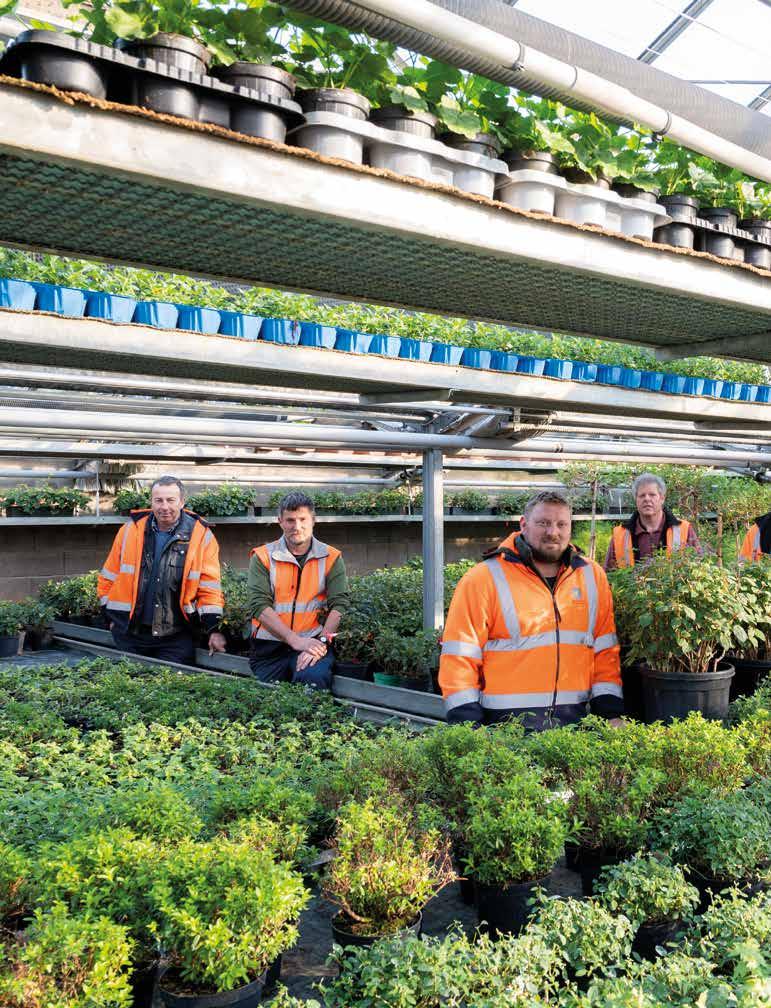
60 PLEASURE
Mentre la fioritura dei meli, a seconda dell'altitudine, raggiunge in aprile il suo apice a Oltradige con un inebriante risveglio primaverile che coinvolge un po’ tutti i sensi, e mentre Appiano invita al giro di eventi delle "Giornate dei Fiori" (Blütentage), nel vivaio comunale c’è un grande andirivieni sia per la produzione che per il lavoro nelle varie zone verdi del paese. Il primo tour di piantumazione negli spartitraffico e nelle aiuole pubbliche è terminato e ha lasciato una scia di profumi, colori e geometrie vegetali. Chi si meraviglia di questa festa per gli occhi nella primavera di Appiano si chiederà quali folletti siano mai riusciti a compiere, quasi da un giorno all’altro, un simile miracolo fiorito. bm ha chiacchierato con il nuovo capo giardiniere dell'amministrazione comunale, che ci presenta con orgoglio la sua squadra e il suo lavoro dietro le quinte di questo spettacolo naturale. Andreas Romen (nella foto a p. 64) coordina la Giardineria comunale dall’inizio dell’anno, un impiego che conosce molto bene perché ha già fatto parte del team precedente. Prima della sua esperienza nel verde pubblico, ha lavorato per 26 anni nella produzione di piante orticole e ornamentali in un vivaio altoatesino. Ha iniziato la sua carriera come apprendista giardiniere nel 1986. Un'esperienza all'estero, in Danimarca, gli ha dato l'opportunità di specializzarsi prima di tornare a casa.
LO SPAZIO VERDE PUBBLICO DI APPIANO IN CIFRE

un totale di 5 ettari di superficie coltivata di cui:
28 aiuole, 9 isole composte da giardini rocciosi, 26 prati, 65 aree verdi con arbusti e siepi lungo le passeggiate e i sentieri, oltre a fioriere al centro delle frazioni
un vivaio con serre accanto al Cantiere comunale di S. Michele/Appiano
8 dipendenti
61 REVAMIRP A / FRÜH LING / S P GNIR \
IT/ 1.©
Che tipo di lavoro svolgete in primavera?
In prossimità della festa di San Giuseppe, il 19 marzo, iniziamo a ripiantare le aiuole e le fioriere precedentemente pulite. Abbiamo anche alcune isole spartitraffico a mo’ di giardino roccioso con piante perenni. Naturalmente, è necessario curarle, sostituendo le piante morte in inverno o potando la lavanda; le viti amiamo piantarle tra le bordure di fiori, visto che siamo comune vinicolo, lo stesso accade con la canna cinese e l'erba della pampa, per citare solo alcuni esempi. Ma l'anno del giardinaggio inizia molto prima, con la potatura di alberi, arbusti ed erbe. Viene fatta durante i mesi invernali fino all'inizio della primavera. Lo stesso vale per il lavoro in serra, dove coltiviamo la maggior parte delle piante, in parte da semi e in parte da talee. Il lavoro di preparazione è sottovalutato e richiede moltissimo tempo. Dall'idea al reimpianto passano tra i sei mesi e un anno. Quando abbiamo terminato la piantumazione primaverile e mentre controlliamo il lavoro svolto, stiamo già pianificando la primavera successiva, perché osserviamo le sfumature colorate con occhio critico pensando a nuove migliorie. Sulla carta, quindi, la futura aiuola viene creata con un anno di anticipo, anche perché dobbiamo ordinare i semi per tempo dai cataloghi di semenze o trovare quelle giuste attraverso attente ricerche su internet.

Chi sono le persone che collaborano con Lei?
Siamo un team affiatato di otto persone, due giardinieri con qualifiche specialistiche, quattro persone che abbiamo formato con un percorso interno e due lavoratori non qualificati. Ognuno di noi ha la propria area di competenza: uno si occupa dell'irrigazione, l'altro della pianificazione o degli ordini, e così via. Quando ci occupiamo di piantumazione o di manutenzione, siamo ovviamente chiamati in causa tutti; ugualmente, quando si verificano emergenze e dobbiamo riparare i danni causati dalle tempeste, che si tratti di potatura di alberi o di eliminare i danni causati da acqua e neve. Durante i mesi invernali aiutiamo anche a montare e smontare le decorazioni natalizie nei centri delle frazioni di Appiano e a sgomberare la neve. Lo spirito di squadra è il punto di forza, il lavoro è principalmente divertente, soprattutto quello all'aperto con le piante, e quindi la motivazione è grande per creare ogni anno nuovi accenti di colore per gli abitanti di Appiano e per gli ospiti, per attirare l'attenzione coi fiori e dare il benvenuto con la sua estetica di carattere botanico.

Quali sono i passi da compiere per la manutenzione?
Oltre alle piantumazioni, che tra l'altro vengono effettuate una seconda volta in estate, il fulcro del no -
62
1.©
stro lavoro è la manutenzione del verde pubblico: la potatura degli arbusti viene effettuata in media tre volte l'anno. I prati degli asili, dei parchi giochi e del verde pubblico devono essere tagliati ogni quindici giorni. Diserbiamo manualmente, poiché lavoriamo senza diserbanti chimici. Combattiamo parassiti e funghi rafforzando le piante con preparati biologici una volta alla settimana. I fertilizzanti organici vengono aggiunti al terreno e devono essere applicati regolarmente. E i nostri attrezzi devono essere sottoposti a manutenzione: sono tutti elettrici e caricati da batterie.
Quindi il rispetto dell'ambiente è una priorità assoluta?
La sostenibilità ci accompagna in ogni momento. Anche quando piantiamo, ci assicuriamo di utilizzare varietà amiche delle api, soprattutto nelle piantumazioni permanenti, ad esempio nelle siepi. Utilizziamo varietà come le prugnole, il crespino e il biancospino. Da tempo utilizziamo l'irrigazione a goccia per le aiuole, le aree verdi vengono innaffiate con parsimonia di notte - quando la perdita per evaporazione è minore - con irrigatori computerizzati, e ci assicuriamo di irrigare regolarmente solo le piante giovani. Ove possibile, evitiamo di utilizzare acqua potabile.
LE GIORNATE DEI FIORI DI APPIANO
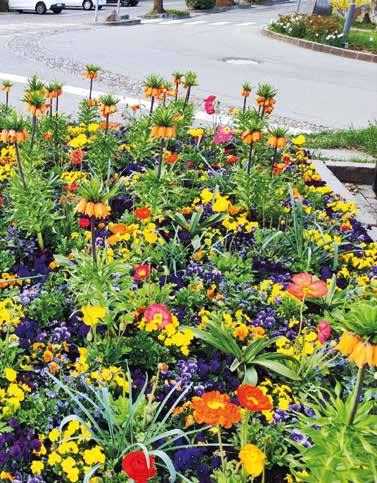
dal 1 ° al 30 aprile 2023
Passeggiate guidate attraverso meleti fioriti, gite in carrozza accompagnati dal ronzio d’api, degustazioni di vino e tour in bicicletta nei dintorni di Appiano - a Frangarto, Cornaiano e S. Paolo. L'associazione turistica propone ogni anno qualcosa di nuovo al culmine della fioritura dei meli, per viziare gli appassionati di colori, profumi e gioia di vivere. www.eppan.com
Naturalmente, anche noi osserviamo con preoccupazione il riscaldamento globale e reagiamo, tra l'altro, piantando più piante mediterranee: cipressi e ulivi, lavanda, rosmarino pendulo e, recentemente, anche oleandro.
Quali sono le sfide maggiori del vostro anno di giardinaggio?
A seconda del clima, può essere difficile ottenere ottimi risultati senza la protezione chimica delle piante, e proteggersi quindi da afidi e funghi: per questo bisogna essere vigili e sostituire le piante fortemente infestate se necessario. Un grande problema per il futuro è la mancanza di personale qualificato, compresi i lavoratori stagionali; inoltre, anche per noi giardinieri comunali la burocrazia può rappresentare un ostacolo. Infine, nel 2023 dovremo affrontare un nuovo capitolo: il controllo del nostro patrimonio arboreo attraverso un catasto degli alberi - una questione di sicurezza e anche di cambiamento climatico di cui dovremo tenere conto, eventualmente, con nuove piantumazioni.
(ar)
REVAMIRP A / FRÜH LING / S P GNIR \ 63
25.©
FARBSPIELE FÜRS AUGE
WER KÜMMERT SICH EIGENTLICH UM BEPFLANZUNG UND PFLEGE DER STRASSENBEETE, VERKEHRSINSELN UND ÖFFENTLICHEN RASENFLÄCHEN DER SECHSTGRÖSSTEN GEMEINDE SÜDTIROLS MIT IHREN ELF FRAKTIONEN? VON TEAMARBEIT IM EPPANER GARTENJAHR.

Während die Apfelblüte im Überetscher April je nach Höhenlage ihren Höhepunkt erreicht, mit einem berauschenden Frühlingserwachen für alle Sinne, wird in der Gemeindegärtnerei emsig gearbeitet. Die erste Tour der Bepflanzung von Verkehrsinseln und Rabatten ist vorbei und hat eine Spur von Düften, Farben und Pflanzengeometrien hinterlassen. Wer die Augenweide im Eppaner Frühling spazierend bestaunt, das Blütenmeer in seinem zarten und auch satten Farbspektrum, der fragt sich vielleicht, welche Heinzelmännchen fast über Nacht das gärtnerische Wunder vollbracht haben. bm hat nachgefragt beim neuen Chefgärtner in der Gemeindeverwaltung Andreas Romen (Foto rechts oben).
Was steht denn im Frühling alles an Arbeit an?
Um “Josefi” (19. März) herum beginnt die Neubepflanzung der vorher gesäuberten Beete und Troge. Das Gartenjahr startet aber schon viel früher, mit dem Rückschnitt von Bäumen und Sträuchern, in den Wintermonaten bis in den Frühfrühling. Das selbe gilt für die Arbeit im Gewächshaus, wo wir die meisten Pflanzen selbst kultivieren, teilweise über Samen, teilweise über Stecklinge. Von der Idee bis zur Neubepflanzung vergehen zwischen sechs Monaten und einem Jahr. Wenn wir die Frühlingsbepflanzung also erledigt haben, planen wir imgrunde schon den nächsten Frühling …
Wer sind ”wir“?
Ein eingeschworenes Team von acht Leuten, zwei Gärtnern mit Fachspezialisierungen, vier Quereinsteigern, die im gemeindeeigenen Betrieb angelernt wurden, und zwei Hilfsarbeitern. Jeder von uns hat seinen Aufgabenschwerpunkt: der eine die Bewässerung, der andere die Planung und Bestellung usw. Bei der Bepflanzung und Pflege sind wir natürlich alle gefragt. Ebenso, wenn Notfälle eintreten und wir Unwetterschäden beheben müssen. Auch helfen wir beim
DIE EPPANER BLÜTENTAGE
vom 1. bis 30. April 2023
Blütenwanderungen, GenussKutschenfahrten durch Apfelwiesen im Bienensumm-Konzert, auch Weinverkostungen und Genuss Bike-Touren in die Gegend um Eppan - in Frangart, Girlan und St. Pauls. Der Tourismusverein lässt sich jedes Jahr zur Hochblüte Neues einfallen, um die Fans von Farbe, Duft und Lebensfreude zu beglücken.
www.eppan.com
Auf- und Abbau der Weihnachtsdekoration in den Ortsmitten und bei der Schnee-Räumung im Winter. Der Teamgeist ist das A und O, die Motivation groß, für die Eppaner:innen und die Gäste jedes Jahr neue Farbakzente zu setzen.
Wie steht es um die Umweltfreundlichkeit?
Der Umweltgedanke begleitet uns auf Schritt und Tritt. Beim Bepflanzen achten wir darauf, dass wir bienenfreundliche Sorten setzen, da kommen Wildobstsorten wie Schlehen, Berberitze, Weißdorn zum Einsatz. Bei der Bewässerung der Beete haben wir schon lang auf Tropfberegnung gesetzt, Grünflächen werden nachts – wenn der Verlust durch Verdunstung am geringsten ist - sparsam mit computergesteuerten Sprinklern bewässert. Natürlich beobachten wir mit Sorge die Erderhitzung und reagieren darauf, u.a. indem wir vermehrt mediterrane Pflanzen setzen: Gardasee-Zypressen und Olivenbäume, Lavendel, Hängerosmarin und neulich auch Oleander.
DE/ 64
A FEAST OF COLOUR FOR THE EYES
EPPAN - THE SIXTH LARGEST MUNICIPALITY IN SOUTH TYROL WITH ELEVEN DISTRICTS. SO, WHO ACTUALLY TAKES CARE OF PLANTING AND MAINTAINING THE FLOWER BEDS IN THE STREETS OR ON TRAFFIC ISLANDS AND THE PUBLIC GREEN AREAS? ON TEAMWORK IN THE EPPAN GARDENING YEAR.
While the Überetsch apple blossom reaches its peak in April - depending on the altitude - the intoxicating spring awakens the senses and the municipal nursery is busy at work. The first round of planting traffic islands and borders is complete, leaving a trail of scents, colours and floral geometry. Marvelling at Eppan spring’s sea of blossoms and wide spectrum of colours, you may well wonder about the team who achieve this horticultural miracle, almost overnight. bm Magazine asked the municipal administration’s new head gardener, Andreas Romen (see p. 64).
What kind of work needs doing in spring?
Replanting of the previously cleaned beds and troughs begins around Josefi (St. Joseph's Day, 19th March). But the gardening year actually begins much earlier, during the winter months and into early spring, with the pruning of trees and shrubs. The same goes for the work in the greenhouse, where we cultivate most of the plants ourselves, partly from seeds and partly from cuttings. It takes between six months to a year, from the idea to planting. So by the time we get the spring planting done, we're basically already planning for next year!
Who is "we"?
We’re a team of eight: two specialized gardeners; four newcomers, trained by the council; and two unskilled workers. Each of us has a main responsibility. One does the watering, the other the planning or tilling, and so on. Of course, when it comes to planting and maintenance, we all pitch in – just as when emergencies occur and we have to repair storm damage. We also help put up and take down Christmas decorations in the village centres and clear snow in the winter. The team spirit is the be-all and end-all, with motivation great to set new colour schemes for Eppan folk and visitors every year.
What about environmental friendliness?
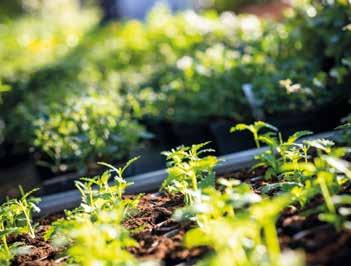
Environmentalism informs our every move. When planting, we make sure to use bee-friendly wild fruit varieties, such as sloes, barberry, and hawthorn. We have long used drip irrigation to water the beds, with green areas watered sparingly at night - when the loss through evaporation is lowest - via computer-controlled sprinklers. Of course, we observe global warming and respond to it, for example, by planting more Mediterranean plants, such as Garda cypress and olive trees, lavender, hanging rosemary and, most recently, oleander.
EPPAN FLOWER DAYS
from 1st to 30th April 2023
Blossom walks, pleasure carriage rides through apple orchards with the buzz of bees, wine tastings and leisurely bike tours around Eppan - in Frangart, Girlan and St. Pauls. The tourist association comes up with something new every year at the peak of the blossom season, to delight fans of colour, fragrance and the joie de vivre.
www.eppan.com
65 REVAMIRP A / FRÜH LING / S P GNIR \
EN/ 1.© 1.©
EIN BLICK ZURÜCK, EINER NACH VORN
Kein Tal in Südtirol hat sich so, wie das Sarntal, der Tradition verschrieben: dem eigenen Handwerk, alter Bauernprodukte und Rezepte, Naturkostbarkeiten wie der Sarner Latschenkiefer und der Schafwolle, auch der bäuerlichen Tracht. Ein Traditionstal stellt sich vor.

66 TRADITION
Die Liste der Sarner Bräuche und Traditionsprodukte ist lang, sogar namensgebend in einigen Fällen wie beim ”Sarner“, der handgestrickten Schafwolljacke, oder bei den ”Sarnar Toppar“, den Filzpantoffeln aus Loden und Schafwolle. Was unser Unterfangen, nämlich die Vorstellung der bunten Palette, nicht einfach macht. Am besten, wir fangen bei Volkskunde und Wurzeln an, um das Phänomen zu verstehen: Maria Kröss-Spögler ist die Brauchtumexpertin im Tal, eine gebürtige Sarnerin, ehemalige Grundschullehrerin in Sarnthein, Vermittlerin im Rohrerhaus (siehe S. 8). Ihre Theorie zur Traditionsverbundenheit der Sarner dockt an der Volksseele, am Sarner Charakter, an und weniger an der Verschlossenheit durch Talenge und Abgeschiedenheit. Denn die Verbindungen mit Bozen waren bereits im Mittelalter durch den Handel gegeben. Kröss-Spögler beschreibt die Sarner als ”eingeschworenes Völkl“, das sich durch Bodenständigkeit und auch Sturheit auszeichnet, obwohl die Gastfreundschaft gepflegt wird. Auch heute noch sei das Geschichtsbewusstsein und die Liebe zum Dialekt gerade in der Jugend groß, trotz Globalisierung und besserer Straßenanbindung an die Landeshauptstadt.
Ob auf Volksfesten, bei Auftritten der Musikkapelle oder der Schützen, bei Familienfeiern oder Hochzeiten, im Sarntal darf die Sarner Tracht selbst an gewöhnlichen Sonntagen nicht fehlen. Sie zählt zu den stilreinsten Trachten des gesamten deutschen Sprachraums und hat ihre Wesensart mit den schlichten genauso wie den edlen Teilen bewahrt, bei Frauen mit buntem Schultertuch (Tiechl), heller Schürze (Firte), schwarzer Jacke (Tschoap), bei Männern mit weißem Trachtenhemd, schwarzen Hosen samt federkielbestickten Hosenträgern (Krax) und Trachtengurt (Fatsch). Der Hutschmuck macht den Unterschied: mit roten Schnüren ledig, mit grünen verheiratet.
Und nicht zu vergessen die Federkielstickerei: Dieses alte Kunsthandwerk ist vor 250 Jahren im Alpenraum entstanden und hat sich vor allem im Sarntal hartnäckig gehalten, als Nebenerwerb von Bauern, früher auch von Sattlern. Je mehr Stickereien, desto wohlhabender die Bauersleute, denn die Handarbeit ist aufwändig. Einen Trachtengürtel zu besticken kann bis zu 200 Stunden in Anspruch nehmen. Der Kiel

9.© 67 REVAMIRP A / FRÜH LING / S P GNIR \
DE/
von Pfauenfedern wird zu Fäden gespalten und mithilfe einer Ahle, einer Nadel mit Holzgriff, in das Leder eingearbeitet. Auch Schuhe, Gürtel und Geldtaschen werden mit kunstvollen Ornamenten bestickt. Früher aus Sparsamkeit, heute aus ökologischen Gründen: Im Kunsthandwerk des Tals wird vermehrt auf recycelte Materialien zurückgegriffen, auch weil die Kund:innen darin einen Mehrwert erkennen, wie Eberhard Hofer vom Wirtschaftskonsortium mirSarner bestätigt. In diesem Zusammenschluss sind rund 170 Sarner Qualitätsbetriebe vereint, Kleinbetriebe aller Sektoren, die mit dem gemeinsamen Auftritt die Sichtbarkeit und Zusammenarbeit festigen. Am stärksten vertreten ist das Handwerk: Bauen und Wohnen, Genießen und schöner Leben.

www.mirsarner.com und
www.sarner-gschick.com
Das Traditionstal hat übrigens auch einen selbsterklärenden Produktführer herausgebracht: ” Da steckt Sarntal drin – kulinarisch – handwerklich – herzlich“ , der Ästhetik und Vielfalt gekonnt zusammenfasst.
Südtiroler:innen verbinden das Sarntal gern mit der Tradition der Latschenkieferöl-Gewinnung und mit Produkten aus der Sarner Latsche – der Berg- oder Zirbelkiefer. Sie wächst ausschließlich auf sauren
Böden entlang der Waldgrenze und bildet dort fast undurchdringliche Gürtel aus strauchigen Bäumen, einen wirksamen natürlichen Lawinenschutz. An steilen Hängen liegen ihre Äste meist nah am Boden (der Name ” Latsche“ kommt vom Schleifen der Äste am Boden). Extreme Temperaturschwankungen und der wetterausgesetzte Standort reichern das ätherische Öl mit über hundert Wirkstoffen an: Es stimuliert, wirkt reinigend und belebend. Verwendet werden die frischen stumpfen Nadeln, die jungen Triebe und Äste und das aus ihnen gewonnene ätherische Öl. Das Öl wird aus den zerkleinerten Zweigen durch Wasserdampf-Destillation gewonnen. Die Arbeit beginnt, wenn der Schnee im Frühjahr die Latschen freigibt, im unwegsamen Gelände, mit dem Abtrennen, Bündeln und Abtransportieren der ” Packen“ auf dem Fußweg. Noch am Sammelort im Wald werden die Latschenbündel kleingehackt und zur weiteren Verarbeitung in die betriebseigenen Brennereien gebracht. Nach dem stundenlangen Brennvorgang kann das kostbare Öl entzogen werden; zur Beheizung der Kessel wird das Abfallprodukt verwendet, was den Kreislauf schließt. Auch früher schon nutzte man das wertvolle Latschenkiefernöl in der Naturkosmetik, heute hat sich daraus eine eigene Sarner Marke mit dem Namen Trehs entwickelt. Sie vereint

68 9.©
26.©
traditionelles Wissen über die Urkraft der Sarner Berge mit modernen Methoden, das Ergebnis sind eigene Pflegelinien mit unverkennbaren Düften nach harziger Waldfrische. Das naturreine ätherische Öl wird hingegen als Badezusatz, in der Sauna, bei Massagen, zum Inhalieren und in Duftlampen verwendet. In der Aromatherapie hat sich die Latschenkiefer bei Erkältungs- und Muskelbeschwerden bewährt, auch wirkt sie schlaffördernd.


www.latschenkieferoel.com
hiips://eschgfeller.eu/de (mit Natur-Spa)
www.trehs.com
Aber aus der Latsche wird weit mehr gewonnen: Aus dem stark duftenden harzhaltigen und wasserabweisenden Weichholz der Zirbelkiefer werden Möbel, v.a. Schränke, Betten und Truhen gezimmert, auch Zirbelholzteller gedrechselt.
Die Textilbranche ist im Traditionstal ebenso führend, mit den ” Sarnar Toppar “ und dem ” Sarnar Janggar “. Bereits die erste Strophe des Dialekt-Gedichts von Gabriel Vikoler mit dem Titel ”D'r sarnar Toppar tamische“ (auch gesungen von ”Die Lond’s Leit”) verrät, was es damit auf sich hat, nämlich Rettung vor kalten Füßen und schlechter Laune:
Küehl bloßt do Wind, und's Wettor spinnt wenn in do Dochrind'l s'Woosor rinnt i bin gonz noß, komplett platschnoß wos isch des heint decht für a Tog doch wie a Blitz, schießt's mir in's Hirn Zwoa sarnar Toppar worm und fein dei leg i on und bleib dahoam und bin bestimmt net long aloan.
Sarner:innen kriegen eben nicht so schnell kalte Füße, weil sie daheim ”Sarnar Toppar“ tragen: warme Hauspantoffeln aus Lodenstoff und alten Stoffresten. Mit starkem Spagat wird die Filzsohle aufgenäht. Die Klebemasse (Wasser und Roggenmehl), die auf die Schuhleisten aufliegt, hält die Lodenstoffschichten zusammen und gibt den Hausschuhen Form und langes Leben. In der Farbwahl gibt es beim Saumband rund um den ”Toppar-Einstieg“ kleine Unterschiede. Bei Frauen und Kindern werden meist rote oder helle und bei Männern grüne, blaue, graue oder violette Bänder aufgenäht. Die unverkennbare Sarner Markenware wird im Tal meist von Bäuerinnen im Nebenerwerb an langen Winterabenden angefertigt und weit über das Sarntal hinaus getragen. Ähnlich geht es mit dem handgestrickten ”Sarnar Janggar“ aus grauer oder dunkelbrauner Schafwolle. Er ist in ganz Südtirol dermaßen etabliert, dass man landläufig unter einem ”Sarnar“ zunächst an diese Art von Jacke denkt und erst in einem zweiten Moment an einen Bewohner des Sarntals. Einige Wollmanufakturen und Geschäfte bieten im Sarntal diese zwei traditionellen Woll-Artikel an.
69 REVAMIRP A / FRÜH LING / S P GNIR \
27.© 9.©
Und dann wäre noch der Gaumengenuss, der im Sarntal eine große Rolle spielt, ob bei der Veredelung und Herstellung von Gourmetschokolade mit alpiner Note (hiips://oberhoeller.com ) – bei der auch wieder die Latsche eine Rolle spielt –, bei den Evergreens ”Sarnar Striezl“ oder ”Sarnar Specknockn“ (siehe Rezept) oder bei den saisonalen Gerichten der Sarner Küche wie dem Osterschinken oder den ” Pfingist-Grunggln“. Ostern ohne Sarntaler Osterschinken geht gar nicht, dieser wird dem Brauchtum nach am Ostersonntag in der Kirche gesegnet. Unzählige Esskörbe (”s Gweichte“) schmücken dabei den Altar. Die ”Sarnar Striezl“ werden hingegen das ganze Jahr über zu Anlässen gebacken, aus Roggenmehl, Hefe, Milch, Wasser und Salz. Dieses traditionelle Hefegebäck sieht aus wie ein Pantoffel und wird mit fein geschnittenem Speck gefüllt. Auf dem Bauernmarkt in Sarnthein gibt es jede Woche frische Sarnar Striezl zu kaufen. (ar)
www.sarntal.com
SARNER SPECKNOCKEN
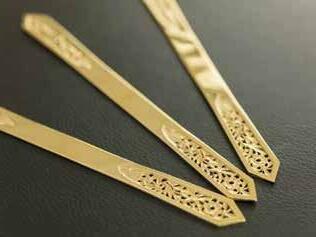
Rezept von Bäuerlichem Küchenservice Ollerhond Selbergmochts


Zutaten (für 4 Personen):
eine Speckscheibe (ca. 1 cm dick)
500 g Mehl
200 g Speck in feine Würfel geschnitten
20 g fein geschnittenen Schnittlauch
3 Eier
200 ml Milch (alternativ Wasser)
eine Prise Salz
Zubereitung:
Das gesalzene Wasser in einem Topf zum Kochen bringen, die Scheibe Speck dazugeben. Das Mehl, den gewürfelten Speck, den Schnittlauch und das Salz in einer Schüssel gut vermengen. Jetzt die Eier und die Milch (bzw. das Wasser) in kleinen Mengen dazugeben und untermischen - solange, bis ein feiner, geschmeidiger Teig entsteht. Schließlich mit einem Esslöffel die Nocken formen und in das köchelnde Wasser geben. Dort 8-10 Minuten köcheln lassen.
Tipp: Der mitgekochte Speck kann alternativ in Streifen geschnitten auf dem Kraut- oder Blattsalat als Beilage zu den Nocken serviert werden.
70
29.©
28.©
9.©
Bergfrühling im Sarntal
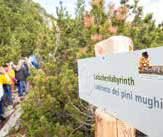
Primavera di montagna in Val Sarentino

Mountain spring in the Sarntal Valley
Ursprüngliches Sarntal
Viele Wiesen und Almen sind naturbelassen und begeistern mit ihrer Vielfalt an farbenprächtigen Frühlingsblumen.
L’autentica Val Sarentino
In questa valle, dove prati e alpeggi sono rimasti in gran parte allo stato naturale, le fioriture di primavera presentano una sorprendente varietà di colori.
…
Original Sarntal
Many meadows and alpine pastures are left in their natural state and delight with their variety of colourful spring flowers.

Kabinenbahn in Reinswald …
…per
Cabinovia di Reinswald …
Cable car in Reinswald …
…
Die ersten Frühlingsboten auf dem Talrundweg in Sarnthein
Wandern und Spazieren entlang von erwachenden Wiesen und Sträuchern. Immer wieder einen Blick auf die schmucken Ortschaften Sarnthein, Nordheim und Astfeld erhaschen. Einfach auf einem der stillen Rastplätze verweilen und den Anblick von stattlichen Berghöfen genießen. Das macht die Faszination Talrundweg Sarnthein aus. (20 Autominuten von Bozen – Öffentliche Busverbindung jede ½ Stunde).

I primi segni della primavera sul sentiero circolare della valle a Sarentino Paese.
Escursioni e passeggiate lungo prati e cespugli che si risvegliano. Scorgere più volte i graziosi villaggi di Sarentino, Villa e Campolasta. Soffermatevi semplicemente in una delle tranquille aree di sosta e godetevi la vista delle imponenti masi di montagna. È questo che rende il sentiero della valle intorno a Sarentino Paese così affascinante. (20 minuti in auto da Bolzano - collegamento con autobus pubblico ogni ½ ora).
The first signs of spring on the circular valley trail in Sarnthein Village.
Hiking and walking along awakening meadows and bushes. Catch glimpses of the pretty villages of Sarnthein, Nordheim and Astfeld again and again. Simply linger at one of the quiet resting places and enjoy the sight of stately mountain farms. This is what makes the circular valley trail so fascinating. (20 minutes by car from Bolzano - public bus connection every ½ hour).
71 REVAMIRP A / FRÜH LING / S P GNIR \
Grafik: crossbone-designs.com
INFO Tourismusverein Sarntal | Ass. Turistica Sarentino Tel. 0471 623091 | info@sarntal.com www.sarntal.com
Fotos: Michael Lange, Roland Lamprecht
in die Sarner Bergwelt und Familienspaß auf dem „Urlesteig“.
i Monti Sarentini e il divertimento per famiglie sul sentiero “Urlesteig”.
to the Sarntal Mountains and family fun on the children's hiking trail “Urlesteig”.
NOSTALGIA E RISCOPERTA
NESSUN'ALTRA VALLE ALTOATESINA
LEGATA ALLA TRADIZIONE COME LA VAL SARENTINO: AL PROPRIO ARTIGIANATO, AD ANTICHI PRODOTTI E RICETTE CONTADINE, ALLA RACCOLTA DI PINO MUGO COME ALLE GIACCHE E PANTOFOLE DI LANA DI PECORA.
È
L'elenco delle usanze e dei prodotti tradizionali della Val Sarentino è lungo, tanto da dare il nome ad alcuni di essi, come il "Sarner", la giacca di lana di pecora lavorata a maglia, o i "Sarnar Toppar", le pantofole di feltro fatte di loden e lana di pecora. Che si tratti di feste popolari o matrimoni, in Val Sarentino il costume tradizionale, la Tracht, non può mancare nemmeno nelle ricorrenze domenicali. Si tratta di uno dei costumi tradizionali che ha conservato il proprio carattere e stile nella sua purezza. Da non dimenticare anche il ricamo a penna d'oca (Federkielstickerei): questo antico mestiere è nato 250 anni fa nella regione alpina e si è mantenuto, soprattutto in Val Sarentino, come attività secondaria per i contadini e, in passato, anche per i sellai. Ricamare una cintura tradizionale può richiedere fino a 200 ore. La chiglia di piume di pavone viene divisa in fili e lavorata sul cuoio con l'aiuto di un punteruolo, un ago con manico di legno. Anche scarpe, cinture e borse sono ricamate con ornamenti elaborati. In passato lo si faceva per parsimonia, oggi per motivi ecologici: nell'artigianato della valle si utilizzano sempre più spesso materiali riciclati, anche perché i clienti vi riconoscono un valore aggiunto. Circa 170 piccole imprese della valle sono riunite in un'associazione che consolida la visibilità e la collaborazione con una veste comune:

www.mirsarner.com
www.sarner-gschick.com

Gli altoatesini amano associare la Val Sarentino alla tradizione dell'estrazione di olio di pino mugo e ai prodotti derivati dal pino mugo. Questo albero cresce esclusivamente su terreni acidi lungo il limite del bosco, dove forma cinture quasi impenetrabili di al-
beri arbustivi, un'efficace protezione naturale dalle valanghe. Le estreme oscillazioni di temperatura e la posizione esposta alle intemperie arricchiscono l'olio essenziale di oltre cento sostanze attive: stimolanti, detergenti, tonificanti... L'olio viene estratto dai rametti frantumati mediante distillazione a vapore. Il prezioso olio di pino mugo veniva utilizzato in passato anche nella cosmesi naturale, una tradizione mantenuta ancora in uso in un marchio che porta il nome di Trehs.
www.latschenkieferoel.com
hiips://eschgfeller.eu/de (con spa naturale)

www.trehs.com
L'industria tessile è altrettanto importante, con i "Sarnar Toppar" (pantofole) e il "Sarnar Janggar" (giacca). Vengono realizzati per lo più in valli contadine nelle lunghe serate invernali e indossati ben oltre il territorio compreso nella vallata. Il "Sarnar Janggar", lavorato a mano in lana di pecora grigia o marrone scuro, è talmente diffuso in tutto l'Alto Adige che quando si pensa a un "Sarnar" si pensa prima a questo tipo di giacca e solo in un secondo momento a un abitante della Val Sarentino: il nome, infatti, è lo stesso. Diversi produttori e negozi di lana della valle offrono questi due tradizionali articoli di lana.
E poi c'è il piacere del palato che in Val Sarentino gioca un ruolo fondamentale, sia nella raffinatezza e nella produzione di cioccolato gourmet dal sapore alpino (hiips://oberhoeller.com ), sia negli "Sarnar Striezl" (piadina di segale e speck) o "Sarnar Specknockn" (canederli), o nei piatti stagionali della cucina della Val Sarentino come il prosciutto di Pasqua. www.sarntal.com
72
e
IT/ 9.©
LOOKING BACK, LOOKING FORWARD
NO VALLEY IN SOUTH TYROL IS AS DEDICATED TO TRADITION AS THE SARNTAL - IT HAS ITS OWN HANDICRAFTS, ITS OWN OLD FARM PRODUCTS AND RECIPES, OR NATURAL PRODUCTS, SUCH AS THE SARNER MOUNTAIN PINE AND SHEEP'S WOOL.

The list of Sarntal customs and traditional products is long, some even carry the name, like the hand-knitted sheep wool Sarner jacket, or the Sarnar Toppar - the felt slippers made of loden and sheep’s wool. Whether at folk festivals or weddings, in the Sarntal Valley the Sarner Tracht traditional costume cannot be missed, even on ordinary Sundays. It is one of the most stylishly characteristic traditional costumes in the entire German-speaking area. Not to be forgotten is the quill embroidery - a craft originating 250 years ago in the Alpine region, persisting especially in the Sarntal Valley as a sideline for farmers, and in the past, also of saddlers. Embroidering a traditional costume belt can take up to 200 hours. The peacock feather quill is split into threads and worked into the leather using an awl, or needle with a wooden handle. Shoes, belts and purses are also embroidered with elaborate ornaments. In the valley's handicrafts, recycled materials are increasingly used, also because customers recognize an added value in them - in the past, this was for thrift, today it’s for ecological reasons. Around 170 quality businesses in Sarntal are united in an association that consolidates visibility
South Tyroleans readily associate the Sarntal Valley with the tradition of extracting mountain pine oil and with products from the Sarntal mountain pine - the mountain or Swiss stone pine. It grows exclusively on acid soils along the timberline, where it forms an almost impenetrable belt of shrubby trees, which are an effective natural avalanche protection. Extreme temperature fluctuations and the weather-exposed location enrich the essential oil with over a hundred active substances: it stimulates, purifies and invigorates. The oil is extracted from the crushed branches by steam distillation. The work begins when the snow releases the mountain pines in spring, in impassable terrain. In the past, people used the valuable mountain pine oil in natural cosmetics and today it has developed into its own Sarntal brand - Trehs.
www.latschenkieferoel.com
hiips://eschgfeller.eu/de (with nature spa) www.trehs.com
The textile industry is equally important in valley traditions, with the Sarnar Toppar and the Sarnar Janggar. These are mostly made in the valley by farmers' wives, as a side-line on long winter evenings, and worn far beyond the Sarntal valley. The hand-knitted Sarnar Janggar, in grey or dark brown sheep's wool, is so well known throughout South Tyrol that when people hear the word Sarnar, the first thing they think of is the jacket and only after, a resident of the Sarntal! A number of woollen manufacturers and shops in Sarntal offer these two traditional woollen articles. Then of course there are the delights for the palate, which play a major role in the Sarntal Valley. Whether in the refinement and production of gourmet chocolate with an alpine touch (hiips://oberhoeller.com ), in which again the mountain pine plays a role; or, in the ever-popular Sarnar Striezl or Sarnar Specknockn, or the other Sarntal seasonal dishes, such as their Easter ham. Fresh Sarnar Striezl can be bought every week at the farmers' market in Sarnthein.
www.sarntal.com
73 REVAMIRP A / FRÜH LING / S P GNIR \
cooperation: www.mirsarner.com and www.sarner-gschick.com
and
EN/ 30.©
IN SELLA ALLA MIA MTB
L’Altopiano del Renon con il suo dorso montuoso pianeggiante e i suoi panorami strepitosi sembra fatto apposta per offrire percorsi e tour ciclistici per tutti i gusti e gradi di difficoltà medio-facili. Un cicloturismo soft all’insegna del rispetto.

74
SPORTS
Tutto sa di nuovo in primavera! Con lo scioglimento delle nevi e il ritorno dei raggi di sole più caldi, sul Renon inizia una nuova era per il cicloturismo e per le ore di svago in sella alla bicicletta, con quattro percorsi ciclabili ufficiali per mountain bike che portano da Soprabolzano e Collalbo al Corno del Renon. Si tratta di sentieri ampi con pendenze o dislivelli moderati, adatti anche a escursioni di mezza giornata. Ma se volete, potete anche sudare pedalando e salire di circa 1.000 m dalla stazione della funivia di Soprabolzano o dalla stazione degli autobus di Collalbo fino al rifugio del Corno del Renon, a 2.260 metri. Un percorso parte da Soprabolzano (stazione a monte della funivia del Renon) fino al rifugio del Corno del Renon, il secondo parte dalla stazione a monte della funivia del Corno del Renon e risale la Schwarzseespitze fino alla Gasteiger Sattel in direzione dell’Alpe di Villandro. Altri due conducono da Collalbo - il villaggio più centrale dell'altopiano - fino a Pemmern passando per Riggermoos e Mittelberg, e si uniscono al percorso per il Corno del Renon.

In futuro, questi quattro percorsi si tradurranno in otto itinerari, alcuni più facili, altri più impegnativi (si vedano le descrizioni costantemente aggiornate su www.renon.com). Gestore dei quattro percorsi ufficiali è l'Associazione Turistica del Renon. bm ha recentemente parlato con Peter Righi (foto p. 77), responsabile della "sostenibilità nel turismo" del Renon, di cui l’iniziativa fa parte: è lui che ne ha seguito da vicino lo sviluppo sostenendola nei passaggi più difficili.
Peter, cosa significa in realtà "percorsi ufficiali per MTB"? Vuol dire che ora possiamo offrire percorsi tracciati, ben segnalati, che portano da A a B, che sono costantemente sottoposti a manutenzione e che sono assicurati per il loro utilizzo. Il gestore di questi percorsi MTB, l'Associazione Turistica del Renon, ha stipulato un contratto di utilizzo con i vari proprietari terrieri e con esso si impegna a mantenere questi percorsi. È inoltre responsabile in caso di problemi o controversie legali. Esiste anche una stretta collaborazione con l'amministrazione comunale, che ha istituito un proprio gruppo di lavoro ed è molto interessata alla mobilità ciclistica sul Renon, non solo nell'ambito della mobilità ludica e del tempo libero ma anche in quello di tipo quotidiano. In futuro verranno costruite altre piste ciclabili tra i paesi e i centri del Renon, verranno collegate quelle esistenti, verranno create ulteriori offerte e attrazioni per invogliare un maggior numero di abitanti del Renon a usare la bicicletta per i loro spostamenti quotidiani e quindi anche per convincerli a fare a meno dell'auto.
75 REVAMIRP A / FRÜH LING / S P GNIR \
IT/ 4.©
E cosa succedeva prima? I ciclisti non hanno certamente scoperto il Renon solo ieri?
Esatto, ed è per questo che il Renon è l'unico comune dell'Alto Adige ad aver emanato una propria ordinanza per fare chiarezza: le escursioni in bicicletta e a cavallo NON sono consentite su sentieri con una larghezza inferiore a 1,5 metri. Viceversa, ciò significa che sui sentieri più larghi di 1,5 m (i numerosi sentieri forestali), la bicicletta è generalmente consentita. Il problema sinora stava nel fatto che da un lato esistevano solo collegamenti parziali, dall'altro molti proprietari terrieri erano diffidenti nei confronti dell'attraversamento in bicicletta della loro proprietà privata; inoltre potevano esserci problemi di responsabilità in caso di incidenti.
Possiamo parlare di conflitti con gli escursionisti?
Il Renon è un'area ricreativa ed escursionistica, con molte passeggiate in montagna e quindi sui sentieri troviamo sempre molti escursionisti, anche famiglie. Allo stesso tempo, l'ampia rete di sentieri escursionistici di 280 chilometri che attraversa il Renon e collega le quote più basse e quelle più alte di questa zona di

pascoli alpini è naturalmente un'attrazione anche per i ciclisti. L'altopiano è facilmente raggiungibile con la funivia: per molti locali, soprattutto bolzanini, è la “loro” montagna; anche gli studenti dell'Università di Bolzano amano venire qui per qualche ora per respirare un po‘ di aria più fresca in estate; molti alberghi sul Renon offrono il noleggio di MTB e anche le località turistiche delle zone limitrofe pubblicizzano tour sul Renon. In generale, il traffico ciclistico sull'altopiano soleggiato del Renon è aumentato in modo significativo negli ultimi anni, per cui è indubbio che a volte si creino dei conflitti. È anche per questo che vogliamo indirizzare questi spostamenti sportivi e di svago sulla montagna con i nostri quattro nuovi percorsi e concentrarli maggiormente su queste aree. Due dei percorsi saranno completamente segnalati entro la fine di marzo, mentre il resto delle infrastrutture sarà realizzato in una seconda fase, al più tardi per la stagione estiva.
Rispetto in montagna: è un tema che si fa sentire?
Lo è di sicuro. Rispetto per gli ecosistemi, cioè per le risorse naturali - fauna, flora, corsi d'acqua - e altrettanto rispetto per gli altri esseri umani, a piedi, in bi-

76
4.©
cicletta o a cavallo. Nei nostri tour guidati in bicicletta, il rispetto è un tema che si accompagna alla tecnica di guida e alla conoscenza del territorio. Il fenomeno della mobilità elettrica, cioè delle biciclette elettriche, invoglia naturalmente anche i meno sportivi e gli inesperti della montagna a percorrere i nostri sentieri. Il ciclismo in montagna deve essere appreso; vale sempre ricordare la saggia raccomandazione dell'alpinista Paul Preuß: "L'abilità è la misura del permesso". È qui che la nostra stretta collaborazione con l'Alpenverein Südtirol (AVS), la sorella del CAI, dimostra il suo valore, non solo nella segnaletica con il regolare contrassegno MTB, ma anche con la sua pluriennale esperienza in montagna. (ar)
PEDALANDO SUL RENON
Noleggio MTB ed e-bike
Pizzeria Babsi, Soprabolzano, tel. 0471 345385
Rent Bike Elektro Rottensteiner, Soprabolzano, tel. 0471 345535
STAZIONI DI RICARICA PER E-BIKE Collalbo, via Paese 5 presso la Raika Ritten
Corno del Renon, presso il rifugio Feltuner Hütte
Collalbo Ritten Arena*
Weber im Moos presso la falegnameria Prast*
Longostagno, paese*
Auna di Sopra, paese*
*con proprio caricabatterie
TOUR GUIDATI CON GUIDE CICLISTICHE PROFESSIONALI
in e-bike (anche a noleggio) sono offerti dall'Associazione Turistica del Renon nell'area del Corno del Renon.

Dal 2 maggio una volta a settimana, e dal 18 maggio due volte a settimanaun tour più corto e uno più lungo.
www.renon.com
Attenzione:
È vietato usare alcuni sentieri con la bici, nello specifico il Sentiero delle Piramidi di terra a Longomoso, la Passeggiata Fenn e quella denominata Freud a Collalbo, il Sentiero panoramico sul Corno del Renon, il Sentiero Villeggiatura e Piramidi di terra a Soprabolzano, il Sentiero Nesselbrunnsteig e il Peter-Ploner-Steig di Soprabolzano verso valle, oltre che il Sentiero di pellegrinaggio Stationenweg n. 8 da Maria Saal a Köblbach/Mittelberg.

77 REVAMIRP A / FRÜH LING / S P GNIR \
32.©
Peter Righi
31.©
TRETPAUSEN GENIESSEN
DAS RITTNER SONNENPLATEA MIT SEINEM FLACHEN BERGRÜCKEN UND DEN HERRLICHEN AUSBLICKEN IST PRÄDESTINIERT DAFÜR, LEICHTE BIS MITTELSCHWIERIGE RADROUTEN UND TOUREN ZU BIETEN. EINE SANFTE RADMOBILITÄT IM ZEICHEN DES RESPEKTS.
Alles neu macht der Frühling! Mit der Schneeschmelze und der Rückkehr wärmender Sonnenstrahlen beginnt am Ritten eine neue Ära für den Radtourismus, mit vier offiziellen Mountainbike-Radrouten, die von Oberbozen und Klobenstein zum Rittner Horn führen. Es handelt sich dabei um breite Wege mit mäßiger Steigung bzw. Gefälle. Wer will, kann aber auch
1.000 Höhenmeter überwinden, von der Seilbahnstation in Oberbozen oder vom Busbahnhof in Klobenstein bis zum Schutzhaus am Rittner Horn auf 2.260 m. Eine Route verläuft von Oberbozen (Bergstation der Rittner Seilbahn) bis zum Schutzhaus Rittner Horn, die zweite beginnt an der Bergstation der Bergbahn Rittner Horn und führt auf die Schwarzseespitze bis zum Gasteiger Sattel in Richtung Villanderer Alm. Zwei weitere führen von Klobenstein, dem Hauptort des Hochplateaus, über Riggermoos und Mittelberg bis nach Pemmern, und sie münden in die Route zum Rittner Horn.
Auf diesen vier Routen ergeben sich künftig bis zu acht Touren, leicht bis anspruchsvoll (siehe ständig aktualisierte Beschreibungen unter www.ritten.com). Betreiber dieser vier offiziellen Routen ist der Tourismusverein Ritten. bm hat mit dem Zuständigen für ”Nachhaltigkeit im Tourismus“ am Ritten gesprochen, mit Peter Righi (Foto auf S. 77), der zum ”Geburtshelfer“ für die neuen Routen wurde.
Peter, was heißt das eigentlich: ”offizielle MTB-Routen“?
Es heißt, dass wir nun gut beschilderte Routen anbieten können, die ständig gewartet werden und für deren Nutzung eine Versicherung abgeschlossen wurde. Der Betreiber dieser MTB-
Radrouten, der Tourismusverein Ritten, hat mit den rund ein Dutzend Grundeigentümern eine Nutzungsvereinbarung abgeschlossen. Er haftet auch bei Problemen oder Rechtsstreitigkeiten.
Und was war vorher? Biker:innen haben den Ritten ja nicht erst gestern entdeckt?
Das stimmt, und deshalb hat Ritten als einzige Gemeinde Südtirols eine Verordnung erlassen, die Klarheit schafft: Das Radfahren und Reiten wird nur auf breiten Wegen erlaubt (mehr als 1,5 m).
Kommt es zu Konflikten mit den Wanderern?
Der Ritten ist ein Erholungs- und Wandergebiet, mit vielen Promenaden am Berg und damit vielen Spaziergänger:innen, Sportler:innen, Ausflügler:innen und Familien. Gleichzeitig ist das große Wanderwegenetz von 280 Kilometern, das den Ritten überspannt und niedere genauso wie höhere Lagen in der Almenregion verbindet, selbstverständlich auch ein Reiz für Biker. Insgesamt ist der Radverkehr am Rittner Sonnenplateau in den letzten Jahren deutlich gestiegen, und so kommt es natürlich manchmal zu Konflikten. Auch darum wollen wir mit unseren vier neuen Routen diese Sport- und Spaßbewegungen am Berg lenken und sie vermehrt auf diese Bereiche konzentrieren. Ob Wanderer oder Biker, am Hochplateau gibt es genug Platz für alle.

Respekt am Berg: Ist das ein Thema?
Und ob. Respekt vor den Ökosystemen und ebenso Respekt vor den Mitmenschen, gleich ob zu Fuß, im Fahrrad- oder Pferdsattel. Bei unseren geführten Radtouren wird neben Fahrtechnik und Ortskenntnis auch Respekt zum Thema gemacht. Es gilt die weise Empfehlung des Alpinisten Paul Preuß: ”Das Können ist des Dürfens Maß“.
DE/ 78 4.©
ENJOY A PEDAL BREAK
THESUN-DRENCHED RITTEN PLATEAU, WITH ITS FLAT MOUNTAIN RIDGE AND MAGNIFICENT VIEWS, WAS PREDESTINED TO OFFER EASY TO MODERATELY CHALLENGING CYCLING ROUTES AND TOURS. BIKE MOBILITY WITH A SENSE OF RESPECT.
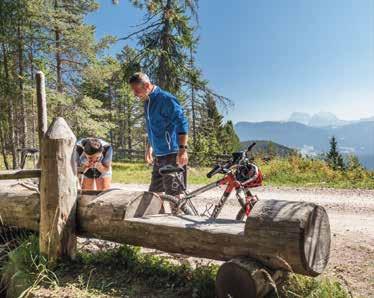
Everything is new in spring! With the snows melting and the warming rays of sunshine returning, a new era for bike tourism has begun on the Ritten, with four official mountain bike routes leading from Oberbozen and Klobenstein to the Rittner Horn. They’re wide paths with moderate inclines and descents. Although if you want, you can also climb 1,000 metres in altitude, from the cable car at Oberbozen, or the bus station in Klobenstein, to the Rittner Horn mountain refuge at 2,260 metres. One route runs from Oberbozen (mountain station of the Rittner cable car) to the Rittner Horn refuge, while a second starts at the mountain station of the Rittner Horn cable car and leads up the Schwarzseespitze to the Gasteiger Sattel, in the direction of the Villanderer Alm. Two others go from Klobenstein, the main village on the plateau, via Riggermoos and Mittelberg to Pemmern, joining the Rittner Horn route.
In the future, these four routes will provide up to eight tours, from easy to challenging (see constantly updated descriptions at www.ritten.com). The operator of these four official routes is the Ritten
Tourism Association. bm Magazine spoke to the person responsible for sustainability in tourism at Ritten, Peter Righi (see p. 77), who became the “midwife” for these new routes.
Peter, what does official MTB routes actually mean? It means that for anyone who’s taken out insurance, we now have well-signposted, constantly maintained routes. The operator of these MTB bike routes, the Ritten Tourism Association, has concluded a usage agreement with the dozen or so landowners. It’s also liable, in the event of problems or legal disputes.
And previously? Cyclists didn't just discover the Ritten yesterday?
That's right, and that's why Ritten is the only municipality in South Tyrol to have issued an ordinance that provides clarity. Biking and horse-riding is NOT allowed on trackless terrain and on steep slopes less than 1.5 metres wide. Conversely, on trails wider than 1.5 metres (the many forest trails), cycling is generally allowed.
Will there be conflicts with hikers?
The Ritten is a recreational and hiking area, with many promenades on the mountain attracting many walkers, sportspeople, excursionists and families. At the same time, the 280-kilometre network of hiking trails, spanning the Ritten and connecting the lower and higher altitudes in the alpine region, of course also lures cyclists. Overall, cycle traffic on the Ritten sunny plateau has increased significantly in recent years, and naturally, sometimes conflicts arise. So this is why we want to manage these sports and activities on the mountain via our four new routes, focusing them more on these areas. Whether hikers or bikers, there is enough space for everyone on the high plateau.
Respect on the mountain: is that an issue?
Definitely! Respect for ecosystems and equally, respect for fellow human beings, whether on foot, on a bike or in a horse saddle. On our guided bike tours, in addition to riding technique and local knowledge, we also focus on respect. In the wise words of alpinist Paul Preuß: ability is the measure of the possible.
79 REVAMIRP A / FRÜH LING / S P GNIR \
EN/ 4.©
RAUS IN DIE NATUR
Die Kraft des Frühlings steckt in den Knospen, im natürlichen Zyklus des Wiedererwachens. Wer Energie tanken will, findet diese im Wald und auf der blühenden Wiese, besonders zwischen den Lärchen am Salten – weiß die Yogalehrerin, Kräuterpädagogin und Knospenexpertin Adelheid Plattner.

80
EXPERIENCE
ich von der Natur am Tschögglberg inspirieren zu lassen ist eine gute Möglichkeit, um die neue Jahreszeit willkommen zu heißen und den Neustart zu wagen, mit viel Bewegung im Freien genauso wie auf Entdeckungstour der Geheimnisse aus der Pflanzenwelt. Die Gegend um Jenesien bietet dafür unzählige Kraft- und Schauplätze. Adelheid Plattner führt dort Interessierte auf mehrstündige Kräuterwanderungen, leitet Workshops zur Knospenkunde, bereitet Salben und Tinkturen zu, unterrichtet Yoga. Damit fing es eigentlich an, mit einem von Adelheid geleiteten Yoga-Retreat im Hotel Belvedere 2016. bm hat die moderne ” Kräuterhexe“ besucht.
Woher kommt dein Kräuterwissen?
Ich bin im Ländlichen aufgewachsen, im Sarntal und in Flaas am Salten, wo meine Oma daheim war, die Kräuterfachfrau in der Familie. In meiner Kindheit war es noch normal, bei Wehwehchen jeder Art zur Naturapotheke zu greifen. Mein Vater brachte das Wissen seiner Mutter mit in unseren Alltag, und so lebt diese Familientradition jetzt über mich weiter. Die Oma lebte mit ihren 15 Kindern als Bäuerin am Hof, nebenher rief man sie zur Totenwache, aber genauso, um bei Geburten zu helfen, obwohl sie keine ausgebildete Hebamme war. Am Berg waren erfahrene Frauen wie meine Oma, die ” Leitner-Mutter“, gefragt; der Weg in die Stadt oft zu weit. In meiner Kindheit half der Preiselbeersaft eben gegen Fieber, das Isländische Moos gegen Leberschmerzen, der Wegerich bei kleinen Wunden und der Holundertee gegen Grippe. So bin ich aufgewachsen. Eine fundierte Ausbildung habe ich erst viel später nachgeholt.
Die Verbundenheit mit natürlichen Kreisläufen ist eines deiner Lebensthemen. Wie lebst du diese aus?
Als Kind liebte ich es, Blumensträuße zu binden und viel Zeit draußen zu verbringen. Später kam

81 REVAMIRP A / FRÜH LING / S P GNIR \ DE
/ S
1.©
das Kreative dazu: Ich bastle immer noch mit Zapfen, Flechten und Kräutern. Als meine drei Kinder klein waren, haben wir über die Dekoration den Wald kennengelernt, die Blumenwiese erfahrbar gemacht. Ich könnte auch heute noch stundenlang zusehen, wie Gräser im Wind schwingen. Diese Leichtigkeit bewundere ich, auch die Details von Blumen und Knospen. Da steckt eine Welt drin, die wir mit bloßem Auge kaum wahrnehmen. Dieser Respekt vor der Pflanzenwelt ergibt sich ganz von allein, wenn man sich die Zeit für die Beobachtung von natürlichen Phänomenen und einzelnen Pflanzen nimmt. Wir müssen das Auge wieder schulen und z.B. Knospen an kleinen Details erkennen. Der Nutzen für uns Menschen kommt erst in einem zweiten Schritt mit der Kräuterheilkunde - ein Lebenselixier.
Apropos Nutzen: Du stellst auch selbst Salben, Öl- und Alkoholauszüge mit Kräutern her, auch Gemmomittel. Ich bin fasziniert von der Gemmotherapie: Schau dir einmal die Knospe einer Schwarzerle an, wie sie sich entwickelt, noch bevor sie sich öffnet. Da muss ich mehrmals hin bevor es so weit ist und ich einige weni-

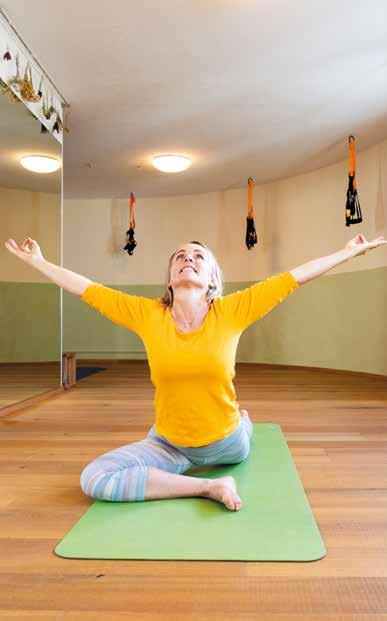

82
1.© 1.© 1.©
ge Exemplare gezielt sammle. Und dann wirkt sie auch noch – als Birkengewächs - immunsystemstärkend und entzündungshemmend. Ich verarbeite sie meist für den Eigengebrauch. Auch nasche ich bei meinen Knospen-Spaziergängen, aber dann suche ich mir besonders leckere aus wie die Knospen einer Linde. Ich mache auch gern Mazerate, Auszüge und DampfDestillate gemeinsam mit Interessierten, meist im Anschluss an die geführte Wanderung in die Natur.
Hast du Tipps für den Frühling?

Unbedingt raus in die Natur, bewusst atmen bzw. waldbaden, sich bewegen, mal langsam, mal schnell, um den Kreislauf wieder in Gang zu bringen. Wenn es
sich ergibt, ist Kneippen in einem Bach oder Trog eine gute Möglichkeit, um wieder in Schwung zu kommen. Und dann rate ich, auch das Meditative und Achtsame zu pflegen, einen Baum, einen Strauch oder eine Blume genauer zu betrachten. Yoga ist für die Beweglichkeit wichtig, ich kombiniere bestimmte Yoga-Übungen gern mit den Fünf Tibetern (8ibeter), um in Fluss zu kommen, auch um zu entschlacken. Und dann spielt die Ernährung eine große Rolle im Frühling, aber das ist wieder eine andere Geschichte.
83 REVAMIRP A / FRÜH LING / S P GNIR \
1.©
Die ”8ibeter” von und mit Adelheid Plattner werden ab Juni im Freischwimmbad von Jenesien als Kurseinheiten angeboten, für gemischte Gruppen von Gästen und Einheimischen. Nähere Infos im Tourismusverein von Jenesien und unter
GEMMOMITTEL FÜR DIE HAUSAPOTHEKE
Sie werden in der Naturheilkunde verwendet, um psychische und auch körperliche Befindlichkeiten (nicht Krankheiten!) zu behandeln. Kein Zufall, dass „ gemma “ im Lateinischen Knospe ebenso wie Juwel bedeutet. Die Gemmotherapie, auch Phythoembryotherapie genannt, benutzt dafür pflanzliches Embryonalgewebe, also frische Knospen von Bäumen und Sträuchern, denn dieser Pflanzenteil enthält im Kleinen die geballte Kraft der Pflanze (Proteine, Vitamine, Hormone, Enzyme und Aminosäuren) und soll die zelluläre Ebene im Körper ansprechen, über die alle Reparaturmechanismen laufen. Begründer ist der belgische Arzt Pol Henry (†1988), der die Kommunikation von Zellen über Proteine studierte. Gemmomittel werden im frühen Frühling mit frisch gepfückten zerkleinerten Knospen hergestellt, die in einem Gemisch von Glycerin und Alkohol wochenlang ziehen, damit die Inhaltsstoffe der Knospenteile gelöst werden. Später wird das Mazerat gefiltert und verdünnt, um es 2-3 x täglich direkt in den Mund zu sprühen, so dass es über die Mundschleimhaut aufgenommen wird.
Ein Frühlings-Gemmomittel zur Wiederbelebung der Kräfte? Z.B. mit Knospen vom Weißdorn, der Birke, des Apfelbaums, der Lärche.


84
www.jenesien.net (ar) 1.© 1.©


1.©
LA FORZA DELLA NATURA
TUTTA L’ENERGIA DI PRIMAVERA STA NEI BOCCIOLI, NEL CICLO NATURALE DEL RISVEGLIO. SE VOLETE FARE IL PIENO DI QUESTA ENERGIA, LA TROVERETE SOPRATTUTTO TRA
I LARICI DEL SALTO NEI PRESSI DI S. GENESIO.
Lasciarsi ispirare dalla natura sul Montezoccolo è un buon modo per dare il benvenuto alla nuova stagione, con tanto di attività fisica all'aperto e un tour alla scoperta dei segreti del mondo vegetale. L'area intorno al paese di San Genesio offre innumerevoli scenari adatti a queste attività. Adelheid Plattner guida le persone interessate in escursioni erboristiche, conduce workshop sulla gemmoterapia, prepara unguenti e tinture ed è anche insegnante di yoga.
Come ha acquisito la conoscenza delle erbe?
Quando ero bambina era normale rivolgersi alla ‘farmacia naturale’ (fitoterapia) per ogni tipo di dolore o ferita. La mia nonna paterna viveva con i suoi 15 figli come contadina in un maso di montagna a Flaas, frazione di San Genesio, ed era chiamata a vegliare i morti ma anche ad aiutare le partorienti, benché non avesse una formazione da ostetrica. Quando eravamo da lei o con mio padre, era il succo di mirtillo rosso ad aiutare contro la febbre, il muschio islandese contro il dolore al fegato, la piantaggine contro le piccole ferite e il tè di sambuco contro l'influenza.

Tu prepari anche unguenti, oli ed estratti alcolici, compresi i gemmoderivati. Perché ne sei affascinata?
Basta osservare la gemma di un ontano nero, per esempio, come si sviluppa ancor prima di aprirsi. Pensa che ha un effetto immunitario e antinfiammatorio. Quando è ora, ne raccolgo alcune per uso personale. Mangio boccioli durante le mie passeggiate nel bosco, scegliendoli accuratamente fra quelle particolarmente gustose, come i boccioli di un tiglio, oppure le lavoro in estratti alcolici.
Hai qualche consiglio primaverile?
Sicuramente uscire e camminare nella natura, respirare consapevolmente nel bosco, muoversi, a volte lentamente a volte velocemente, per riattivare la circolazione. Se potete, praticate anche un po’ di immersioni Kneipp in un ruscello. E poi consiglio di coltivare anche l'aspetto meditativo e mentale, ovvero osservare più da vicino un albero, un arbusto, un fiore o una gemma.
Rimedi naturali per l'armadietto dei medicinali
I gemmoderivati sono utilizzati in naturopatia per trattare condizioni psicologiche e anche fisiche (non le malattie!). Non a caso "gemma" in latino significa sia bocciolo che gioiello. Questa forma di terapia utilizza il tessuto embrionale delle piante, cioè le gemme fresche di alberi e arbusti, perché questa parte contiene il potere concentrato del vegetale. Il suo fondatore è il medico belga Pol Henry (†1988), che ha studiato la comunicazione delle cellule attraverso le proteine. I gemmoderivati vengono preparati all'inizio della primavera con gemme fresche sminuzzate, che vengono messe in infusione in una miscela di glicerina e alcol per settimane, in modo da scioglierne gli ingredienti.
In seguito, il macerato viene filtrato e diluito per essere spruzzato direttamente in bocca 2-3 volte al giorno, in modo che venga assorbito attraverso la mucosa orale.
Un rimedio primaverile di gemme per ravvivare la propria forza? Ad esempio con le gemme del biancospino, della betulla, del melo e del larice.
A me piace combinare alcuni esercizi di yoga con i Cinque Riti Tibetani (8ibeter) e farlo all’aperto.
Gli "8ibeter" di e con Adelheid Plattner verranno praticati nella piscina all'aperto di S. Genesio a partire da giugno, per gruppi misti di ospiti e locali. Per maggiori informazioni, contattare l'ufficio turistico e visitare il sito
86
IT/ 1.©
www.jenesien.net
INTO THE OUTDOORS
THE FORCE OF SPRING IS IN THE BUDDING REBIRTH, IN THE NATURAL CYCLE OF REAWAKENING. IT’S ESPECIALLY AMONG THE LARCHES ON THE SALTEN THAT YOU’LL RECHARGE AND REPLENISH YOURSELF.
To welcome the new season on the Tschögglberg is to be inspired by nature, with plenty of outdoor exercise and tours to discover the secrets of the plant kingdom. Around Jenesien, there are countless scenic places of strength. Adelheid Plattner leads the curious on herb hikes lasting several hours, she conducts workshops on plant lore, prepares ointments and tinctures, and teaches yoga.
How did you come by your knowledge of herbs? When I was little, it was still normal to look to the “natural pharmacy” for aches and pains of any kind. My grandmother was a farmer's wife who lived with her 15 children on the farm. She was called upon to watch over the dead, but also to help with births, even though she wasn’t a trained midwife. For her, cranberry juice helped against fever, Icelandic moss against liver pain, plantain against small wounds and elderflower tea against the flu. That's how I grew up.
You also make ointments, oil and alcohol extracts yourself, including Gemmotherapy remedies. Where does the fascination come from?

Just look at the bud of a black alder, how it develops even before it opens. It has its own immune system booster and anti-inflammatory effect. I process buds mostly for my own use. I also snack on them during my bud walks, but then I pick particularly tasty ones like the buds of a lime tree.
Gemmotherapy remedies for the medicine cabinet
These are used in naturopathy to treat psychological and also physical conditions (not diseases!). It is no coincidence that gemma in Latin means bud, as well as jewel. This form of therapy uses plant embryonic tissue, i.e. the fresh buds of trees and bushes, because this part of the plant contains the concentrated power of the plant in miniature. The founder was the Belgian physician Pol Henry (d. 1988), who studied the communication of cells via proteins.
Gemmotherapy remedies are made in early spring with freshly picked crushed buds that steep in a mixture of glycerine and alcohol for weeks, so that the constituents of the bud parts are dissolved. Afterwards, this is filtered and diluted, to be sprayed directly into the mouth 2-3 times a day, so that it’s absorbed through the oral mucus membrane.
A spring Gemmotherapy remedy to revive the forces? Buds of hawthorn, birch, apple tree and larch, for example.
Do you have any spring tips?
Definitely get out into nature, breathe consciously or go forest bathing. Move, sometimes slowly, sometimes quickly, to reinvigorate the circulation. If the opportunity arises, Kneipp therapy in a stream or trough is a good way to get going again. I’d also advise cultivating the meditative and mindful, to take a closer look at a tree, a shrub or a flower. I like to combine certain yoga exercises with the Five Tibetans Rites (8ibeters).
The "8ibeter" are courses with Adelheid Plattner offered from June in the outdoor swimming pool of Jenesien, for mixed groups of visitors and locals. Find more information from the tourist office of Jenesien and under
www.jenesien.net
87 REVAMIRP A / FRÜH LING / S P GNIR \
EN/ 1.©
BAHNHOF BOZEN

Als wichtiger Verkehrsknotenpunkt auf der Nord-Süd-Achse der Brennerbahn, verbindet er Innsbruck mit Verona. Das ist seine Funktion, mit 5,5 Millionen Fahrgäste jährlich. Für viele ist er nur Durchgangsort und Warteschleife, doch ein Blick auf Geschichte und Architektur lohnt sich.
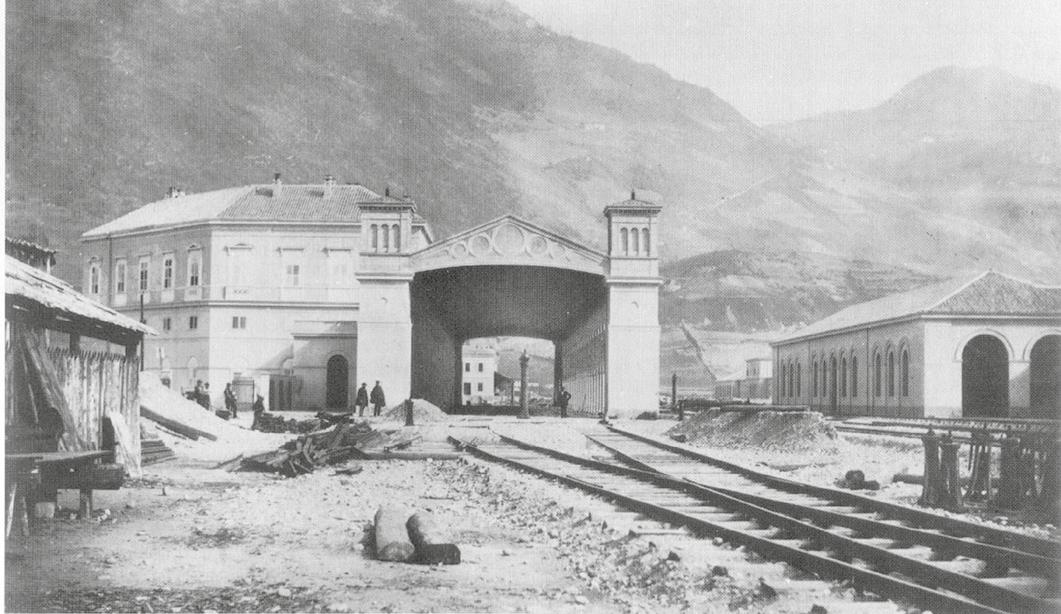
88
1859 1928 33.© 34.©
Er liegt geschickt und fußläufig, sehr zentral im Nordosten des Bozner Talkessels zwischen der Altstadt und dem Flussbett des Eisacks. Gegenüber steht das Regierungs- und Landhausviertel, mit dem Gebäude des Südtiroler Landtags und mit Palais Widmann, jenem der Landesregierung. In der Nähe befinden sich sehr viele Landesämter und auch das Bozner Rathaus mit den meisten Gemeindeämtern.
In Betrieb genommen wurde die k.u.k. Brennerbahn und das Bozner Bahnhofsgebäude 1859, mit dem ersten Zugstrecken-Abschnitt von Verona durch das Etschtal nach Bozen. Die Strecke zwischen Bozen und Innsbruck wurde 1867 eröffnet, jene von Bozen nach Meran folgte 1881. In der ersten Hälfte des 20. Jahrhunderts gab es als Anbindung zum städtischen Nahverkehr eine Straßenbahn. Selbst der Ritten war über eine Tram- und steile Standseilbahn (bis 1966) verbunden. Nun halten internationale EuroCity-Fernverkehrszüge, die Italien mit Österreich und Deutschland verbinden. Über die Hochgeschwindigkeitszüge Frecciargento bestehen rasche Verbindungen Richtung Rom. Von hoher Bedeutung ist der Bahnhof Bozen als Vollknoten im regionalen Taktfahrplan; der Schienennahverkehr wird dabei durch Züge von Trenitalia sowie von SAD abgewickelt.
Heute steht das großstädtische Empfangsgebäude des Bozner Bahnhofs unter Denkmalschutz. Es wurde vom altösterreichischen Trentiner Luigi Negrelli, ein führender Architekt seiner Zeit, im Stil des Wiener Neoklassizismus entworfen (er plante später das Suezkanalprojekt), 1928 wurde es während des Faschismus vom römischen Architekten Angiolo Mazzoni umgestaltet (Fassade mit vorgeblendetem Säulenentree und auch der markante Turm). Während des Zweiten Weltkriegs wurde es mehrmals bombardiert und stark beschädigt, doch rasch wieder aufgebaut. Seit Jahren sind Pläne zur Neugestaltung und Neubebauung großer, mittlerweile brach liegender, Teile des Bahnhofsgeländes im Gespräch.
Die bewegte Brennerbahn-Geschichte wird in den Wartesälen auf Bahnsteig 3 und 4 in einer Ausstellung des Kuratoriums für Technische Kulturgüter im doppelten Sinn beleuchtet, einmal inhaltlich, einmal weil sie auch in den Nachtstunden als Leuchtkörper im Bahnhofsareal auffällt.
Bahnhofsgebäude am Bahnhofsplatz, 3 Gehminuten vom zentralen Waltherplatz (ar)
LA STAZIONE FERROVIARIA DI BOLZANO
Come importante nodo di trasporto sull'asse nord-sud della ferrovia del Brennero, essa collega Verona a Innsbruck, con ca. 5,5 milioni di passeggeri all'anno. In funzione dal 1859 sia la ferrovia, allora austro-ungarica, che l’edificio della stazione ferroviaria di Bolzano, furono progettati da Luigi Negrelli, architetto di spicco dell’epoca. Nel 1928 fu ampliata e ridisegnata dall’architetto romano Angiolo Mazzoni; durante la Seconda Guerra Mondiale fu bombardata più volte e riportò gravi danni, ma venne rapidamente ricostruita. Da anni si discute di riprogettare e riqualificare ampie zone dell’areale stazione.
BOLZANO RAILWAY STATION
As an important transport hub on the northsouth axis of the Brenner railway, it connects Verona to Innsbruck, with around 5.5 million passengers per year. In operation since 1859, both the then Austro-Hungarian railway and the Bolzano railway station building were designed by Luigi Negrelli, a leading architect of the time. In 1928 it was extended and redesigned by the Roman architect Angiolo Mazzoni, and during World War II it was bombed several times and severely damaged, but quickly rebuilt. For years, there have been discussions about redesigning and redeveloping large areas of the station area.
89 REVAMIRP A / FRÜH LING / S P GNIR \ INSIDE OUTSIDE
DE/


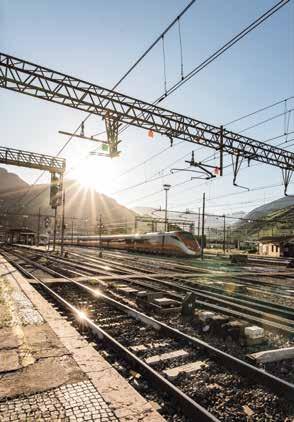
90 1.©
35.© 35.©
EVENTS BOLZANO/BOZEN
VISITE GUIDATE STADTFÜHRUNGEN GUIDED TOURS
L’Azienda di Soggiorno e Turismo di Bolzano propone un ricco programma di visite guidate della città e dei suoi dintorni, alla scoperta delle principali attrazioni storico-artistiche. Il programma è disponibile presso l’Ufficio Informazioni.
Auf Entdeckung gehen: Das Verkehrsamt Bozen bietet ein dichtes Programm an geführten Rundgängen zu den wichtigsten kunsthistorischen Schätzen der Stadt Bozen. Das Programm-Heft ist im Informationsbüro erhältlich.
The Tourism Board of Bolzano Bozen organizes a rich programme of guided walking tours of the historic town.

INFO:
Azienda di Soggiorno e Turismo
Verkehrsamt Bozen - Tourism Board, via Alto Adige / Südtiroler Straße 60
T. +39 0471 307 000
www.bolzano-bozen.it
PROGRAMMI SPETTACOLI TEATRALI E CONCERTI
THEATER- UND KONZERTPROGRAMME
THEATRE PERFORMANCES & CONCERTS
www.konzertverein.org
www.kulturinstitut.org
www.theater-bozen.it
www.teatrocomunale.bolzano.it
www.teatrocristallo.it
www.carambolage.org
www.teatro-bolzano.it

www.theaterimhof.it
www.haydn.it
91 REVAMIRP A / FRÜH LING / S P GNIR \
1.© 36.©
EVENTS BOZEN/BOLZANO




Scannen Sie den QR-Code, um in unserem Online-Veranstaltungskalender mit allen Aktualisierungen zu stöbern.

Consulti il nostro calendario degli eventi con tutti gli aggiornamenti scansionando questo codice.
View our events calendar with all updates by scanning this code.
www.bolzano-bozen.it


92
10.©
1.©
1.©
1.©
8.©
EVENTS SARNTAL/VAL SARENTINO
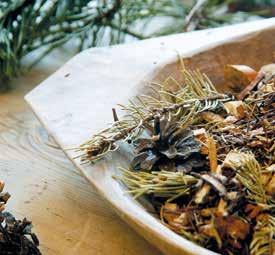



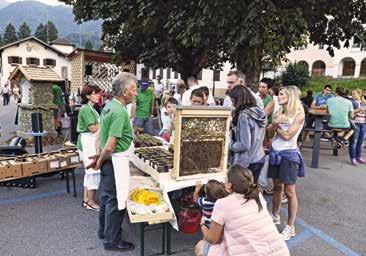

Scannen Sie den QR-Code, um in unserem Online-Veranstaltungskalender mit allen Aktualisierungen zu stöbern.

Consulti il nostro calendario degli eventi con tutti gli aggiornamenti scansionando questo codice.
View our events calendar with all updates by scanning this code.
www.sarntal.com
93 REVAMIRP A / S P GNIR \
9.©
38.© 37.© 9.©
9.©
26.©
EVENTS RITTEN/RENON


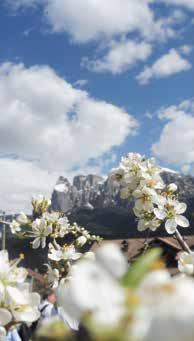


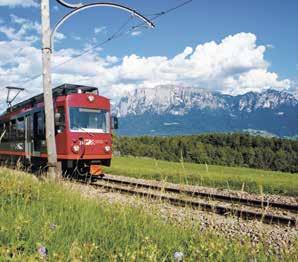
Scannen Sie den QR-Code, um in unserem Online-Veranstaltungskalender mit allen Aktualisierungen zu stöbern.
Consulti il nostro calendario degli eventi con tutti gli aggiornamenti scansionando questo codice.
View our events calendar with all updates by scanning this code.
www.ritten.com

94
40.©
8.©
4.©
39.©
32.©
4.©
EVENTS EPPAN/APPIANO


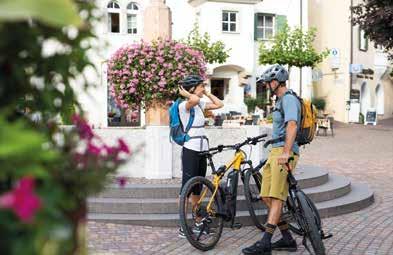



Scannen Sie den QR-Code, um in unserem Online-Veranstaltungskalender mit allen Aktualisierungen zu stöbern.

Consulti il nostro calendario degli eventi con tutti gli aggiornamenti scansionando questo codice.
View our events calendar with all updates by scanning this code.
www.eppan.com
95 REVAMIRP A / S P GNIR \
42.© 42.©
25.©
25.© 44.©
45.©
EVENTS JENESIEN/SAN GENESIO


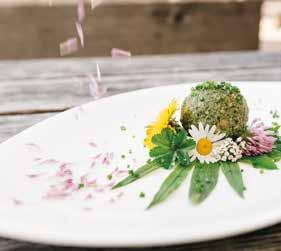



Scannen Sie den QR-Code, um in unserem Online-Veranstaltungskalender mit allen Aktualisierungen zu stöbern.
Consulti il nostro calendario degli eventi con tutti gli aggiornamenti scansionando questo codice.
View our events calendar with all updates by scanning this code.
www.jenesien.net

96
46.© 47.©
47.©
47.© 46.©
47.©
EVENTS LEIFERS/LAIVES






Scannen Sie den QR-Code, um in unserem Online-Veranstaltungskalender mit allen Aktualisierungen zu stöbern.

Consulti il nostro calendario degli eventi con tutti gli aggiornamenti scansionando questo codice.
View our events calendar with all updates by scanning this code.
www.suedtirols-sueden.info/de/leifers/
97 REVAMIRP A / S P GNIR \
48.©
48.© 22.©
44.©
48.©
48.©
Das nächste bm Heft – die Sommerausgabe - erscheint Anfang Juni 2023. Darin erwarten Sie Eindrücke der Bozner Gewässer – Flusswelten mit ihrem Ökosystem, ihrer Schönheit und ihrem Freizeitwert. Außerdem Kunsthandwerk, Gartenkultur und jede Menge Ausflugtipps im weniger bekannten kühlen Nass der Berge rund um die Landeshauptstadt.
Il prossimo bm – ovvero l’edizione estiva - esce i primi di giugno 2023, e vi troverete impressioni e riflessioni sulle acque di Bolzano - mondi fluviali con il loro ecosistema, la loro bellezza e il loro valore ricreativo. Inoltre… arti e mestieri, cultura, l’orto e il giardino urbano e tanti consigli per escursioni tra le fresche acque montane meno conosciute intorno al capoluogo.
Our next issue of bm Magazine - the summer edition – is available at the beginning of June 2023. We’ll be focusing on Bolzano’s waterways – its river worlds and ecosystems, their beauty and their recreational value. Accompanying this, tips for excursions in the lesser-known cool waters of the mountains around the provincial capital, the city’s arts, crafts and garden culture
bm
Bolzano Bozen Magazine
Registrazione al Tribunale di Bolzano
Registereintragung Landesgericht Bozen
Nr. 11/99 - 19.7.1999
Edition: 8.000 bm 1/2023
Online-Magazine: www.bolzano-bozen.it facebook: @visitbolzanobozen
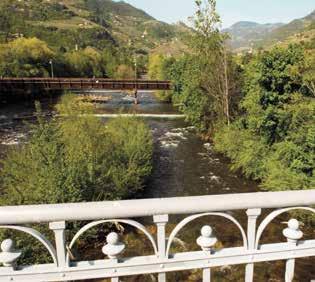
instagram: @bolzanobozen
Editor
Azienda di Soggiorno Bolzano
Verkehrsamt Bozen
Tourist Board Bolzano
via Alto Adige 60 – 39100 Bolzano
Südtiroler Straße 60 – 39100 Bozen
Tel. +39 0471 307000
info@bolzano-bozen.it
www.bolzano-bozen.it
Managing Editor
Roland Buratti
Director
Anita Rossi
Editorial staff
Anita Rossi (ar), Raoul Melotto (rm), Roberta Agosti, Elena Cortese, Martina Spinell, Monika Hellrigl, Doris Wieser, Martina Gamper, Evi Innerhofer, Nina Walterscheid-Müller, Walter Perkmann, Verena Gamper
Layout & art design
ma.ma promotion
Marion Maier, Valentina Cincelli
Photography
Manuela Tessaro
Translation
Peter Brannick (pb)
QUIZ: Soluzione da pagina 9
c) Certo, Ötzi è una delle mummie più antiche del mondo e, altrettanto vero, la sua conservazione naturale e mummificazione nel ghiacciaio rappresentano un evento eccezionale. Ma molto più importante ancora: l’“Uomo venuto dal ghiaccio”, con il suo equipaggiamento e abbigliamento, si è rivelato un inestimabile vettore d’informazioni riguardanti la vita quotidiana di oltre 5000 anni fa. www.iceman.it
Oltre al Museo Archeologico dell’Alto Adige a Bolzano si possono visitare: il Museo di Scienze Naturali dell’Alto Adige, il Museo civico, il Museo della Scuola, il Museo Mercantile, il Museion – Museo d’Arte Moderna e Contemporanea, e il Tesoro del Duomo di Bolzano.
Print
Fotolito Varesco Alfred GmbH, Auer-Ora
Foto Credits
Cover: Manuela Tessaro
1.© Manuela Tessaro; 2.© VKE; 1.© Manuela Tessaro; 3.© SMG-Alex Filz; 4.© Tourismusverein Ritten/Tiberio Sorvillo; 5.© Associazione Klosterarbeiten;
6.© TV/HGV Jenesien; 7.© ETM Oliver Timmermann;
8.©luca Guadagnini - lineematiche; 9.© Alberto Campanile;
10.© SMG-Alex Filz; 11.© Südtiroler Archäologiemuseum/foto-dpi.com;
12.© Martin Mussner; 13.© Giada Tuffanelli; 14.© Asia De Lorenzi;
15.© Daniele Fiorentino; 16. ©Verkehrsamt/Veloflora;
17.© Verkehrsamt Bozen/Azienda di Soggiorno e Turismo Bolzano;
18.© Philipp von Saalfeld; 19.© Hotel Restaurant Laurin; 20.© Elisa Biscardi; 21.©TV Leifers/Tiberio Sorvillo; 22.©TV Leifers/Laives; 23.©Loris Bregolato 2019; 24.© Mattia Mele; 25.© Tourismusverein Eppan/Associazione turistica Appiano; 26.© Trehs_Sarner Latsche/Bad Schörgau; 27.© Eschgfeller;28.©Oberhölller; 29.© Ollerhond-Selbergmochts; 30.©TV Sarntal-Michael; 31.© Peter Righi; 32.© Achim Meurer; 33.© O. Zoeggeler, L. Ippolito, Tappeiner Verlag; 34.© 1959_cr_Museo Correr Venedig; 35.© STA / Manuela Tessaro; 36.© O. Seehauser; 37.© Oscar Morandi; 38.© TV Sarntal-Michael Lange; 39.© Tourismusverein Ritten/Sophie Pichler; 40.© Tourismusverein Ritten Foto Katharina Bauer; 42.©Helmuth Rier; 43.©www.andreasmarini.carbonmade.com; 44.©tiberio Sorvillo; 45.© www.fotografielafogler.it; 46.© Michael Guggenberg; 47.© GTourismusverei Jenesien/Associazione turistica S.Genesio; 48.© Klorz Andrew; 49.© Luca Ognibeni
Graphic elements: Designed by Freepik
98

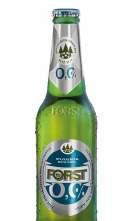
 Via Galvani Straße 29, Bolzano Sud / Bozen Süd
Via Galvani Straße 29, Bolzano Sud / Bozen Süd



















































































































































































 Via Galvani Straße 29, Bolzano Sud / Bozen Süd
Via Galvani Straße 29, Bolzano Sud / Bozen Süd